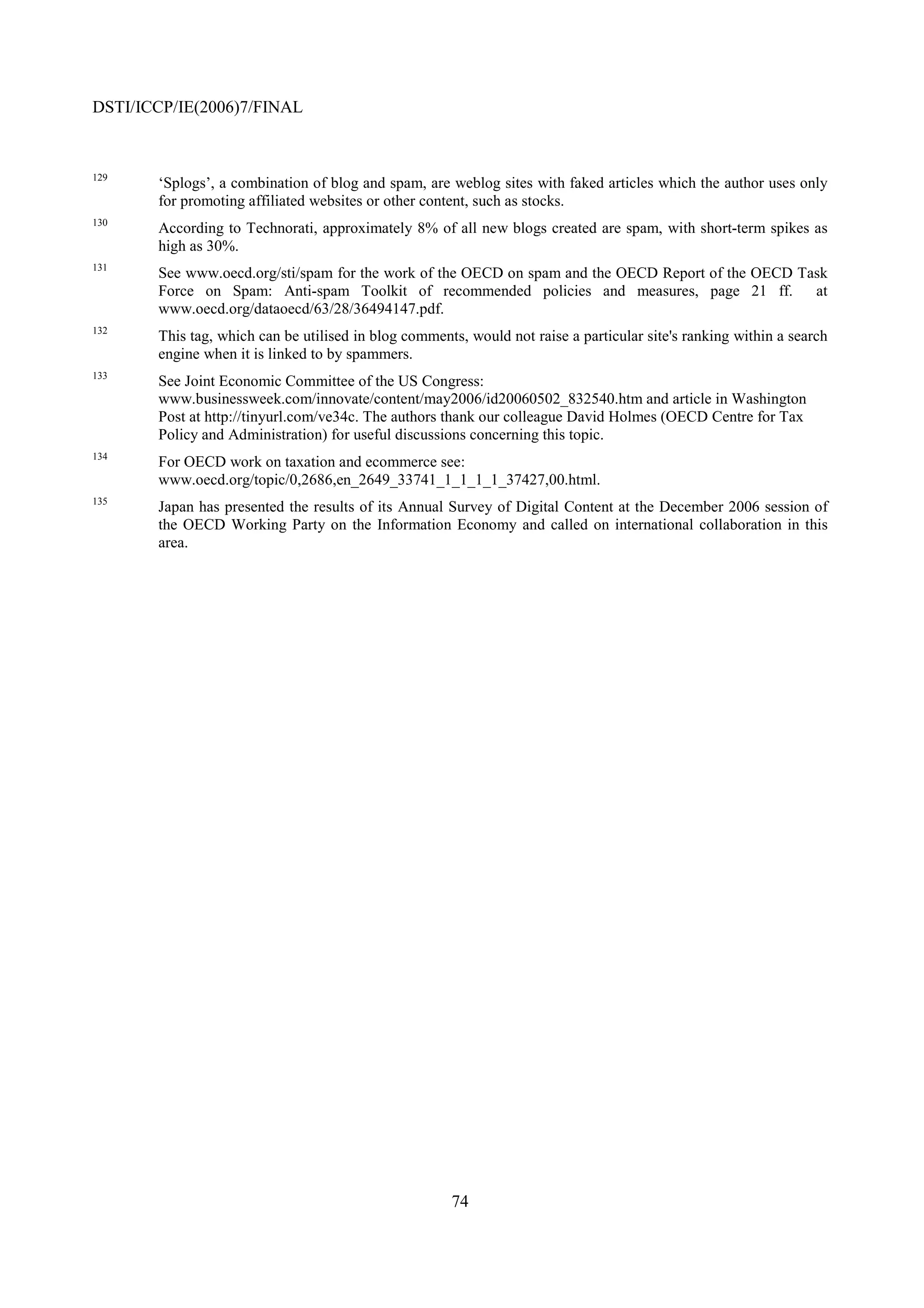User-created content (UCC) refers to content made publicly available over the Internet which reflects a creative effort and is created outside of professional routines and practices. UCC has grown rapidly due to technological drivers like broadband adoption and new web technologies, as well as social and economic drivers. UCC takes many forms across different platforms and is motivated mostly by non-commercial factors like connecting with others. Emerging business models around UCC range from voluntary contributions to advertising-based models. While UCC is still in early stages, it is already disruptive and presents opportunities and challenges for traditional media, users, businesses, and policymakers regarding issues like intellectual property, privacy, and regulation.
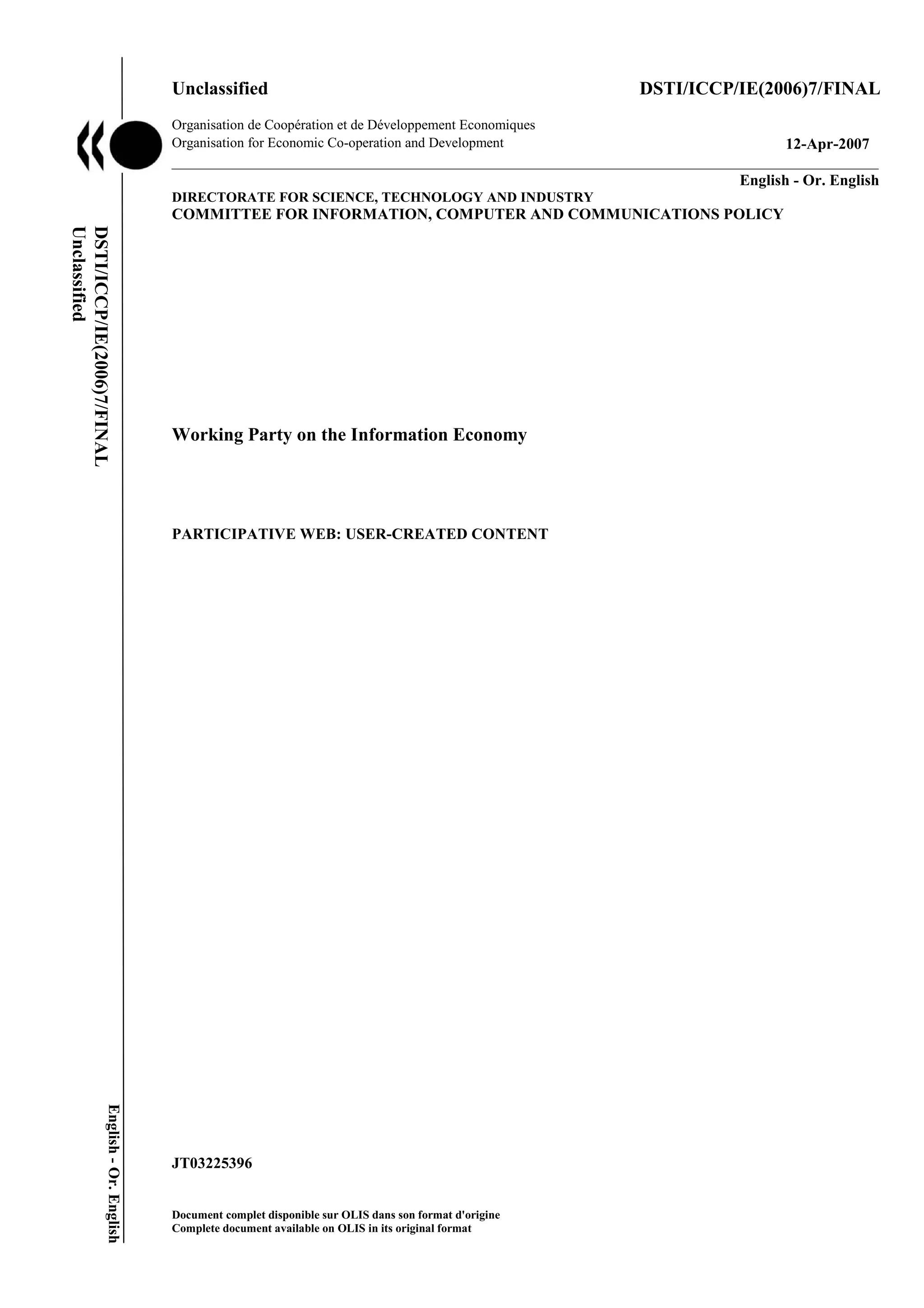
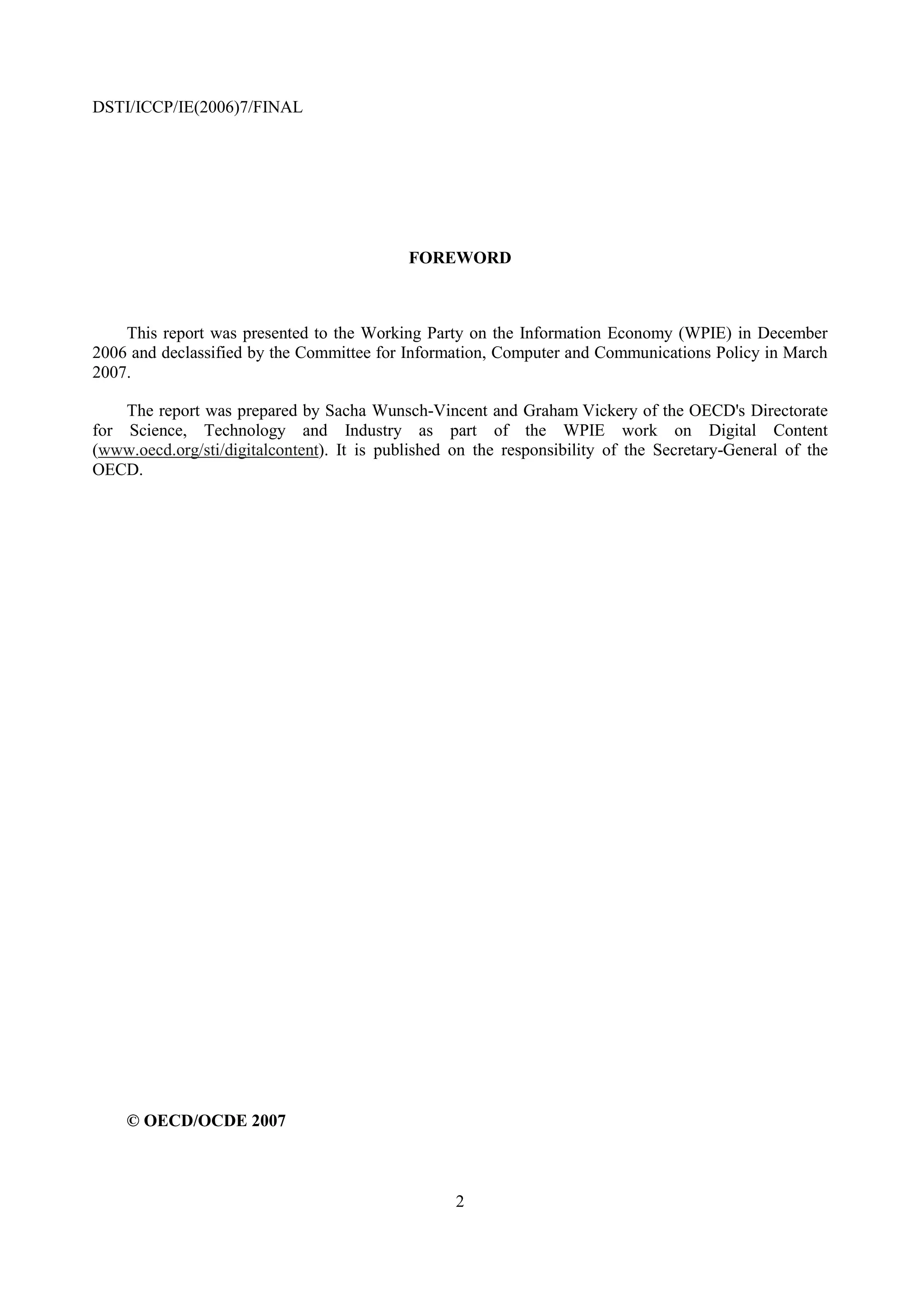
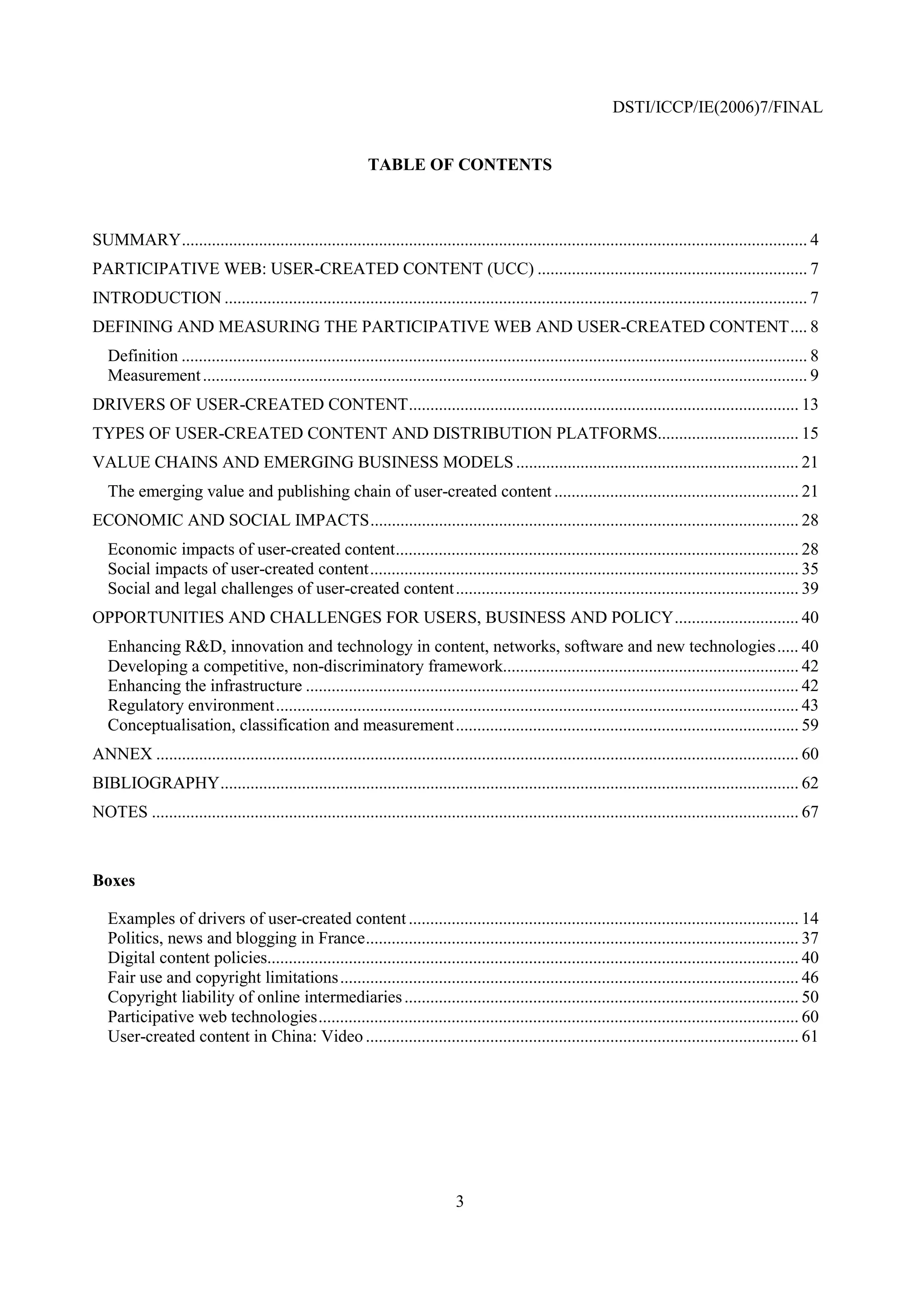

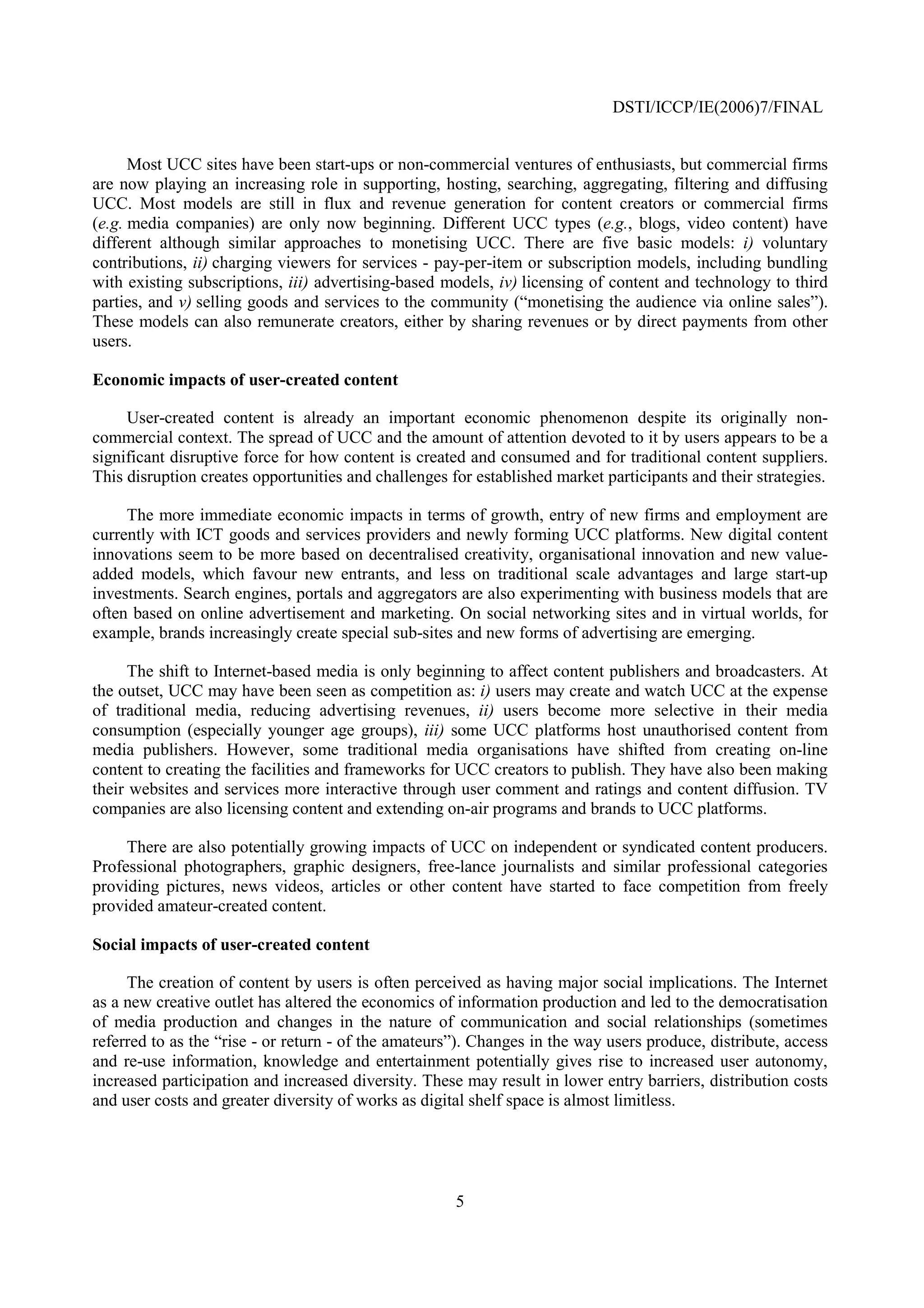
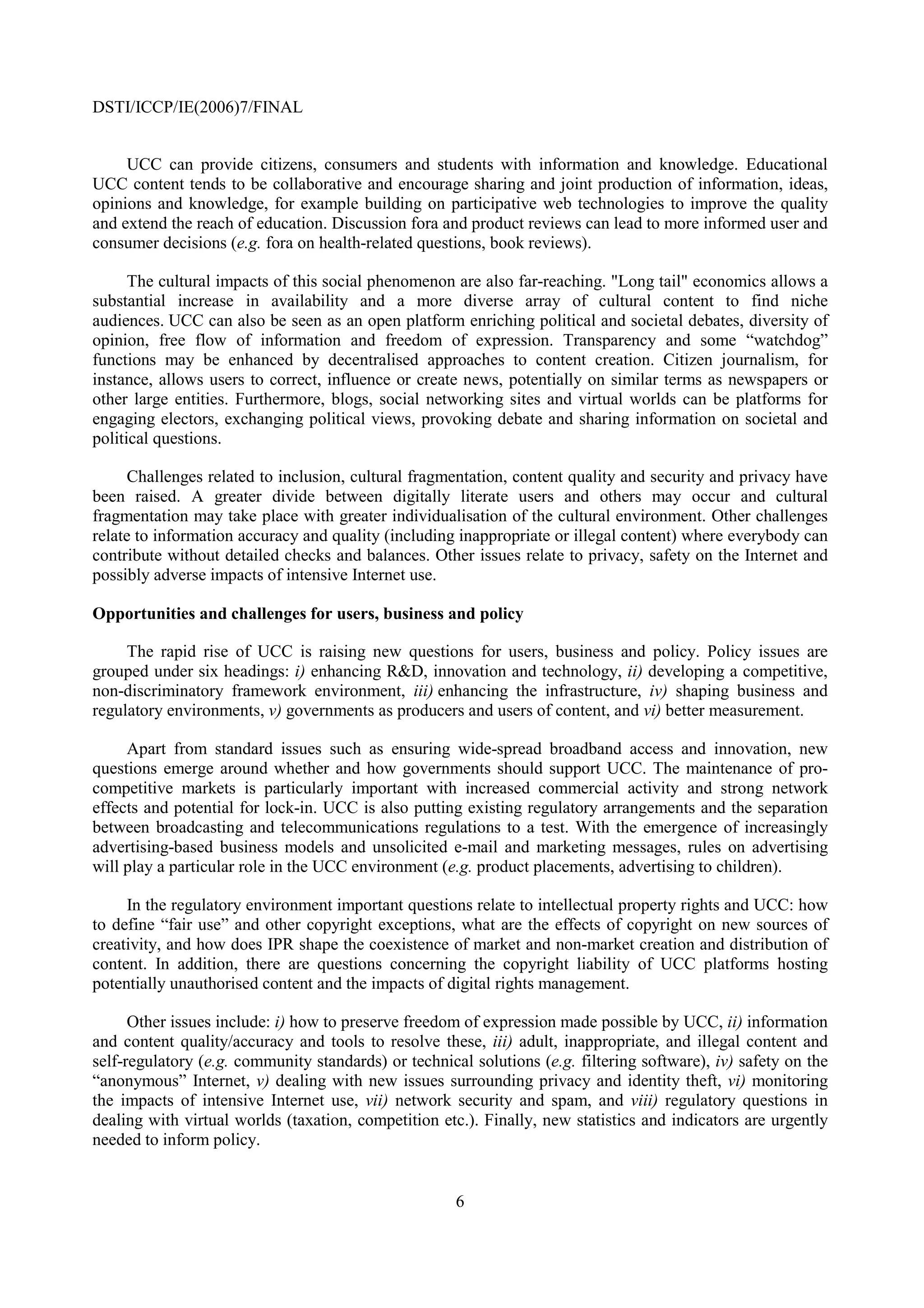

![DSTI/ICCP/IE(2006)7/FINAL
DEFINING AND MEASURING THE PARTICIPATIVE WEB AND
USER-CREATED CONTENT
Definition
The use of the Internet is characterised by increased participation and interaction of Internet users who
use it to communicate and express themselves. The most prominent concept to describe this evolution
which uses the Internet’s inherent capabilities more extensively is called “participative web”. It represents
an Internet increasingly influenced by intelligent web services based on new technologies empowering the
user to be an increasing contributor to developing, rating, collaborating and distributing Internet content
and developing and customising Internet applications (O’Reilly, 2002, 2005; MIC, 2006; OECD, 2006b).
These new web tools are said to enable commercial and non-commercial service providers to better harness
the “collective intelligence” of Internet users, using information and knowledge embedded in the Web in
the form of data, metadata, user participation and creating links between these. One characteristic of the
participative web is also the communication between users and between different separate software
applications via open web standards and web interfaces.
The rise of user-created content (UCC) (French: “contenu auto-créé”) or the so-called “rise of the
4
amateur creators” is one of the main features of the so-called participative web. This comprises various
forms of media and creative works (written, audio, visual, and combined) created by Internet and
technology users. Despite frequent references to this topic by media and experts, no commonly agreed
5
definition of user-created content exists. Also referred to as “user-generated” content, sources such as
Wikipedia refer to it as “on-line content that is produced by users [i.e. non-media professionals (i.e.
“ordinary people”)] as opposed to traditional media producers such as broadcasters and production
companies. […]”.6 A central aspect is also that users recommend and rate content.
To have a more solid understanding of UCC, it is useful to agree on the characteristics of user-created
content (i.e. an indication of what is UCC and what is not). Three central characteristics are proposed.
UCC, however, is hard to define and based on criteria which are likely to evolve in time. As such these
characteristics lay the ground only for identifying a possible spectrum of UCC.
• Publication requirement: While theoretically UCC could be made by a user and never actually
be published online or elsewhere, we focus here on the work that is published in some context, be
it on a publicly accessible website or on a page on a social networking site only accessible to a
select group of people (i.e. fellow university students). This is a useful way to exclude email,
bilateral instant messages and the like.
• Creative effort: This implies that a certain amount of creative effort was put into creating the
work or adapting existing works to construct a new one; i.e. users must add their own value to the
work. The creative effort behind UCC often also has a collaborative element to it, as is the case
with websites which users can edit collaboratively. For example, merely copying a portion of a
television show and posting it to an online video website (an activity frequently seen on the UCC
sites) would not be considered UCC. If a user uploads his/her photographs, however, expresses
his/her thoughts in a blog, or creates a new music video this could be considered UCC. Yet the
minimum amount of creative effort is hard to define and depends on the context.
• Creation outside of professional routines and practises: User-created content is generally
created outside of professional routines and practices. It often does not have an institutional or a
commercial market context. In the extreme, UCC may be produced by non-professionals without
the expectation of profit or remuneration. Motivating factors include: connecting with peers,
achieving a certain level of fame, notoriety, or prestige, and the desire to express oneself.
8](https://image.slidesharecdn.com/participativewebusercreatedcontentoecdapril2007-100528121116-phpapp02/75/Participative-web-user-created-content-oecd-april-2007-8-2048.jpg)

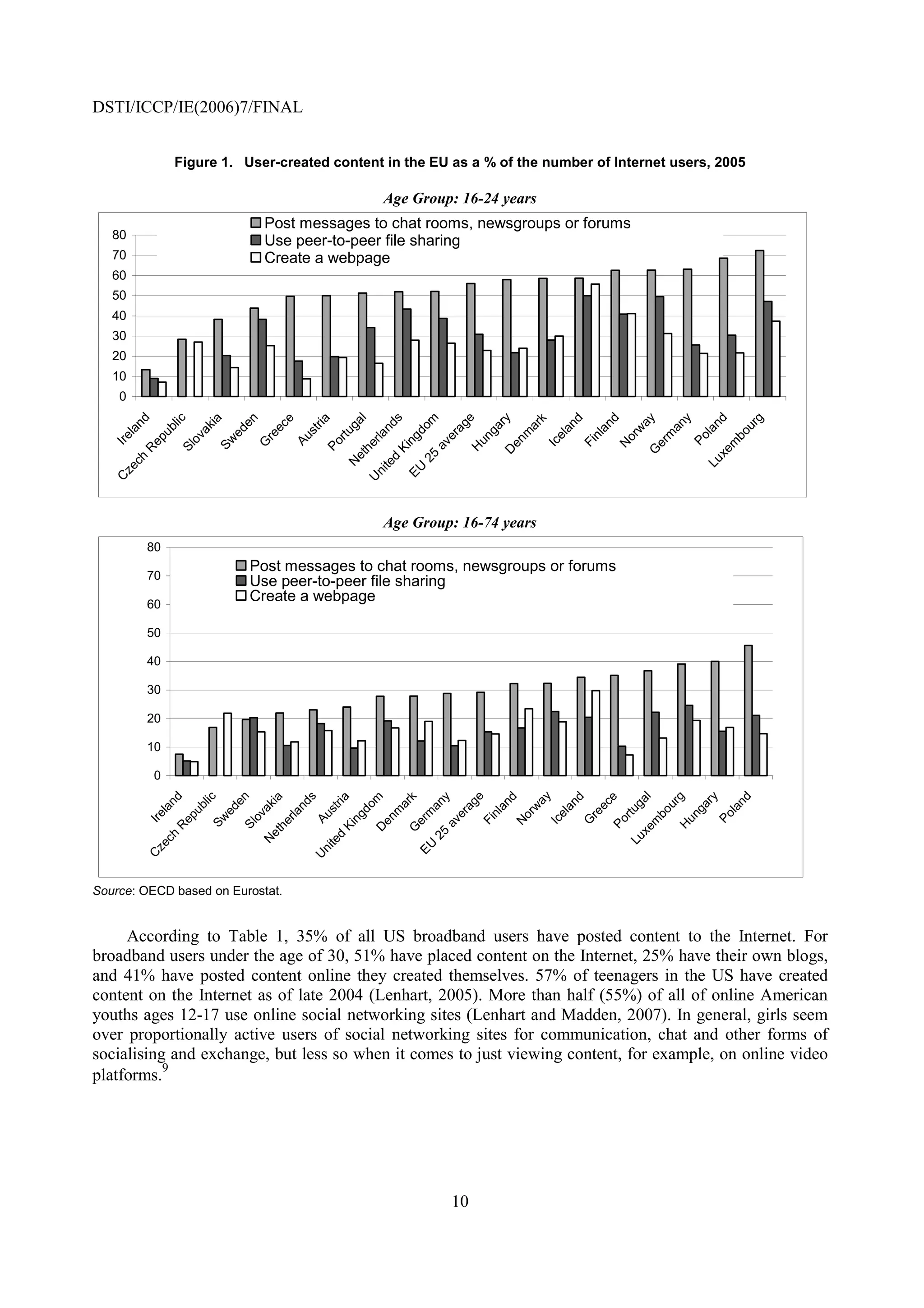
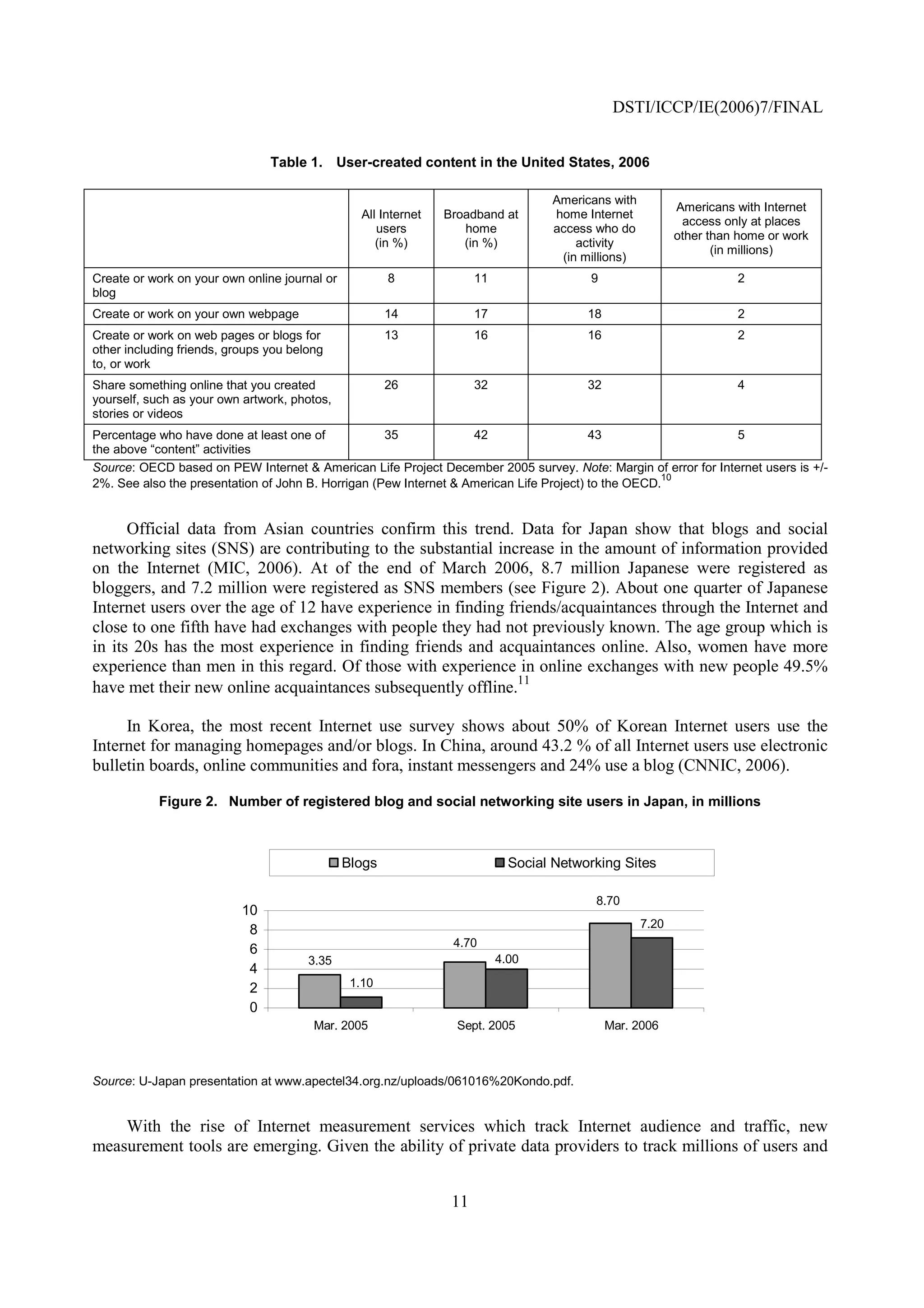
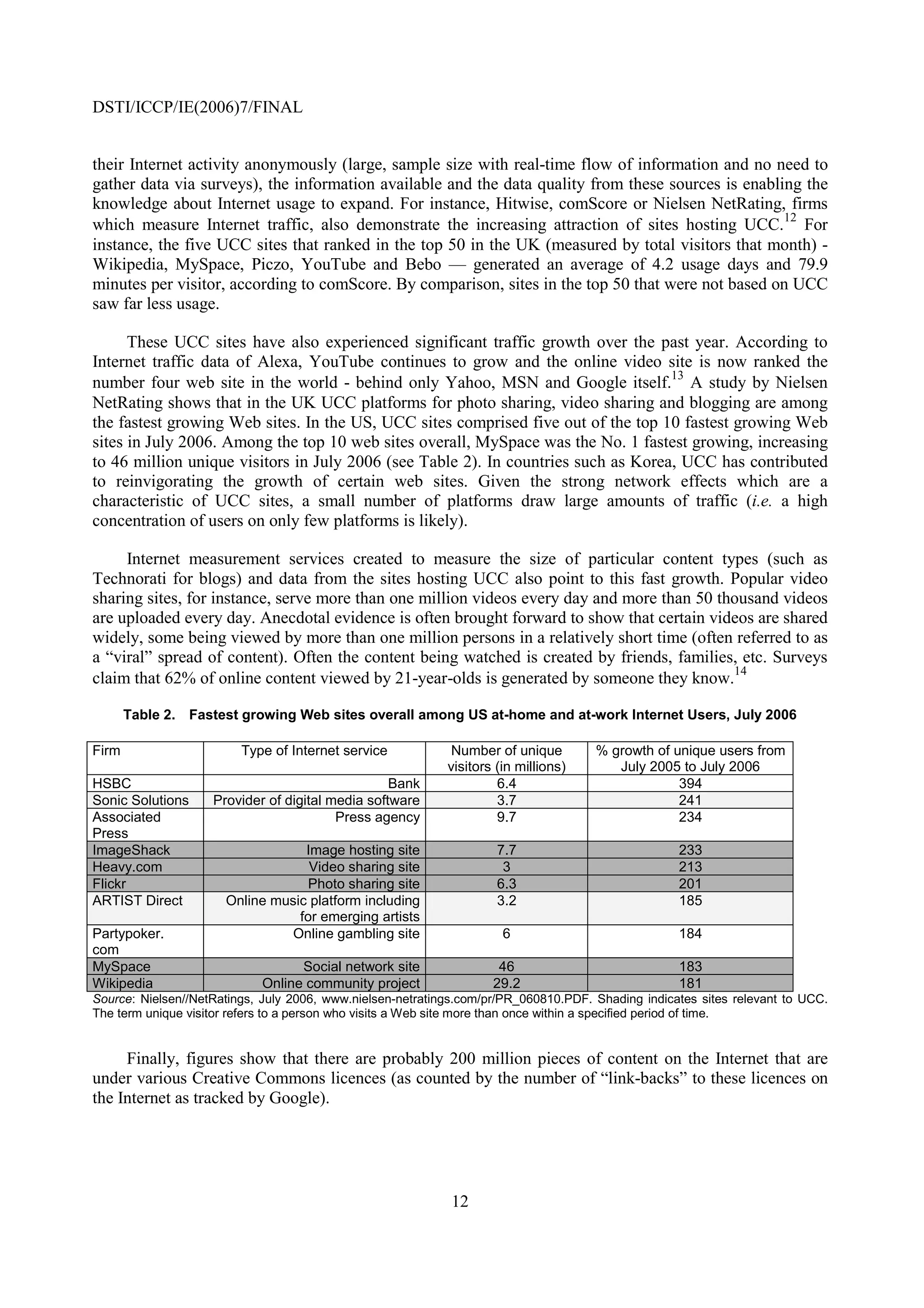
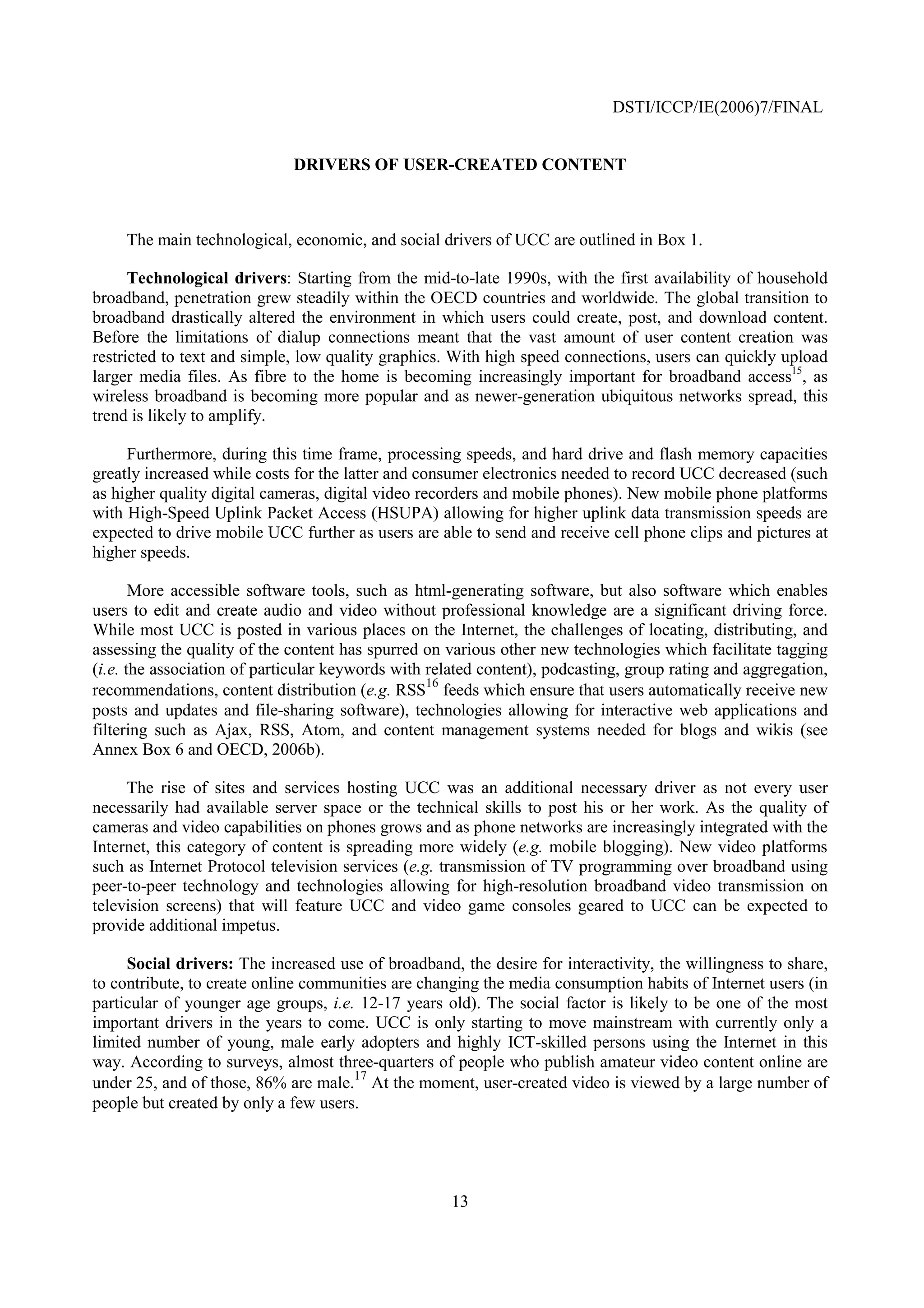
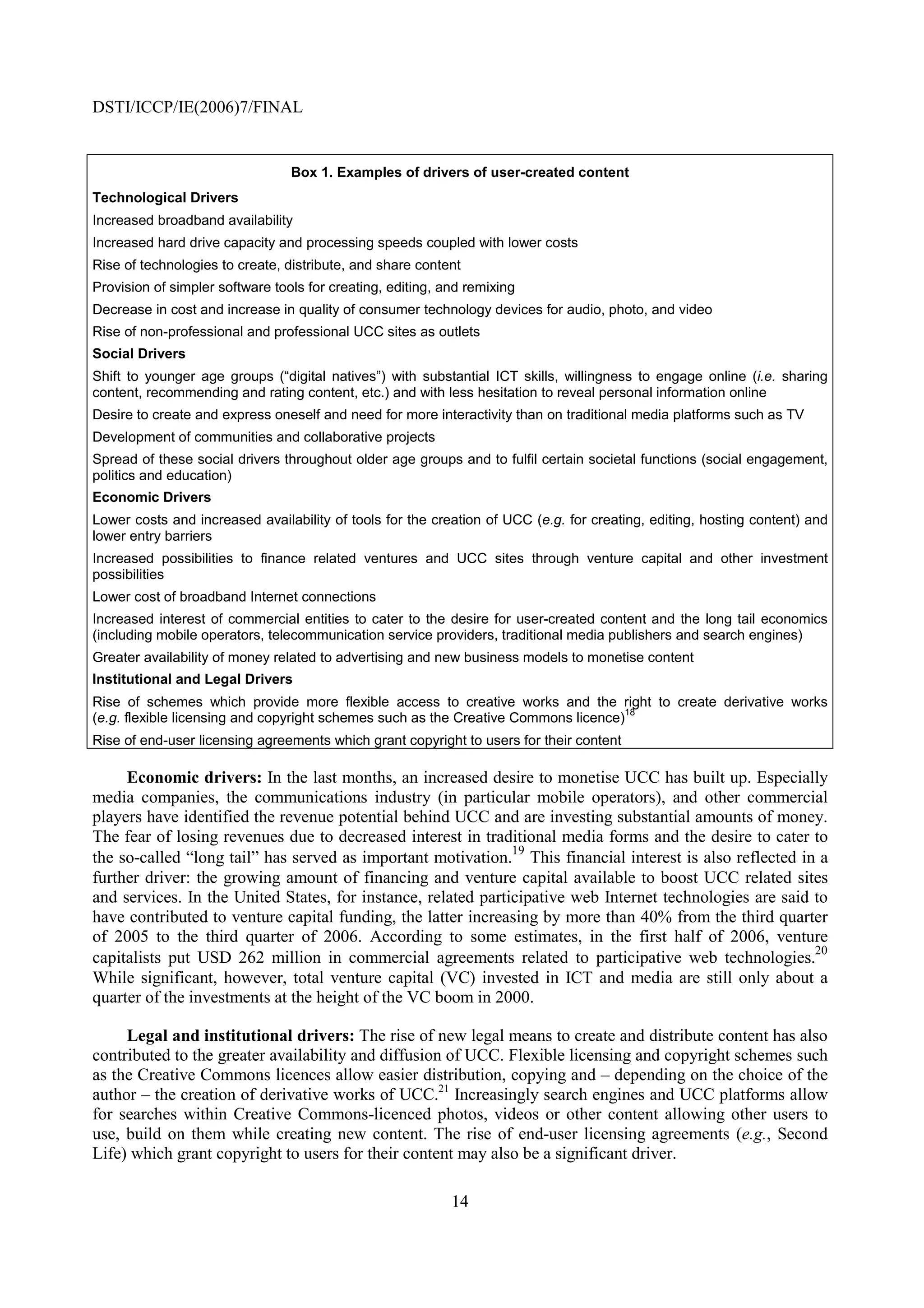
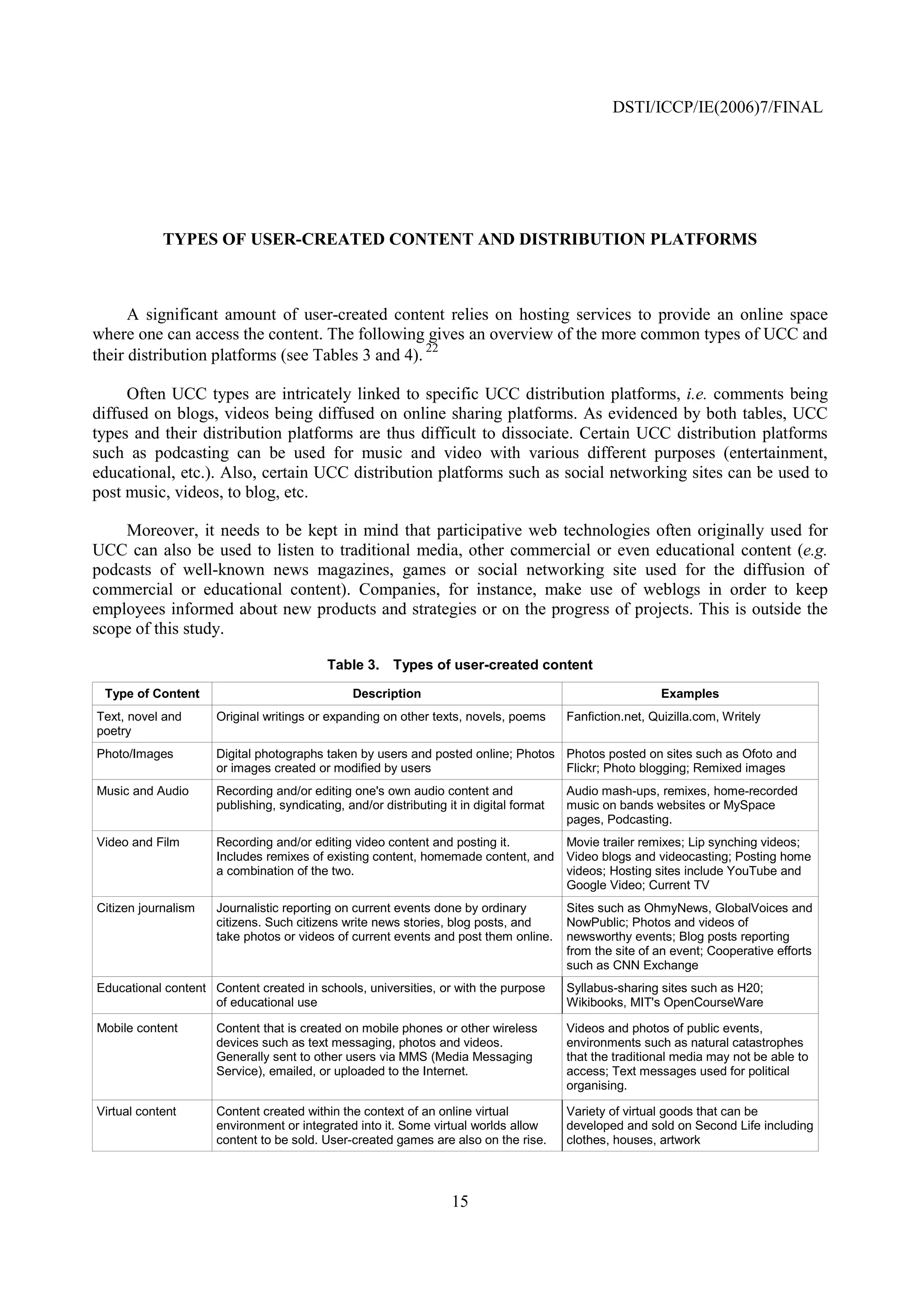
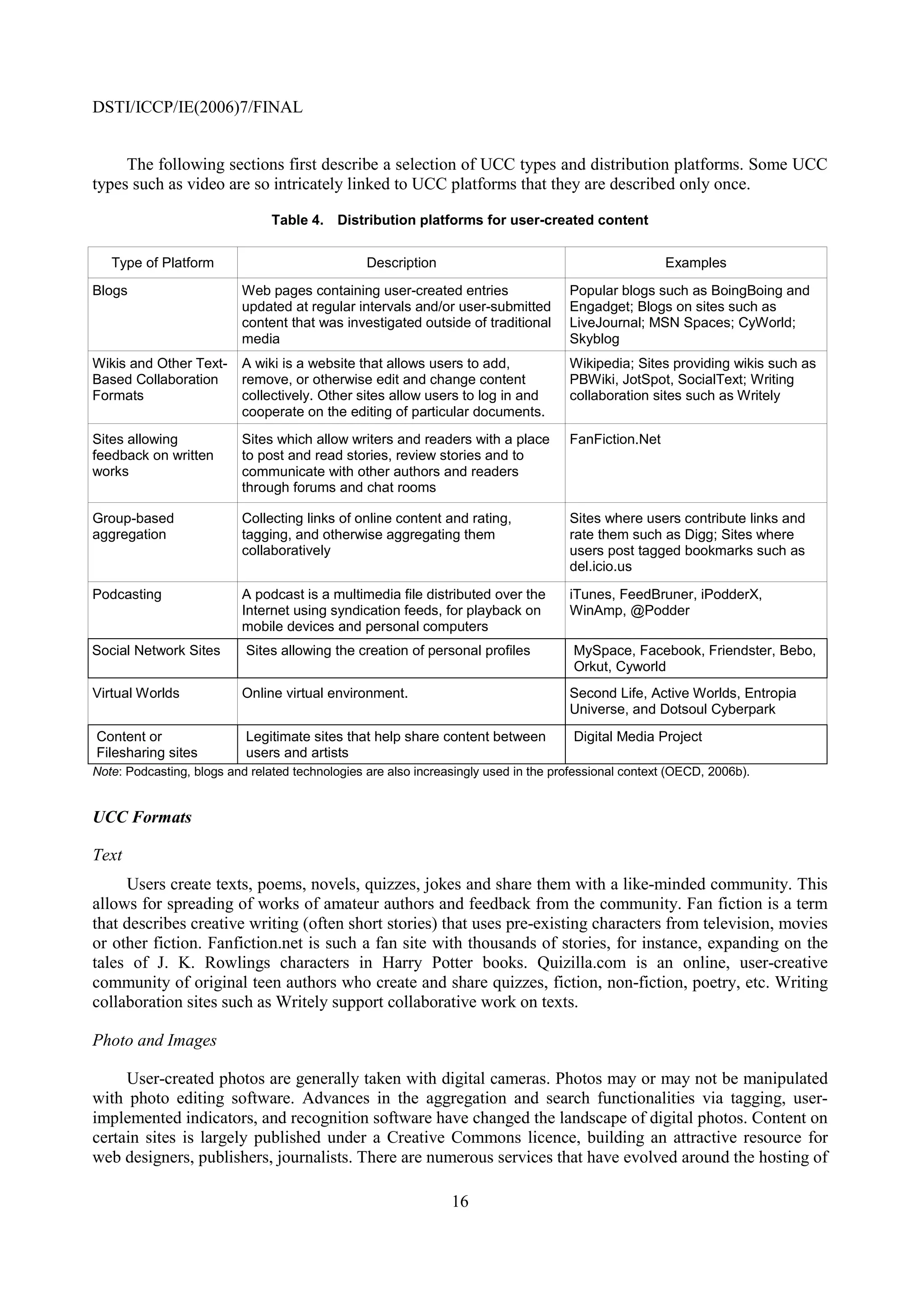
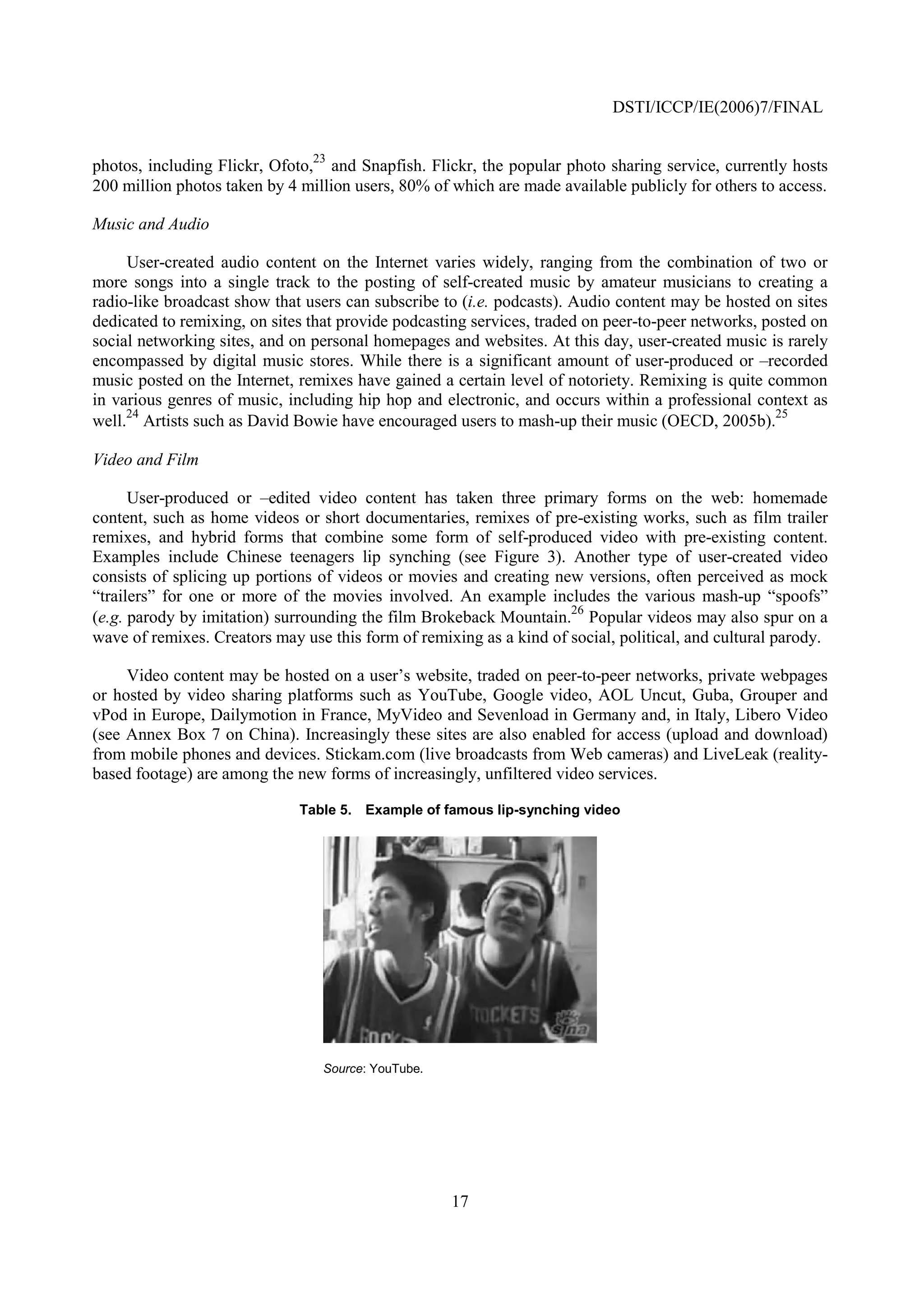

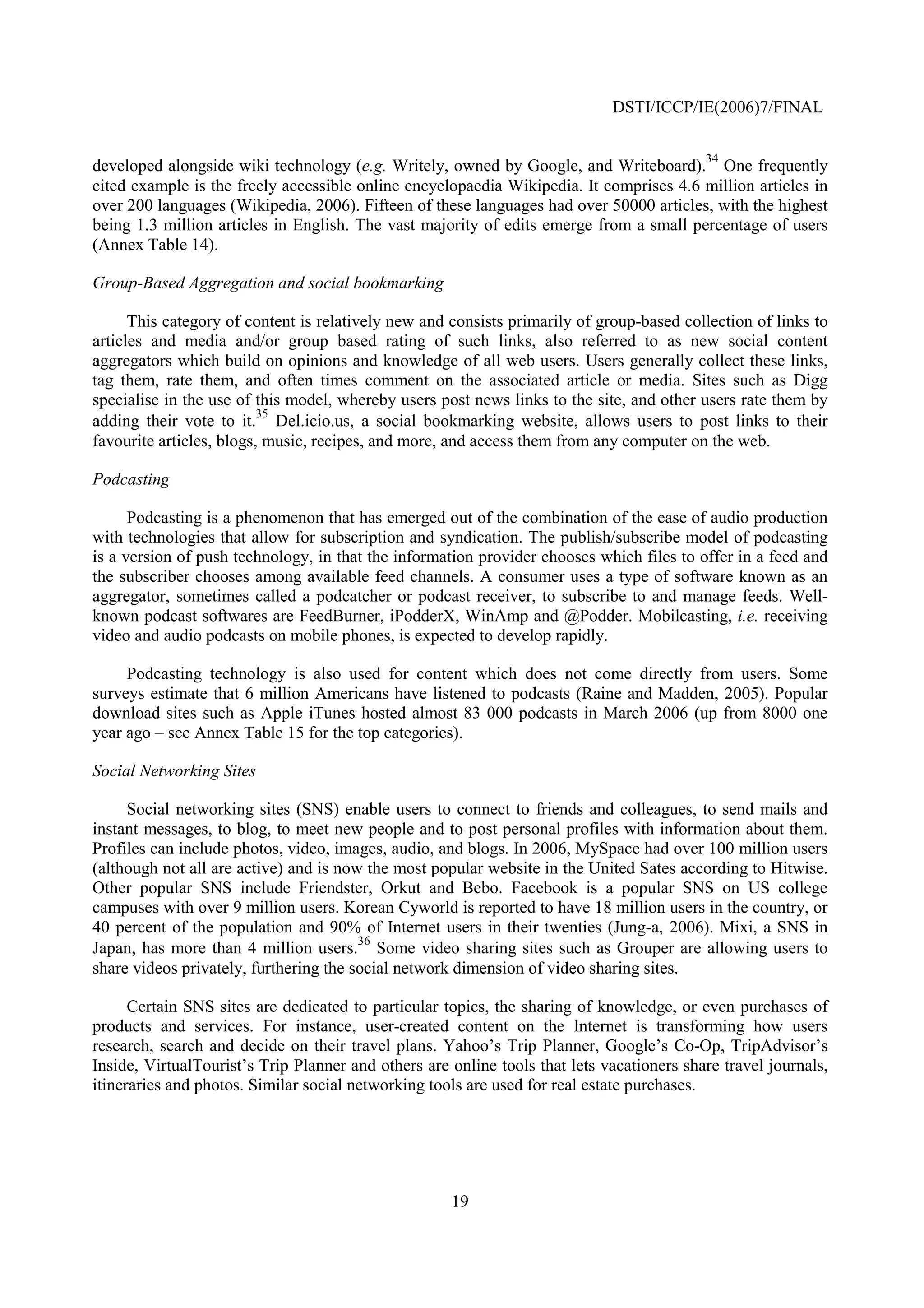
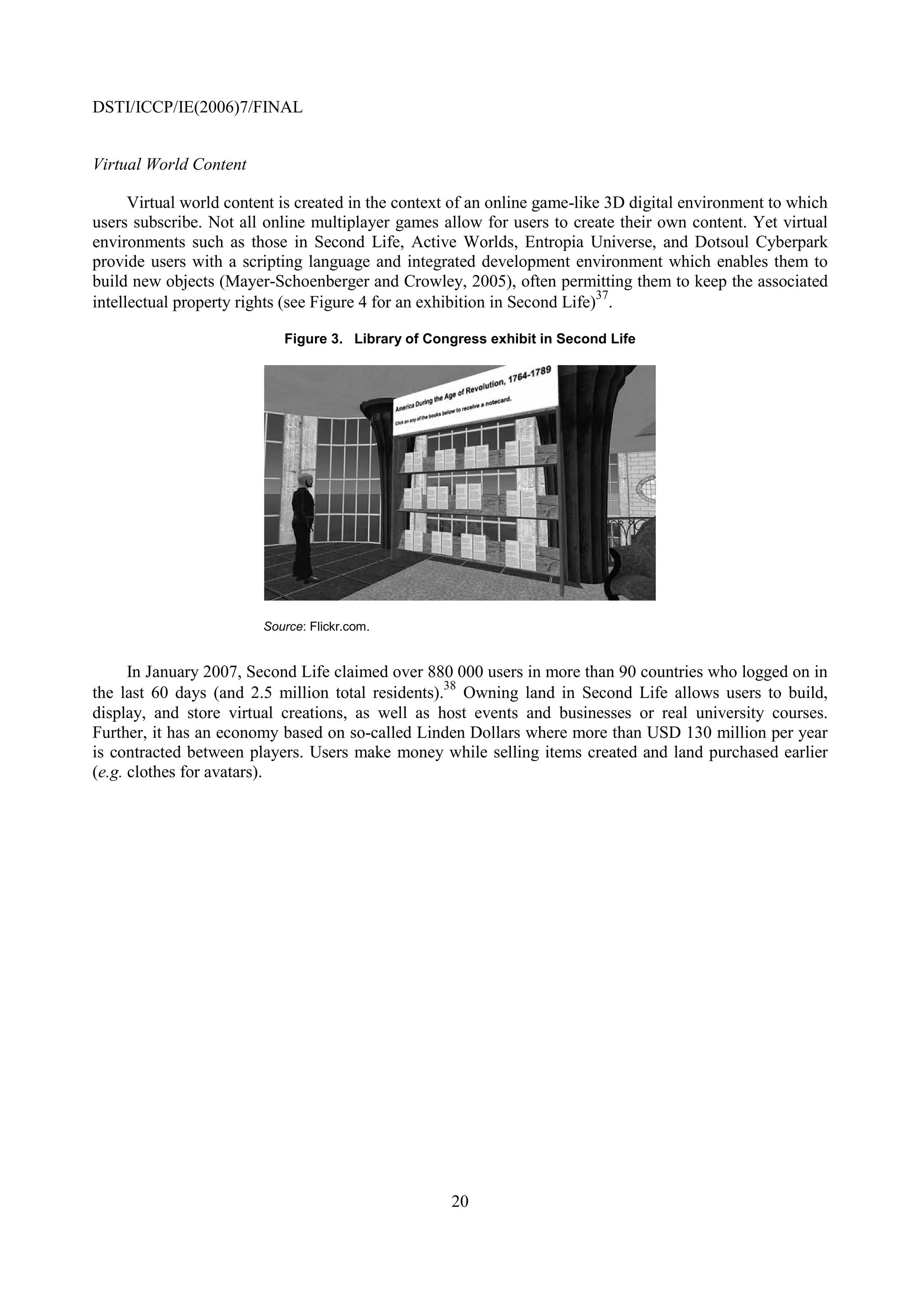
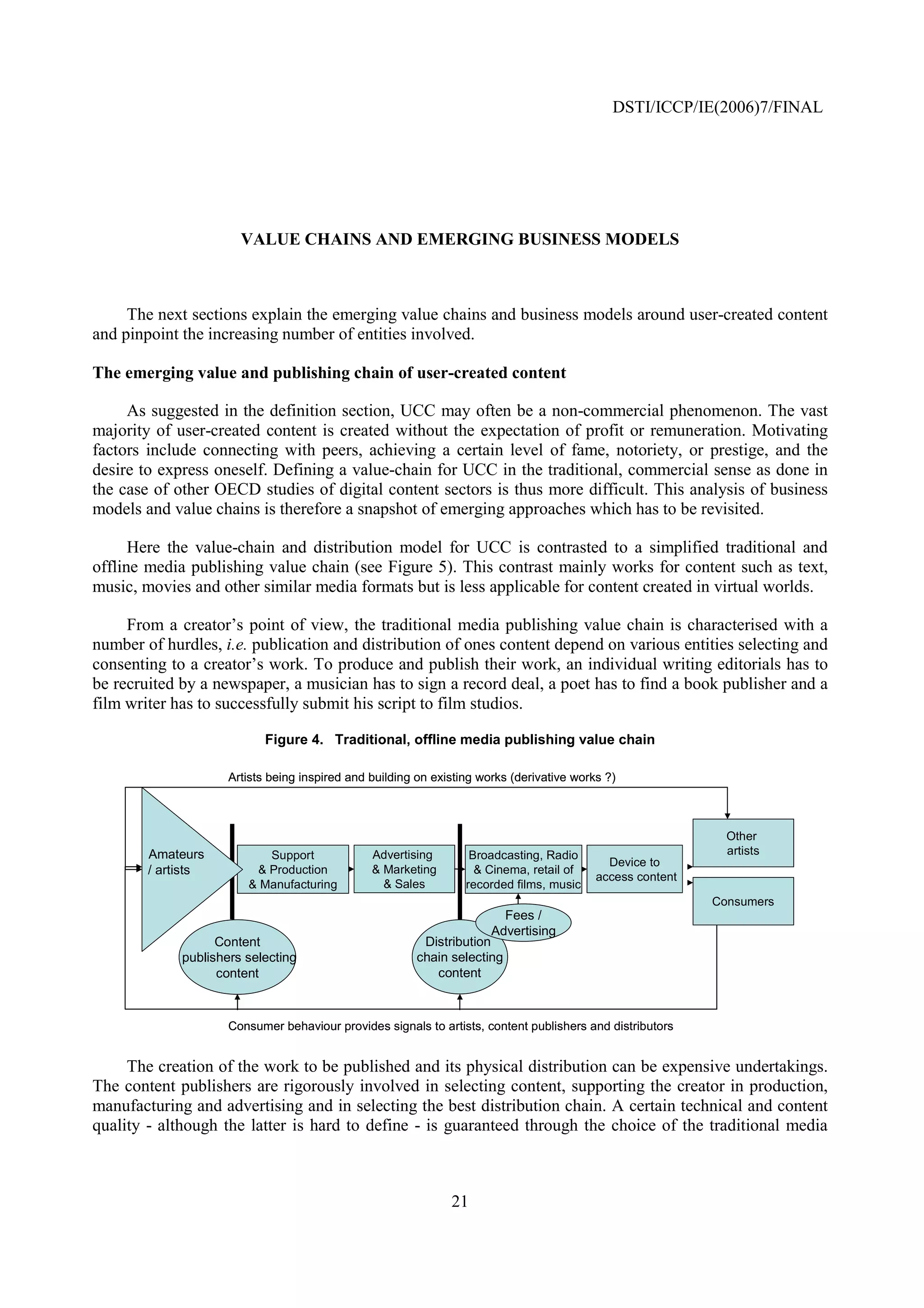

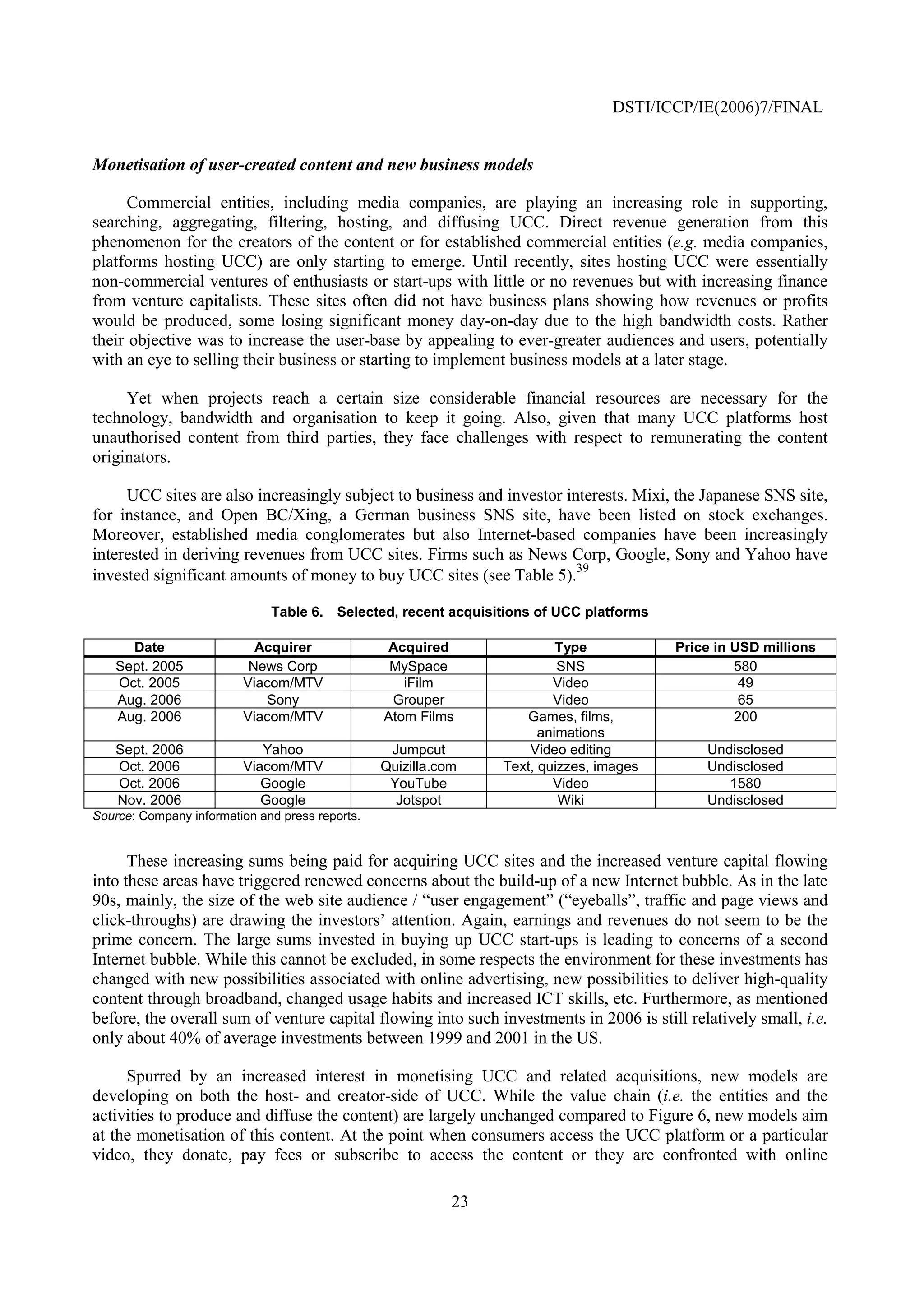
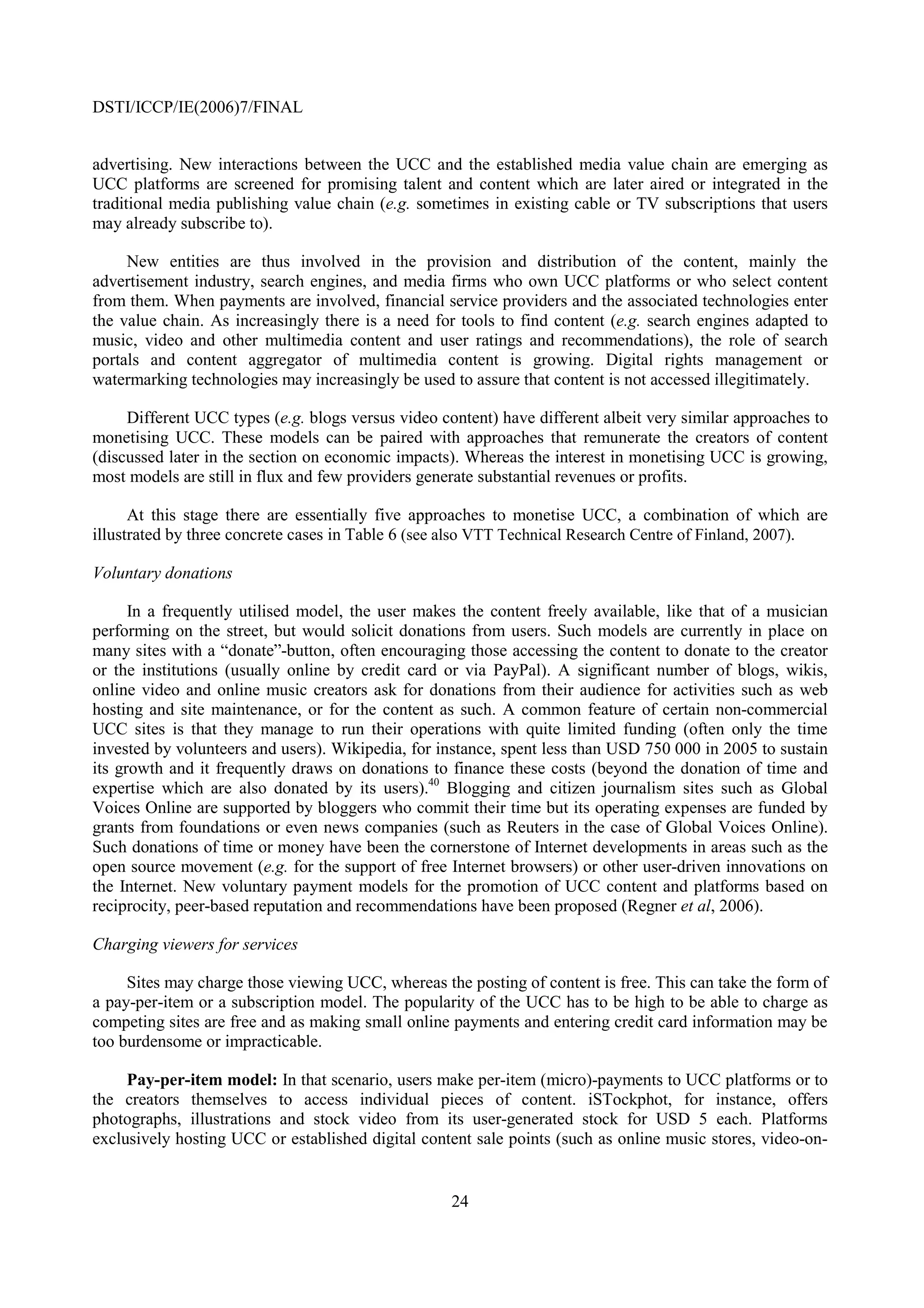
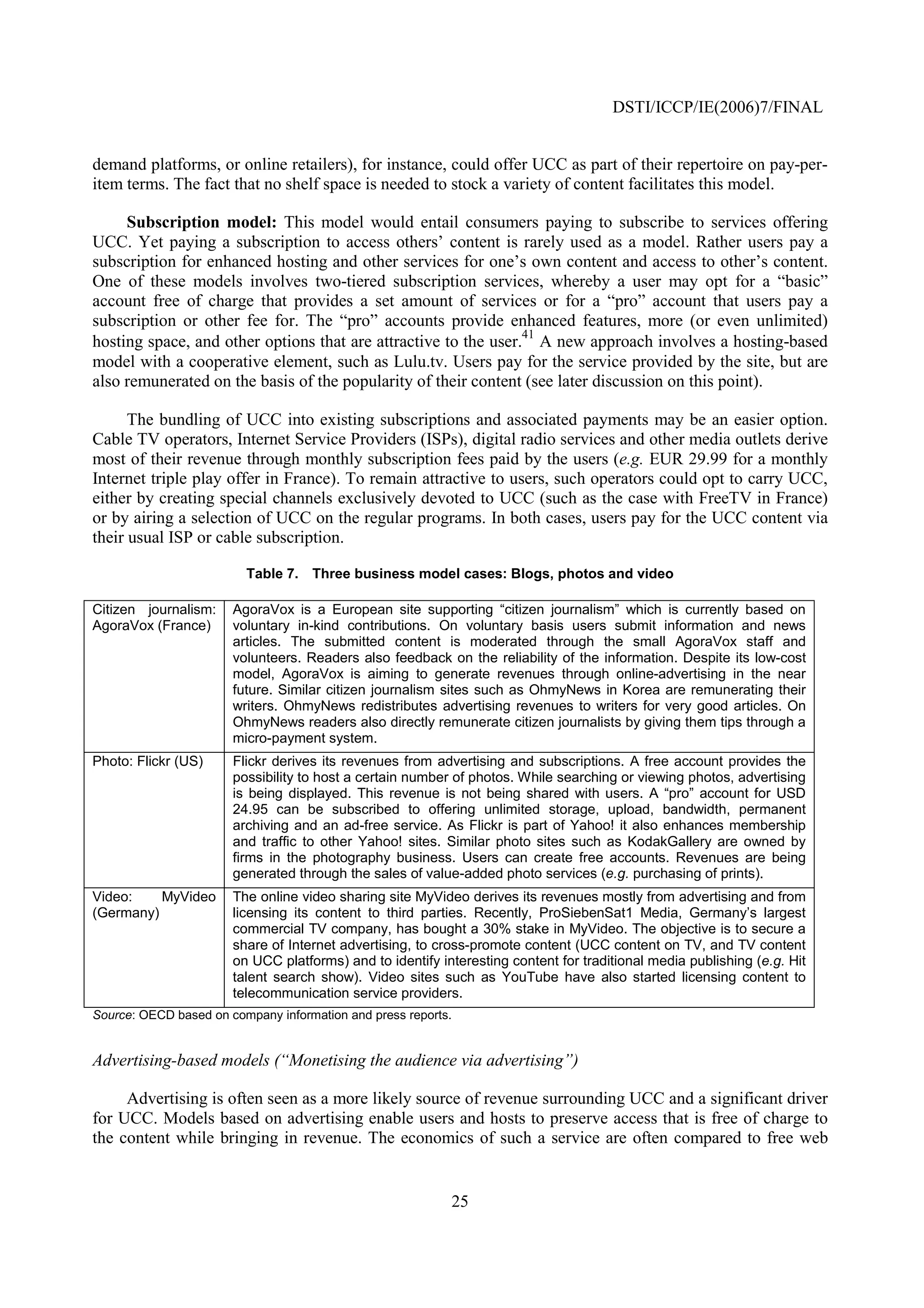
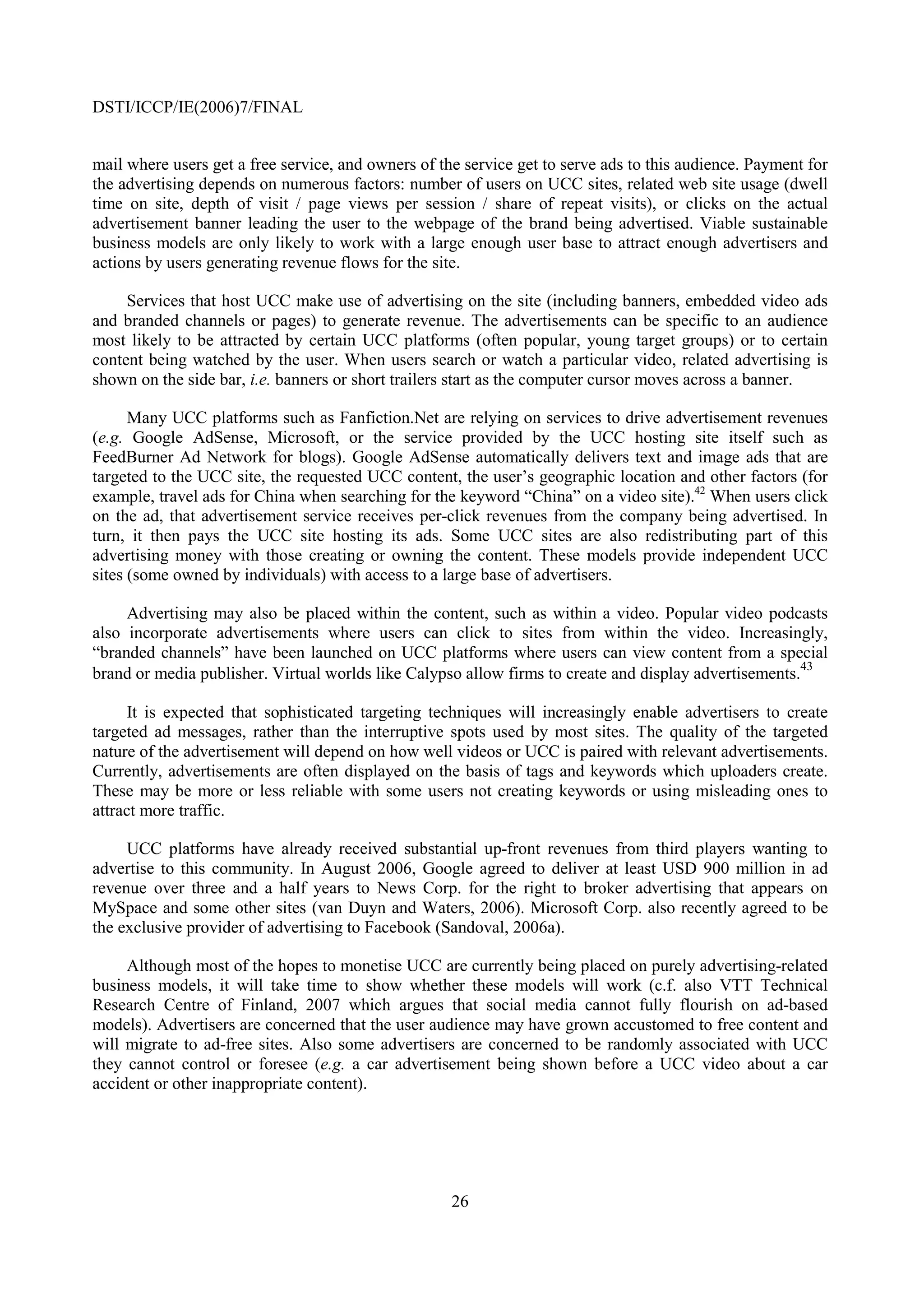
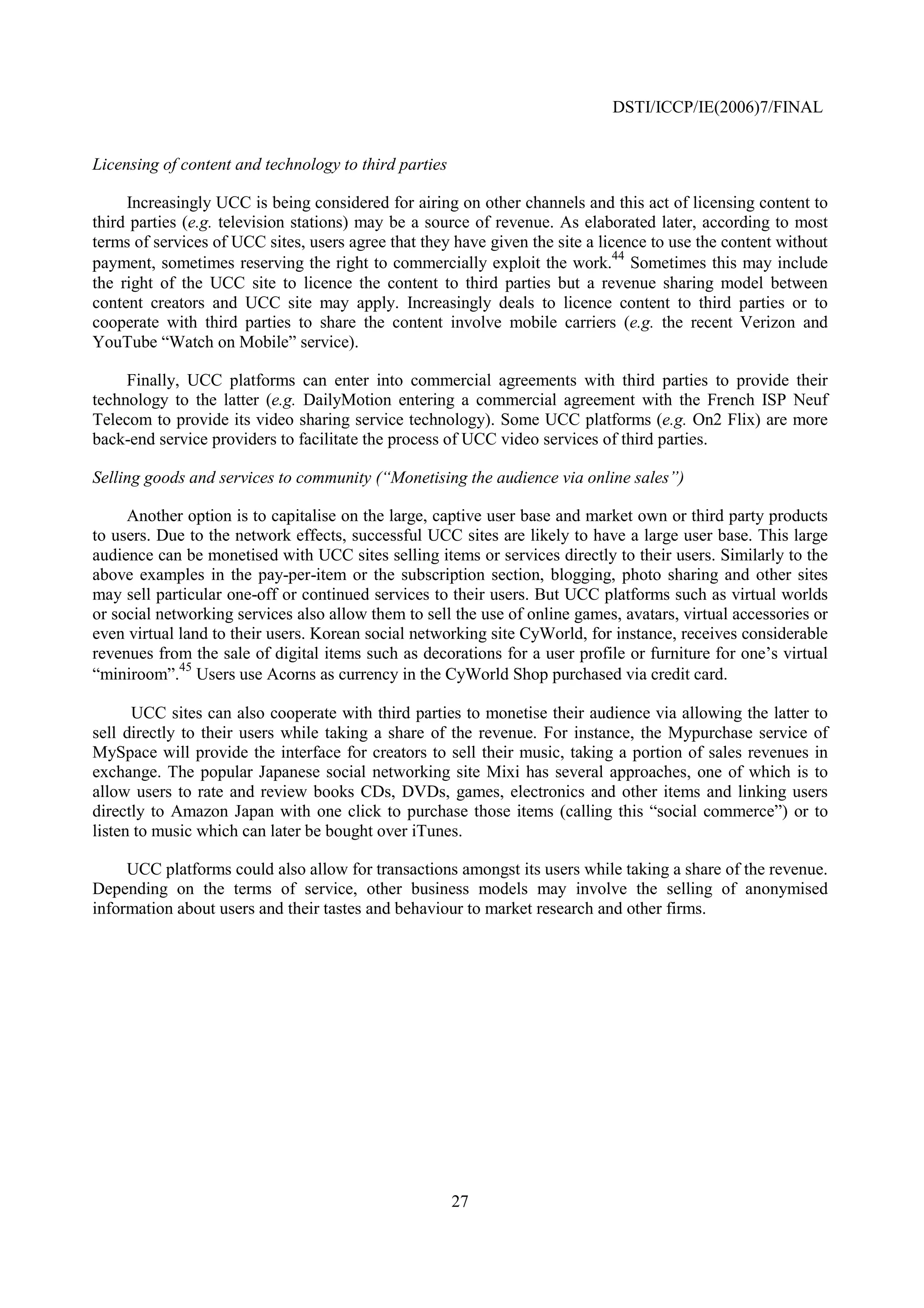
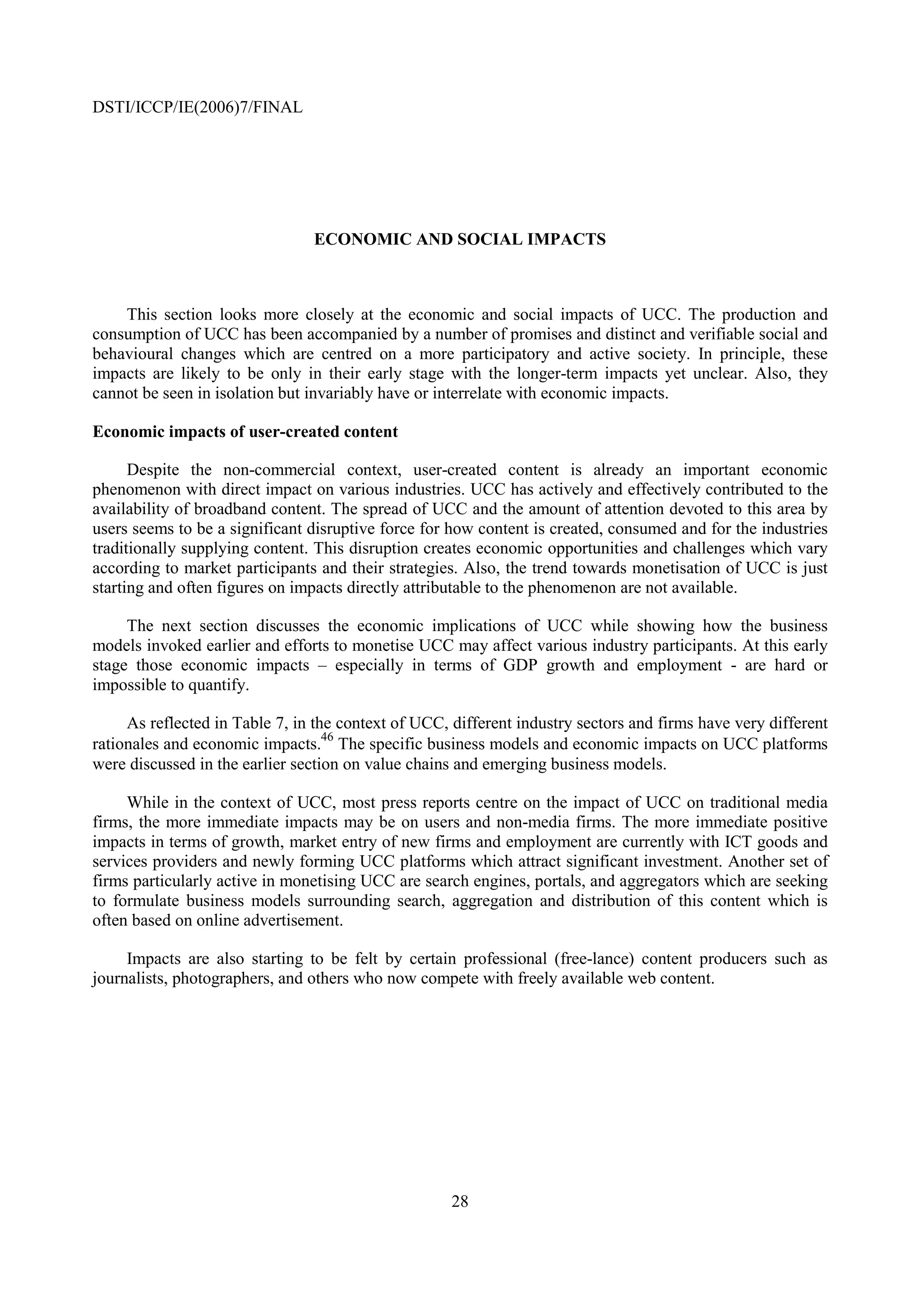
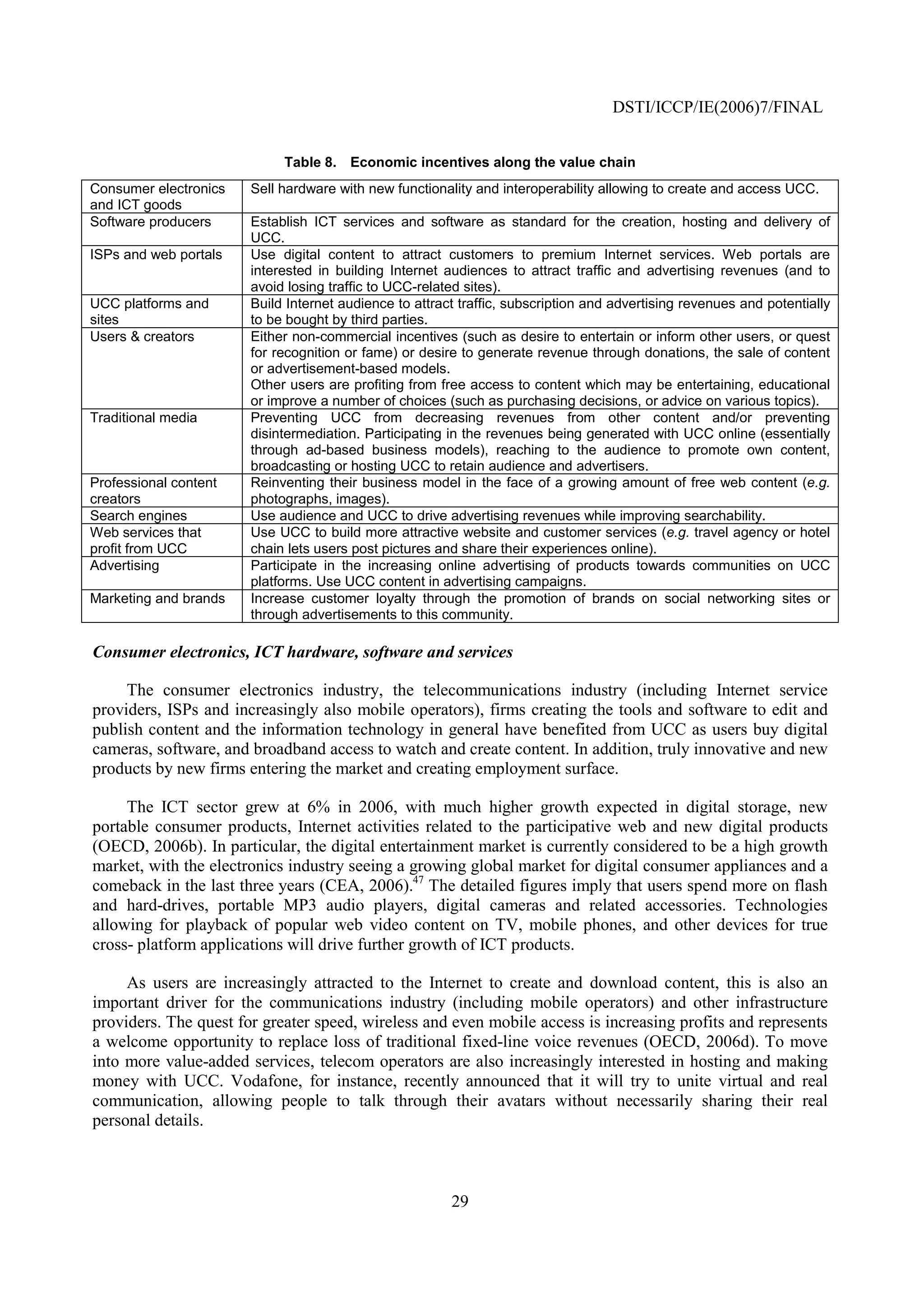

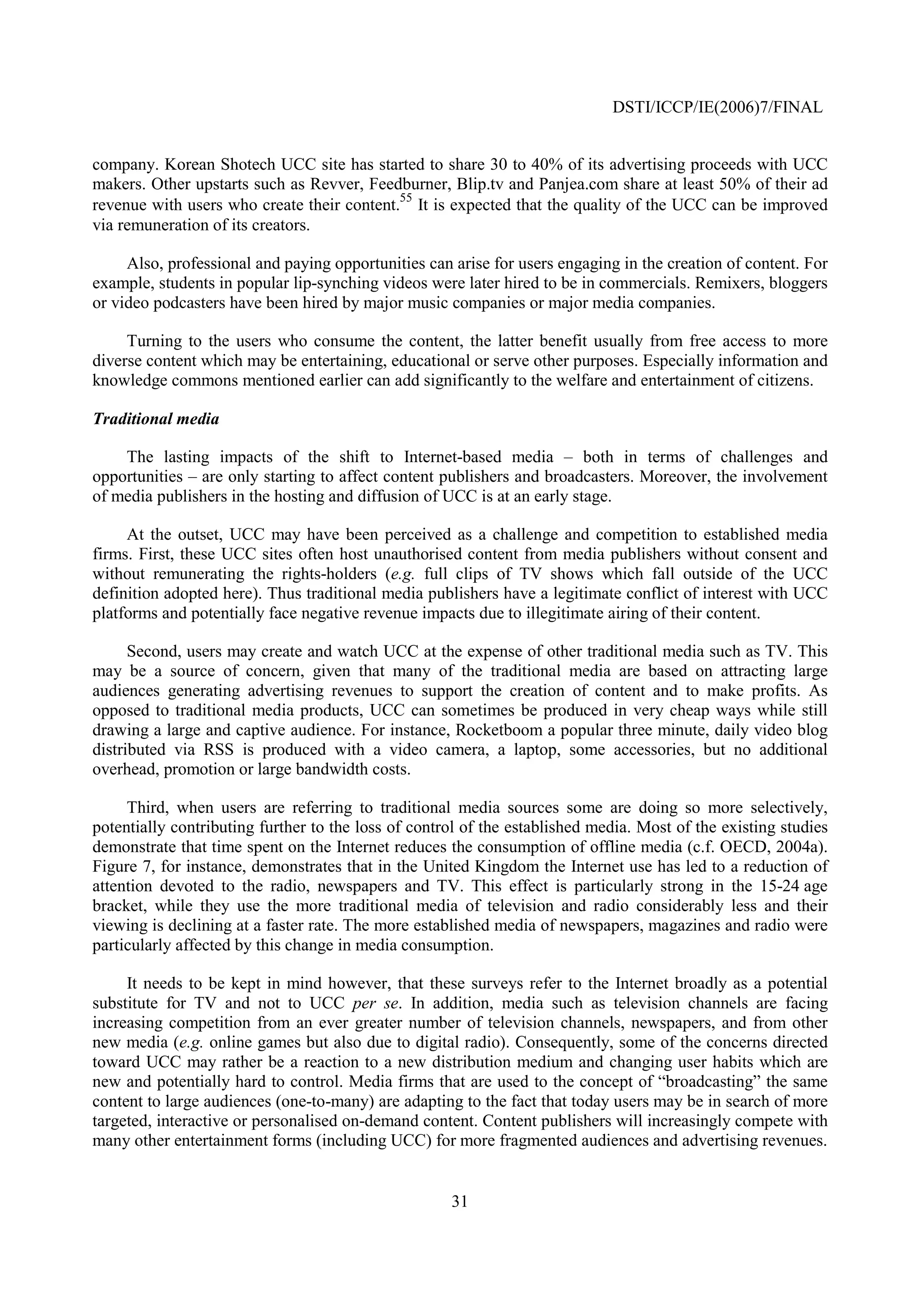
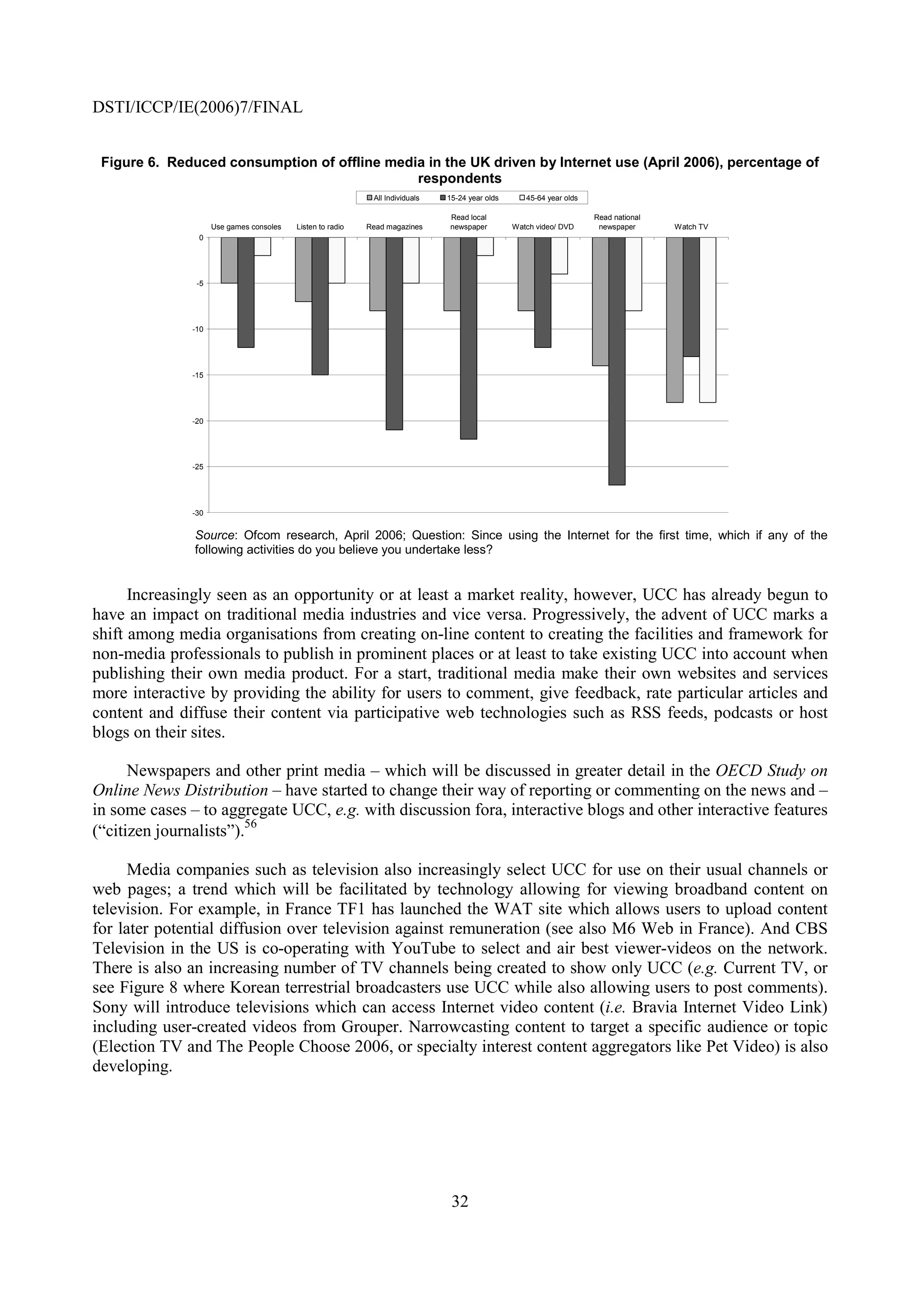
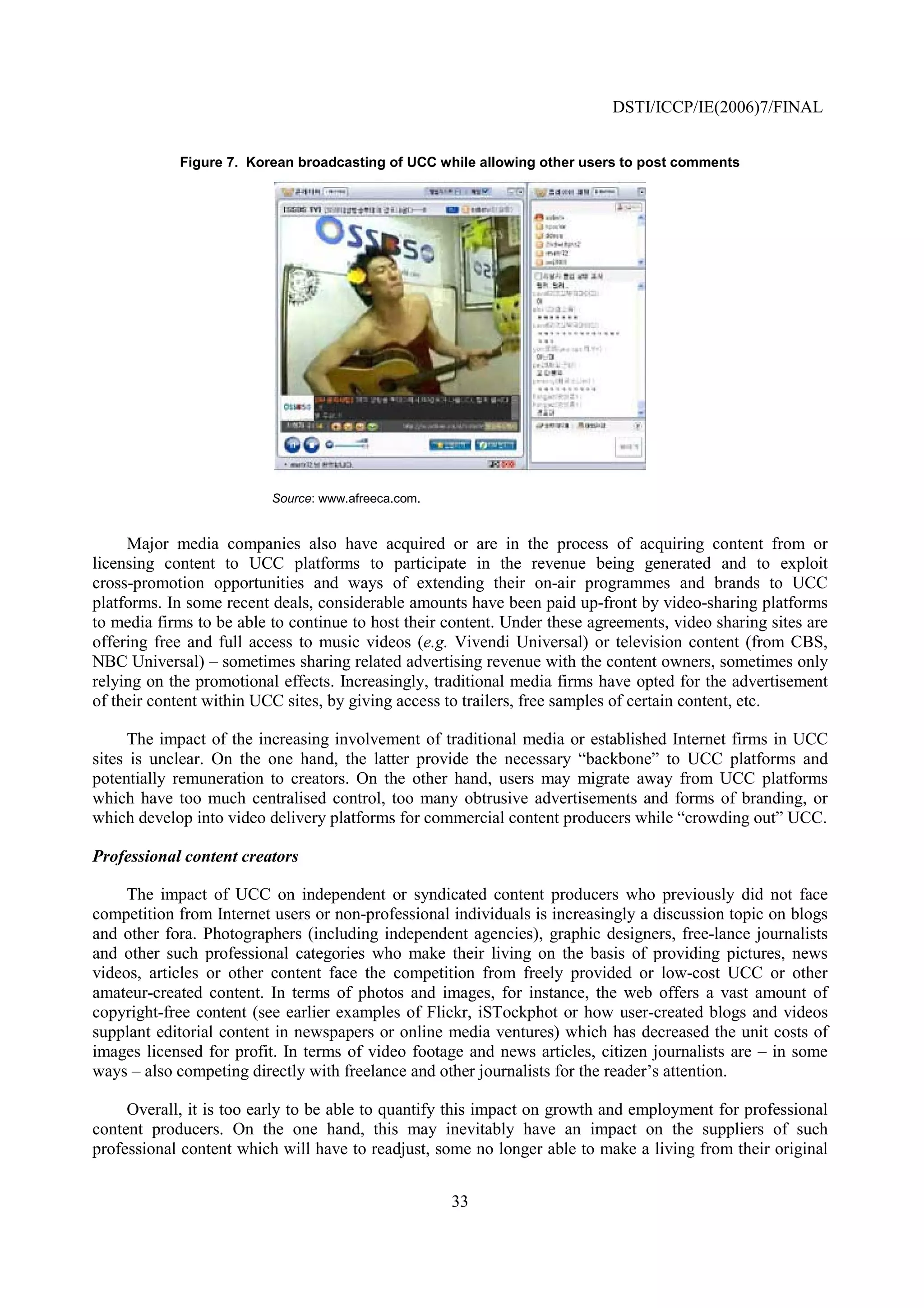
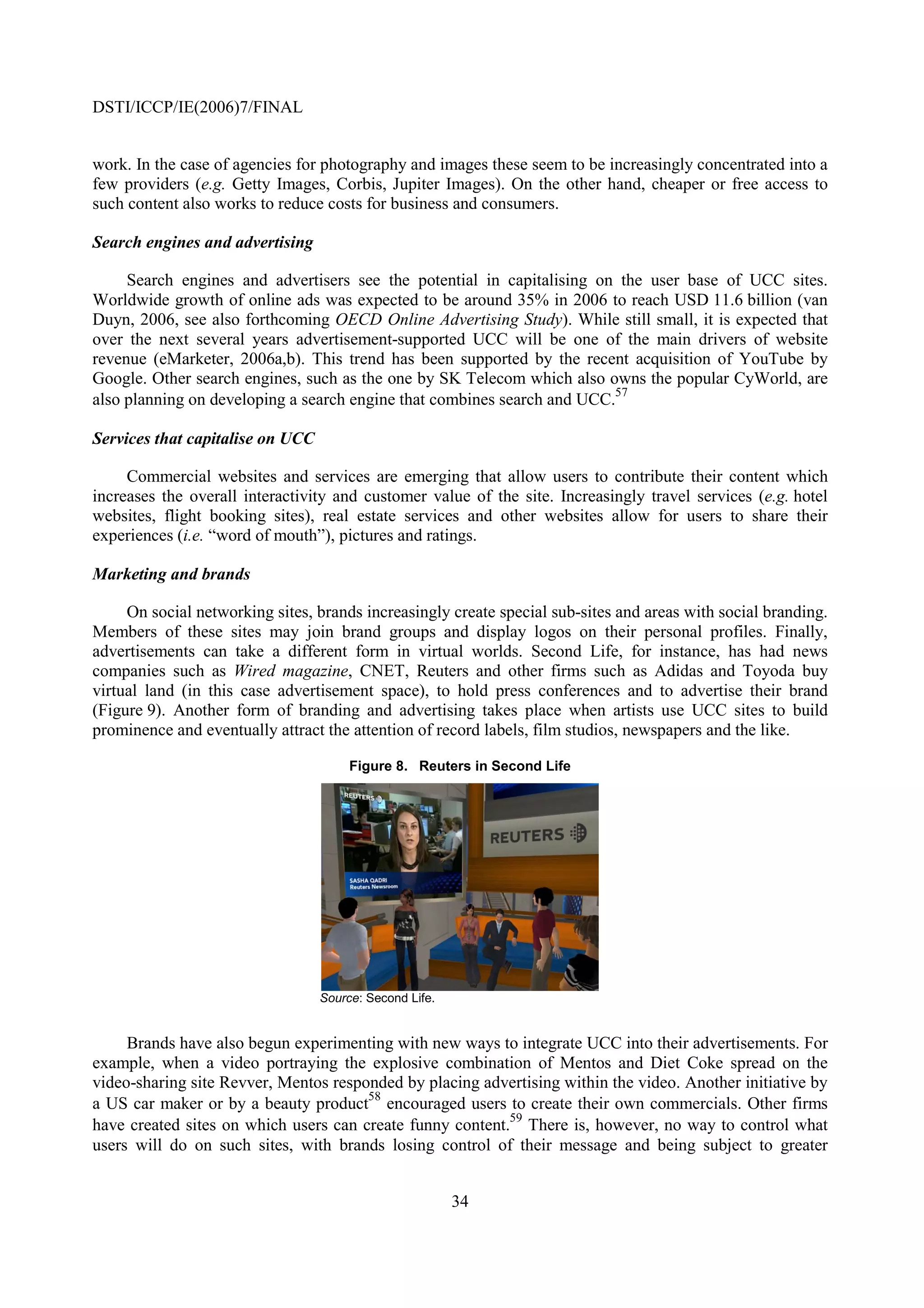
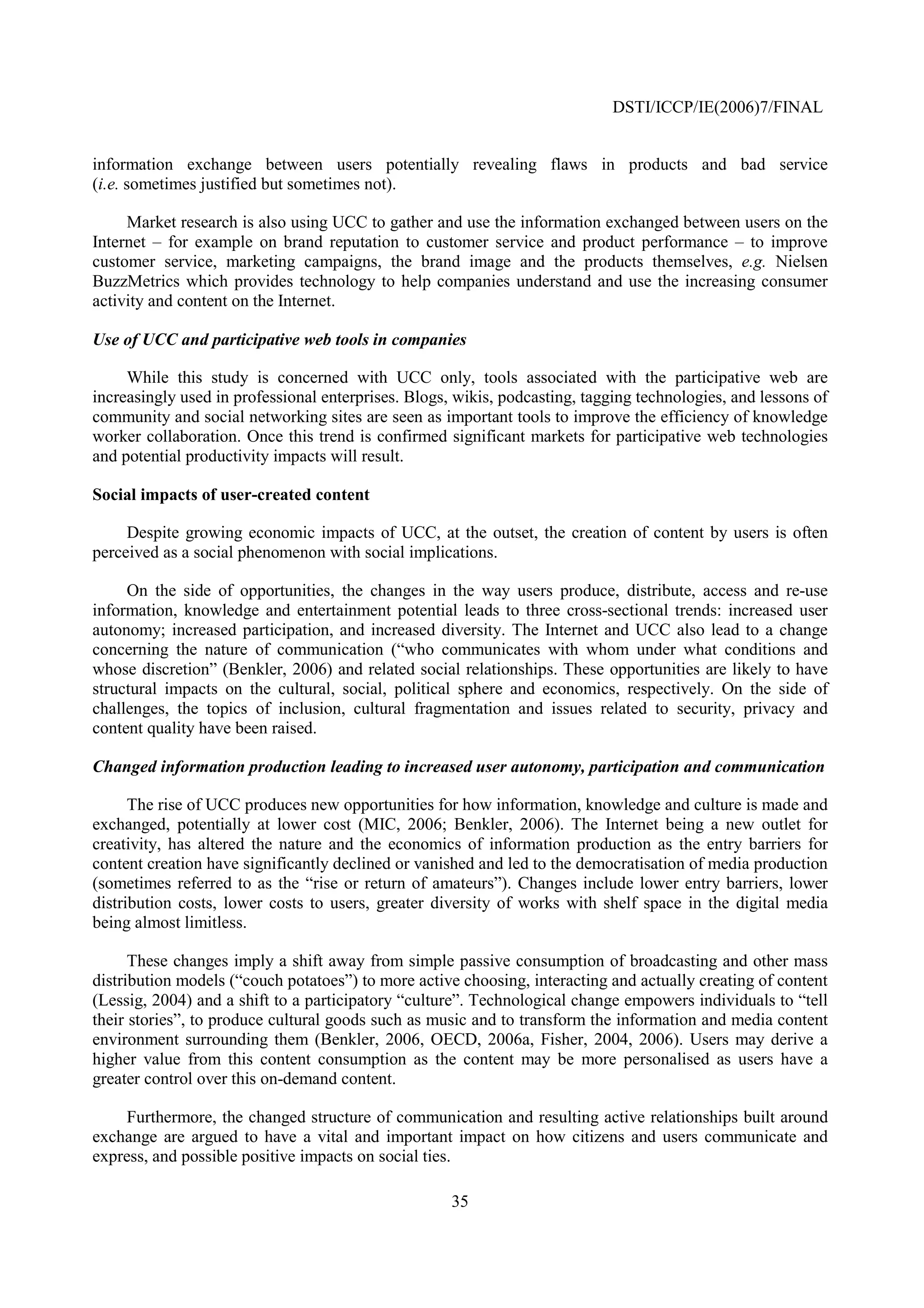
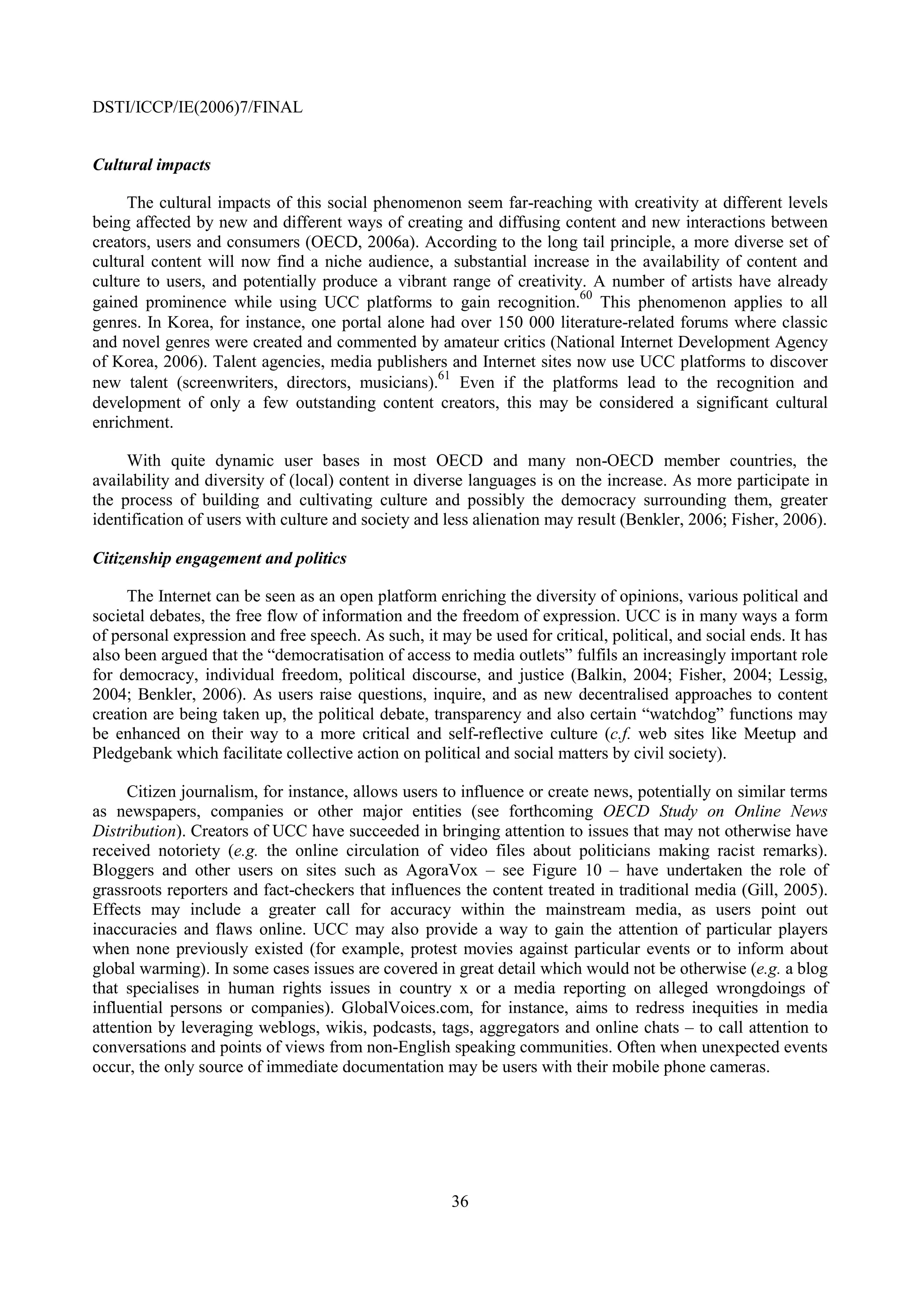
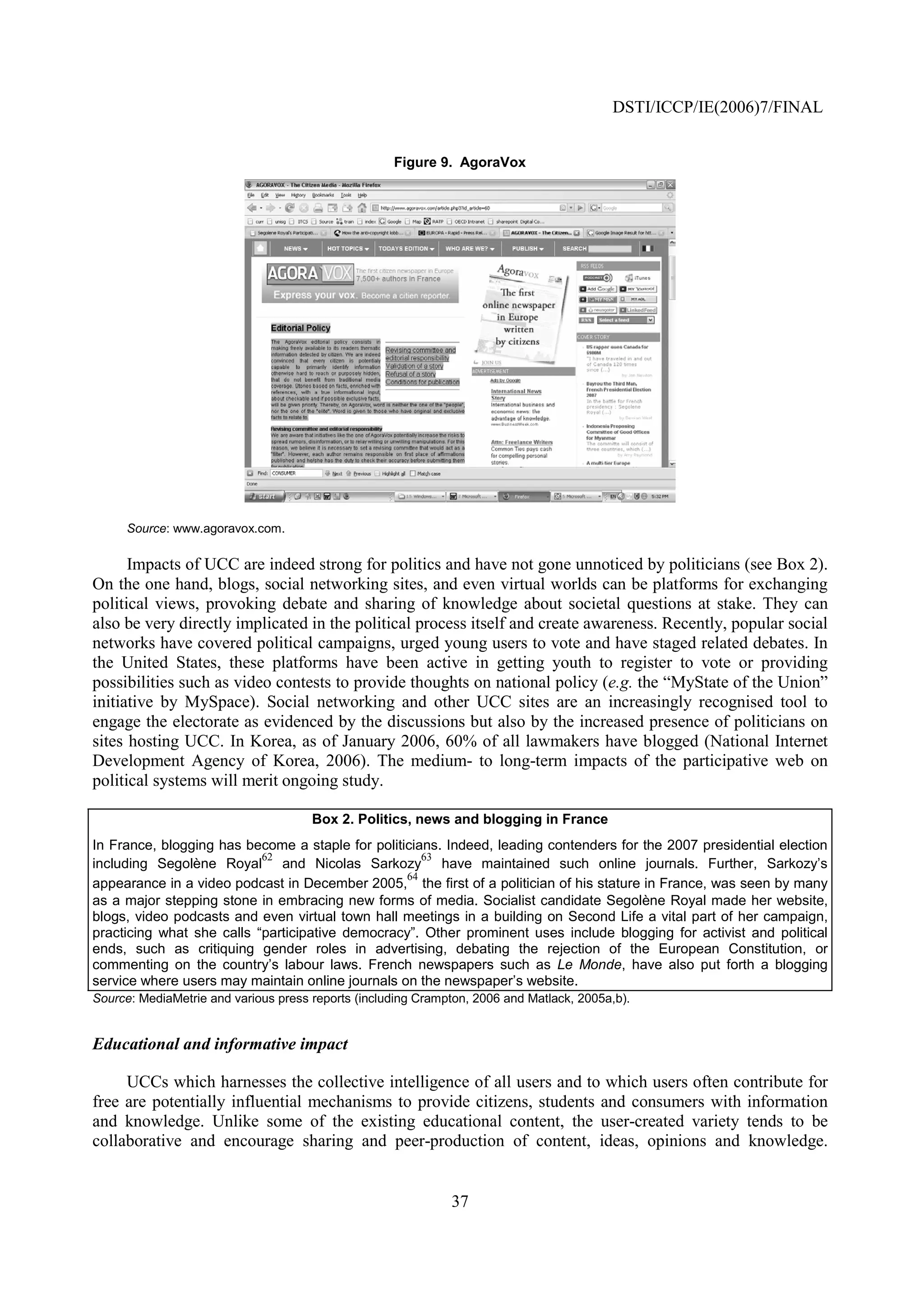
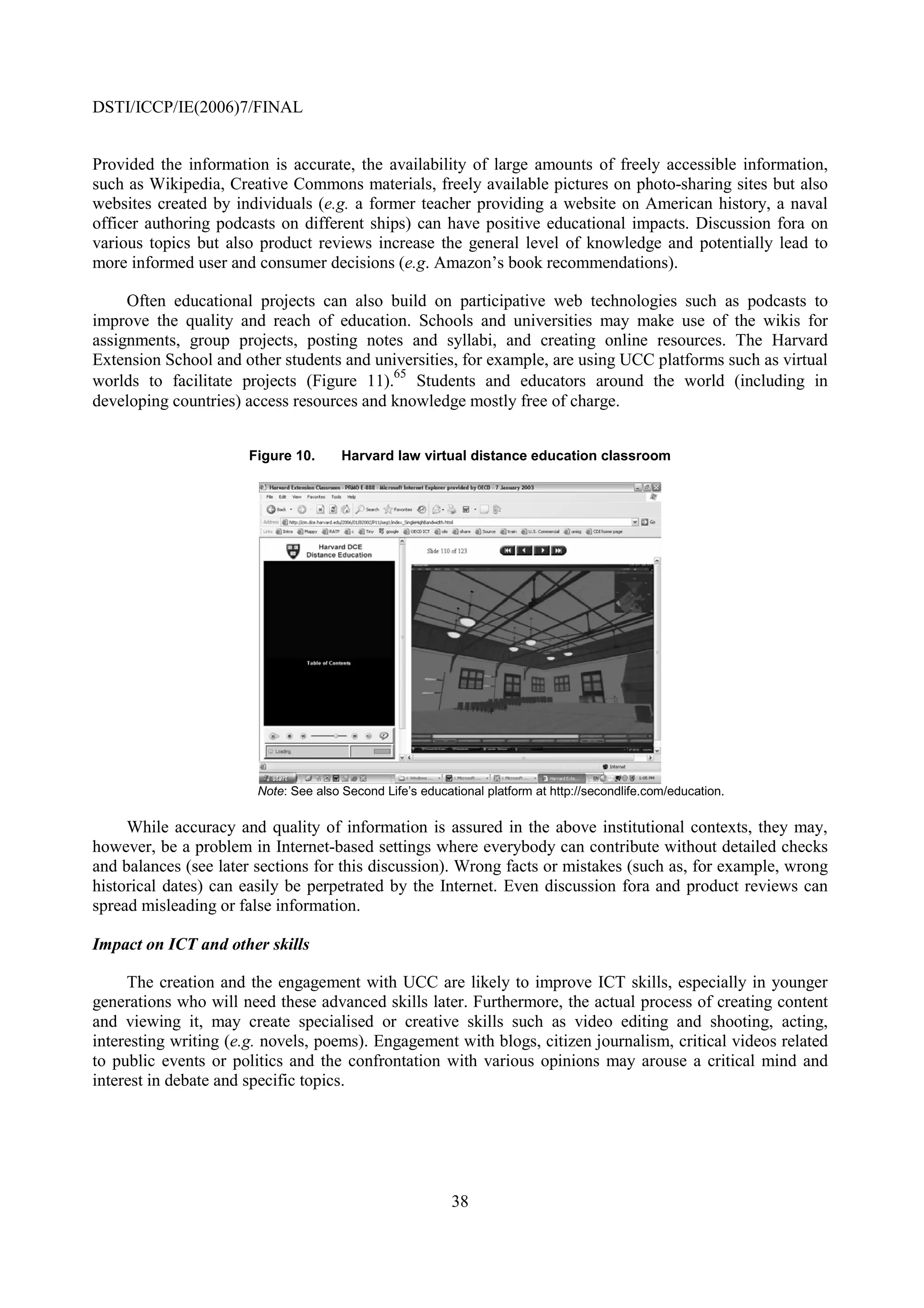
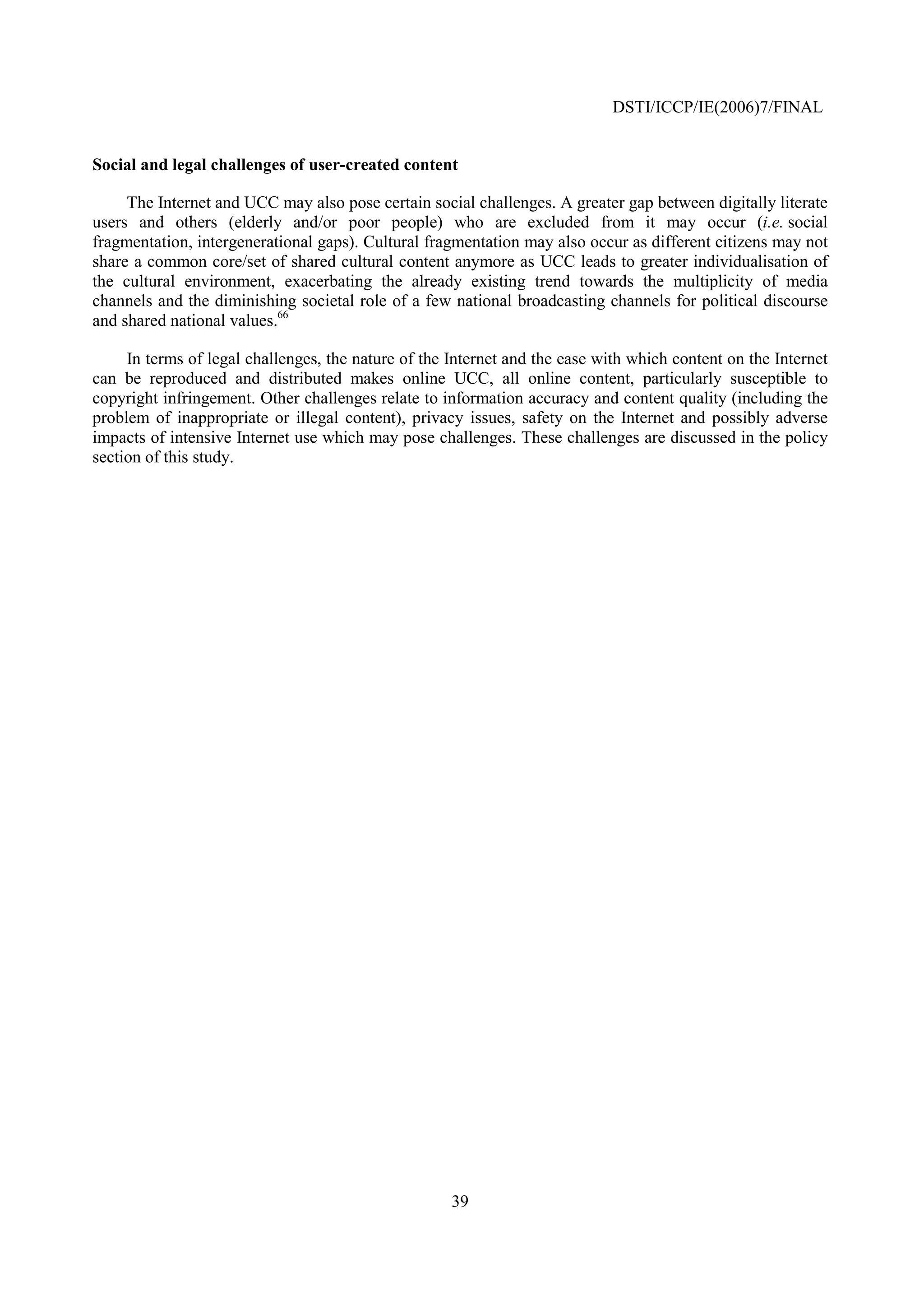
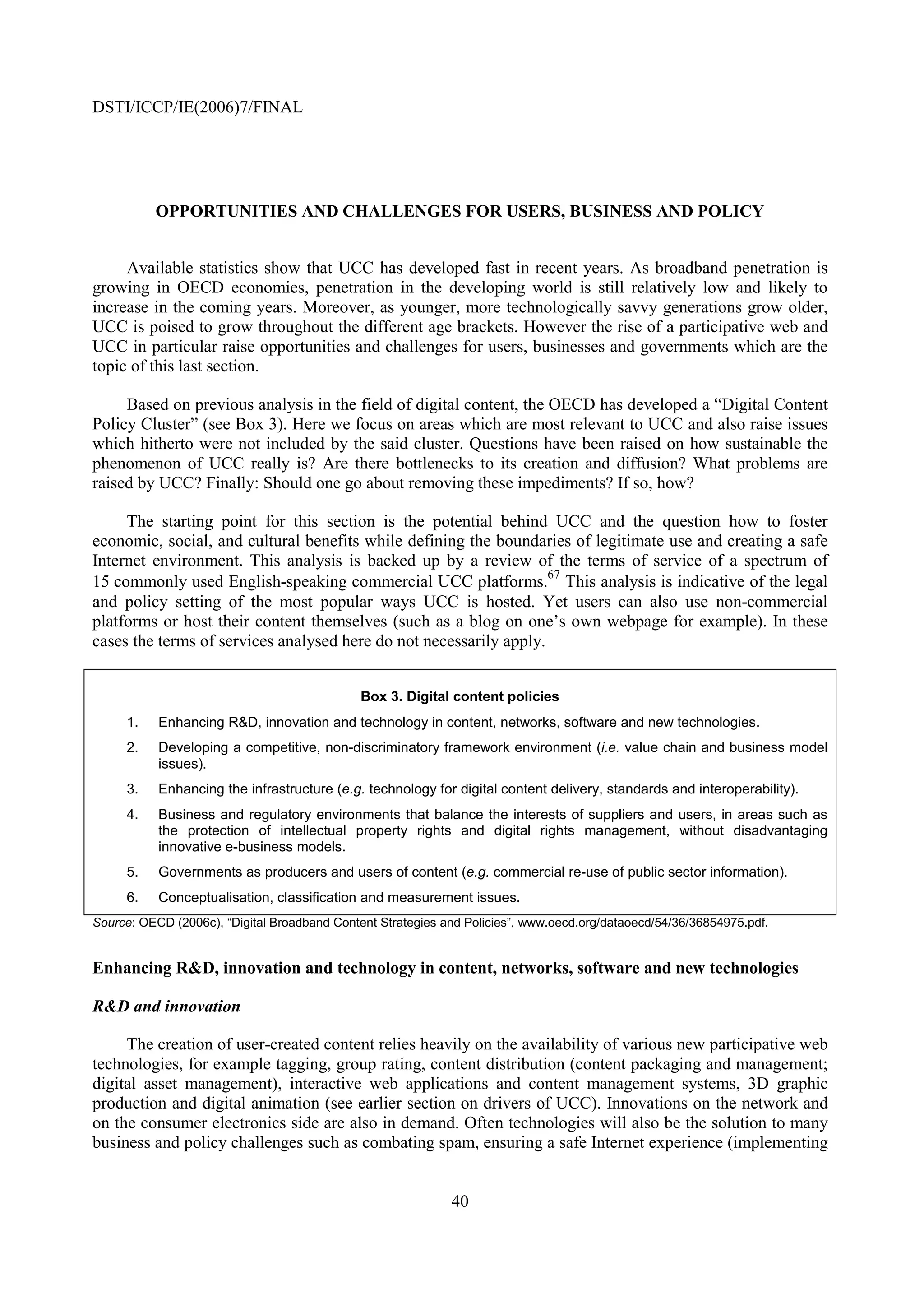
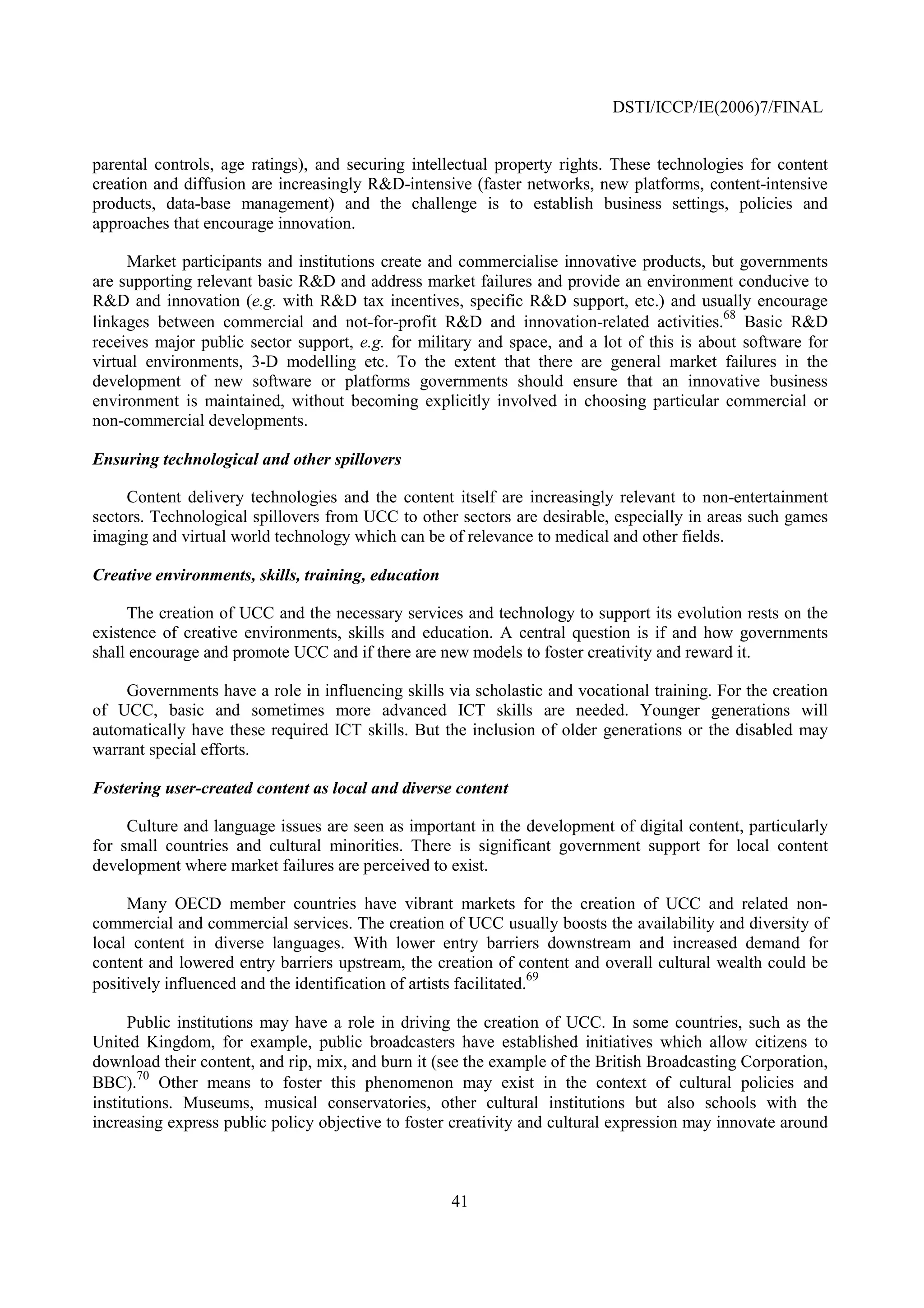
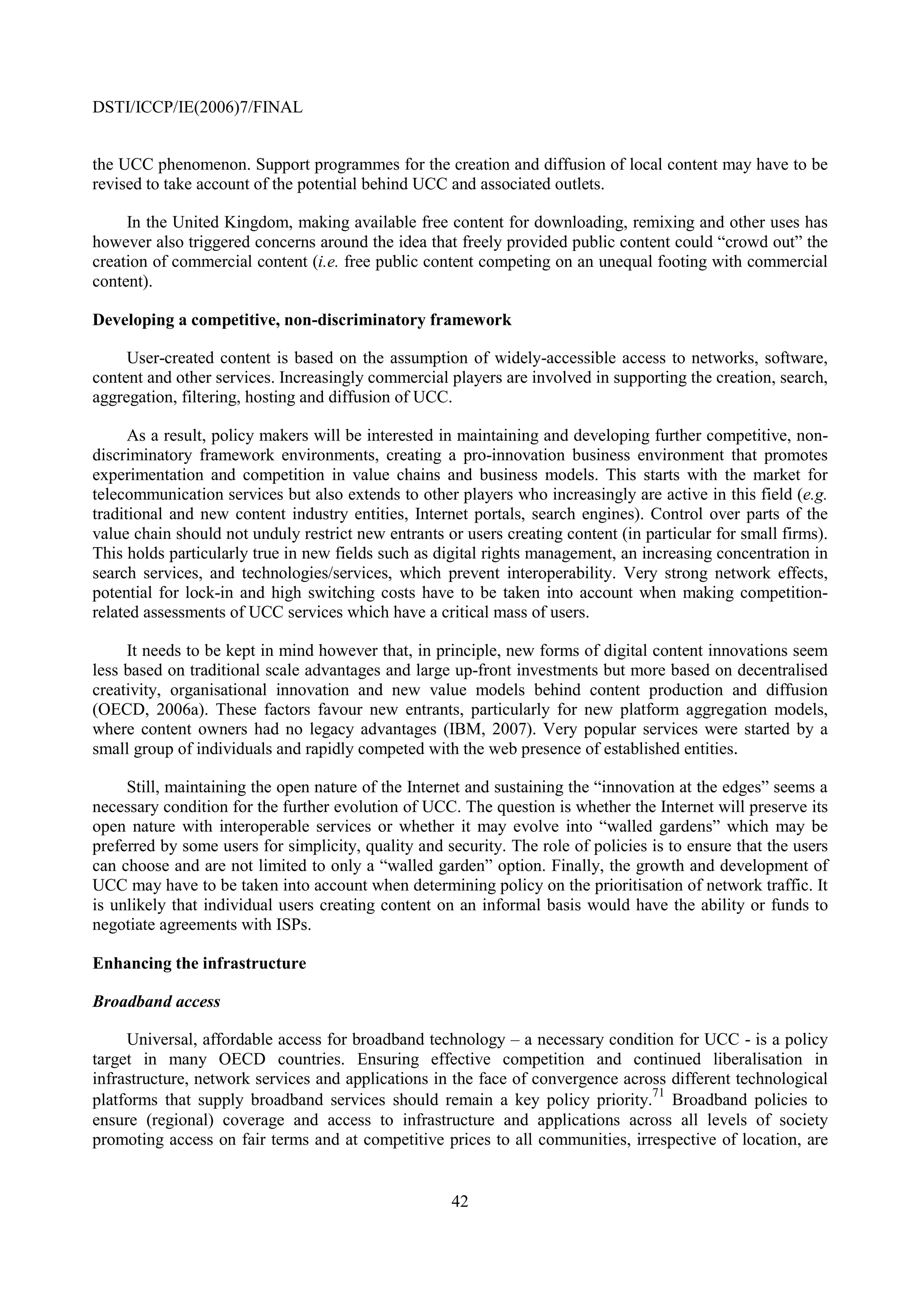
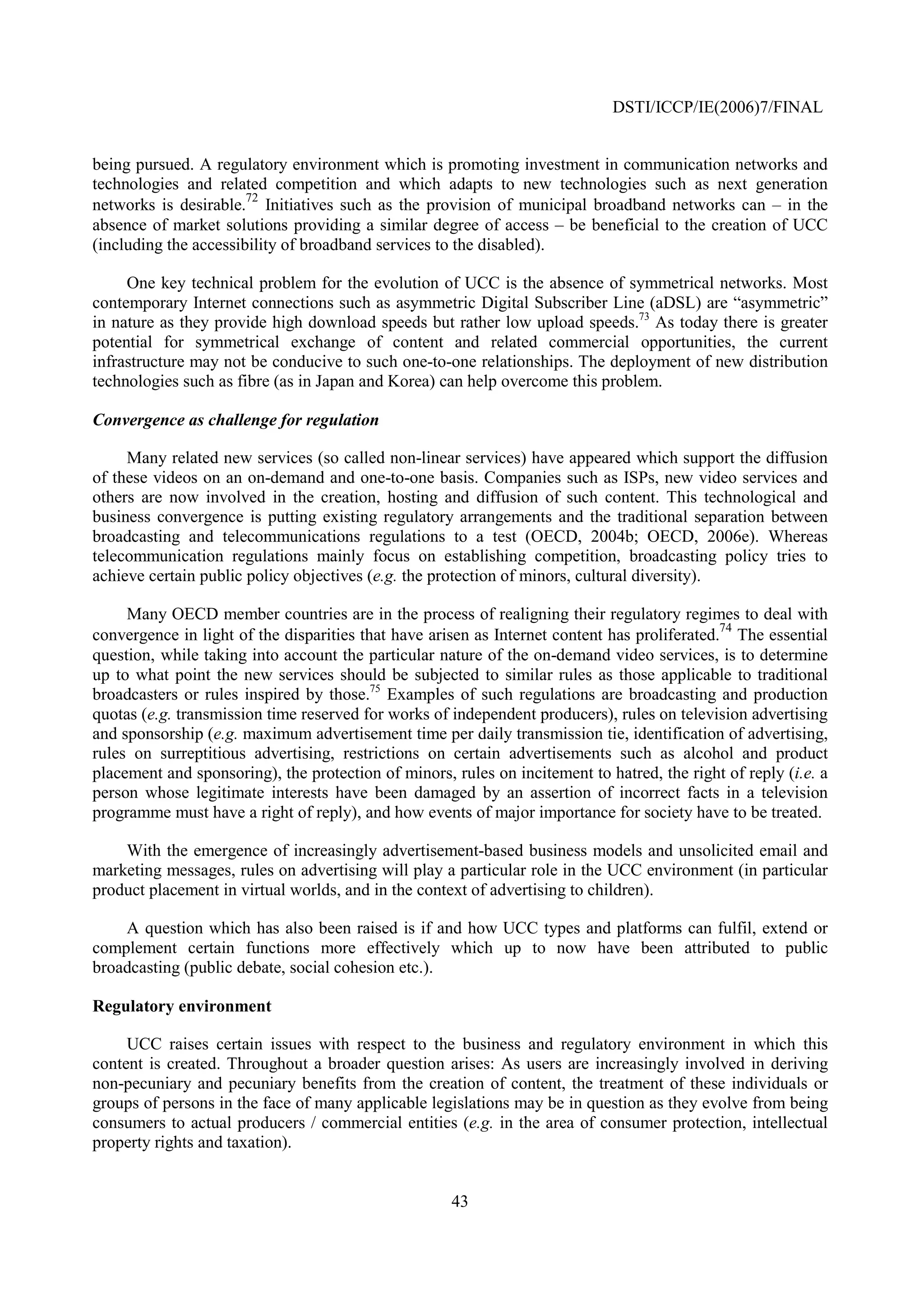
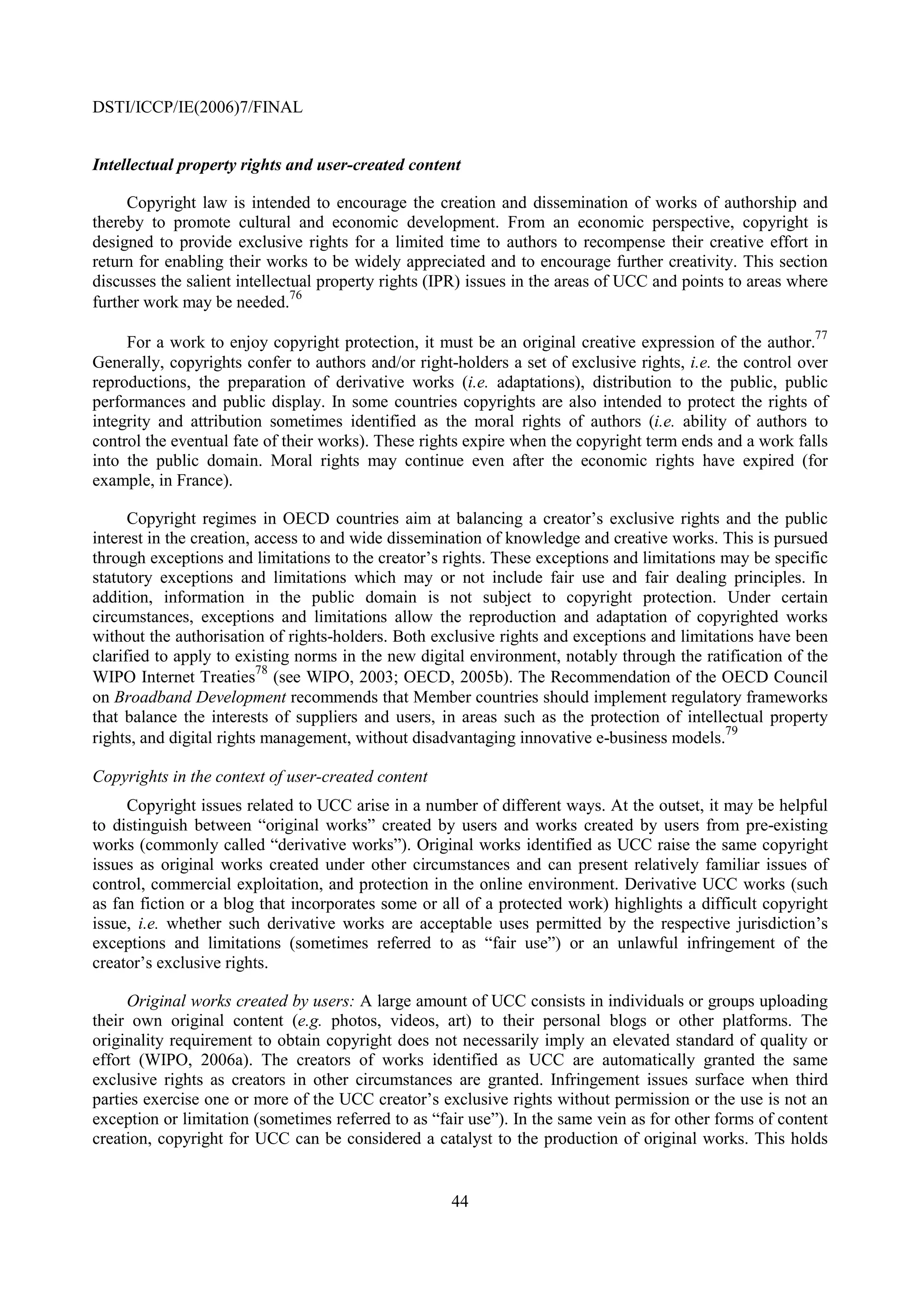
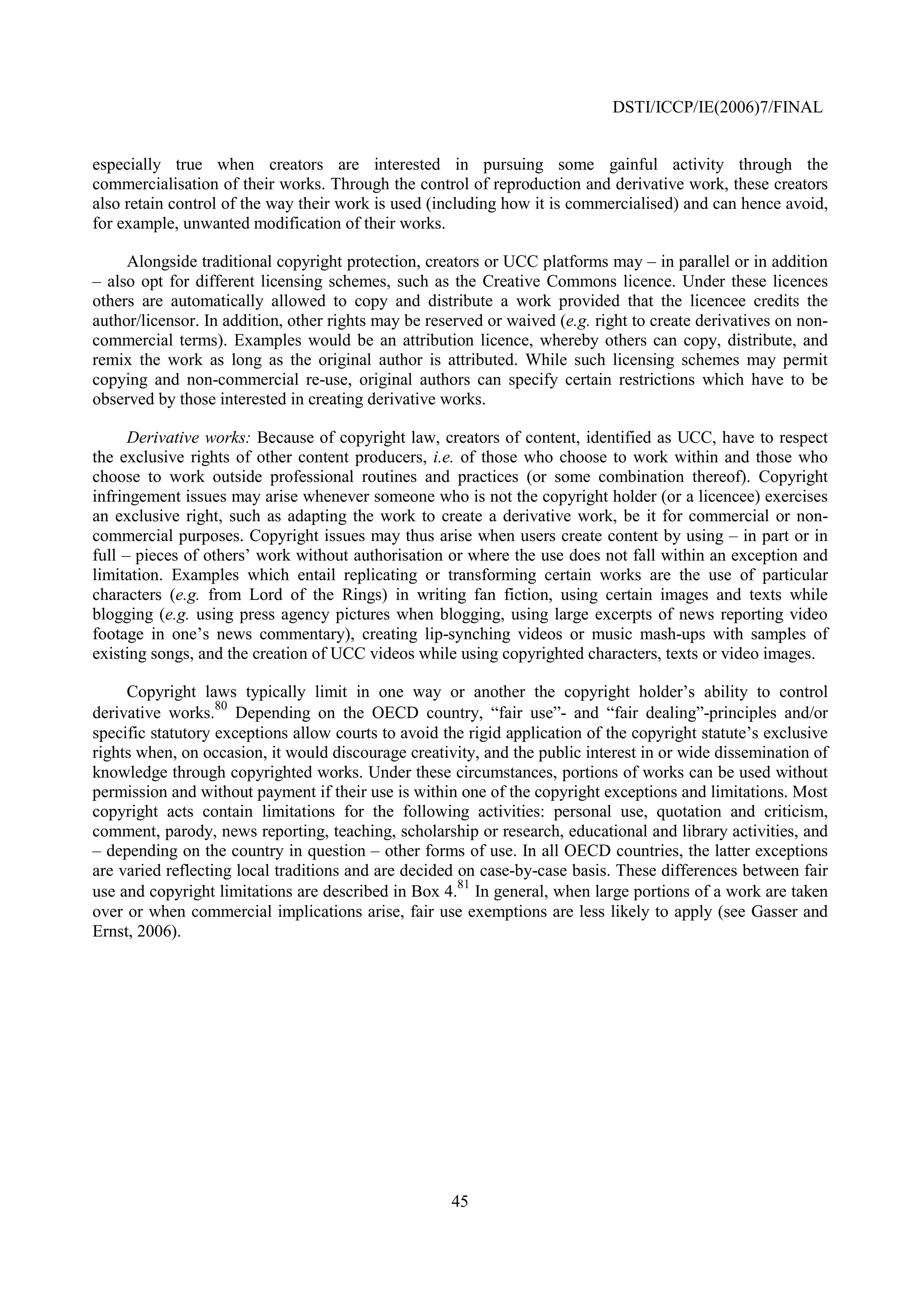

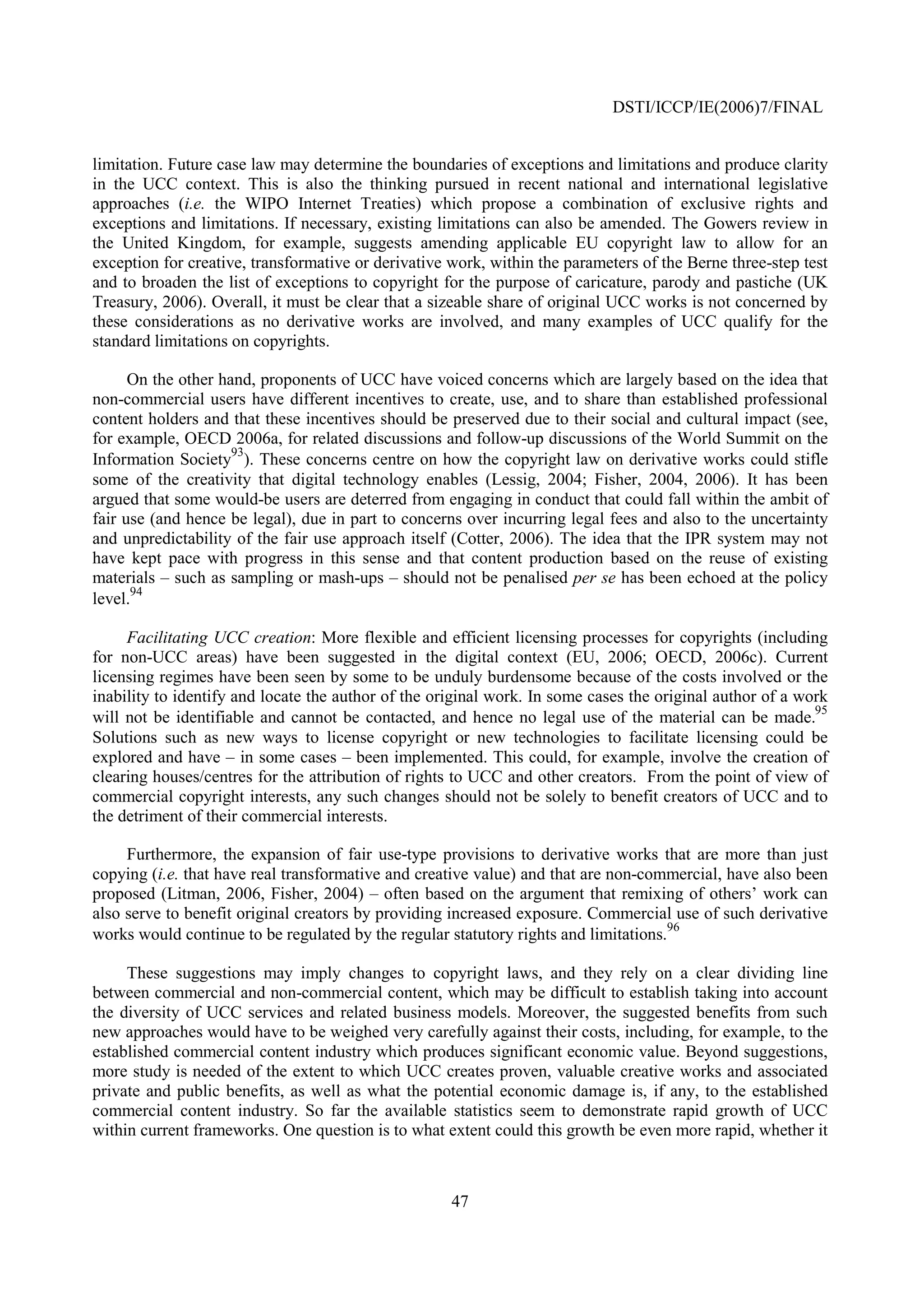
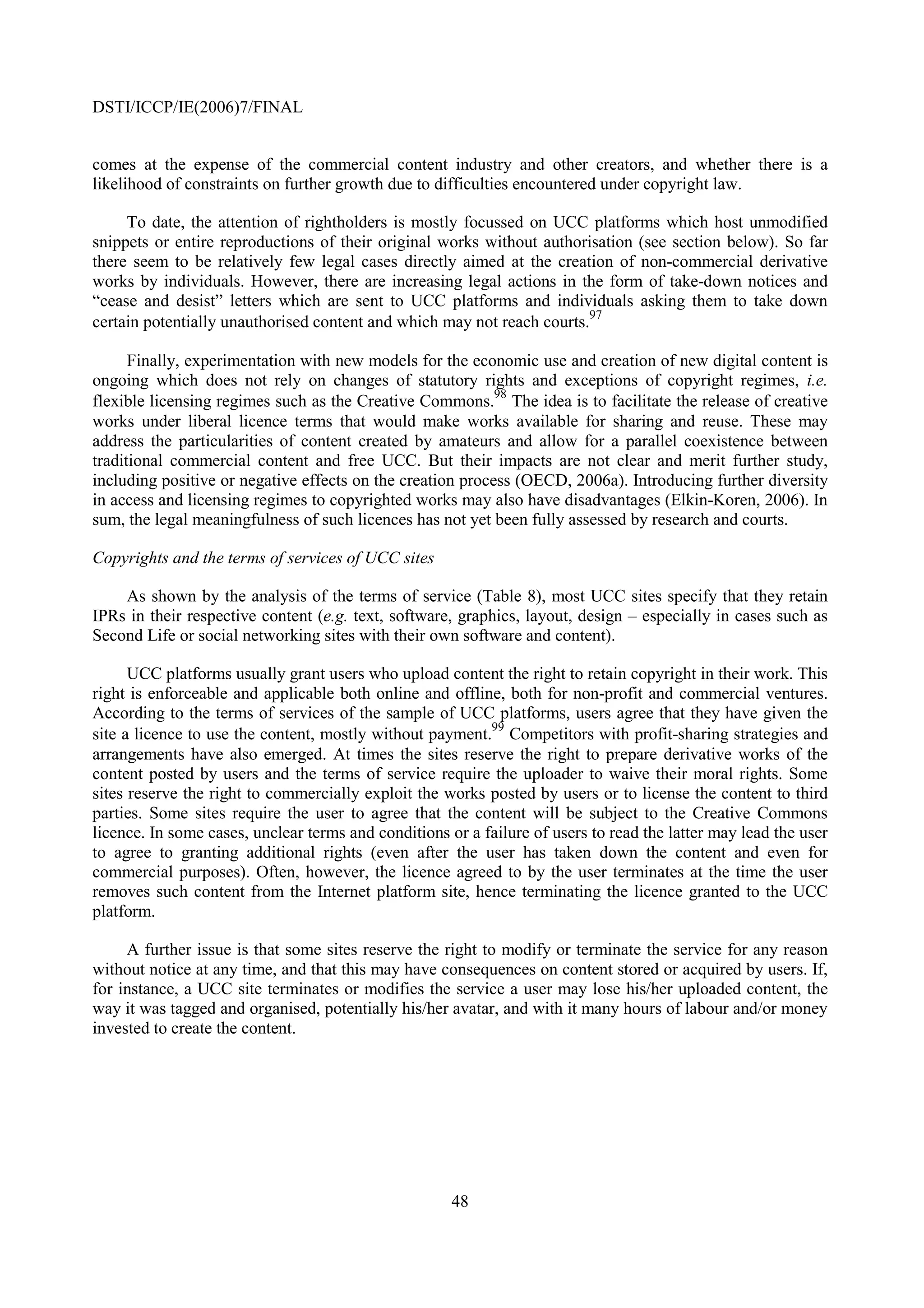
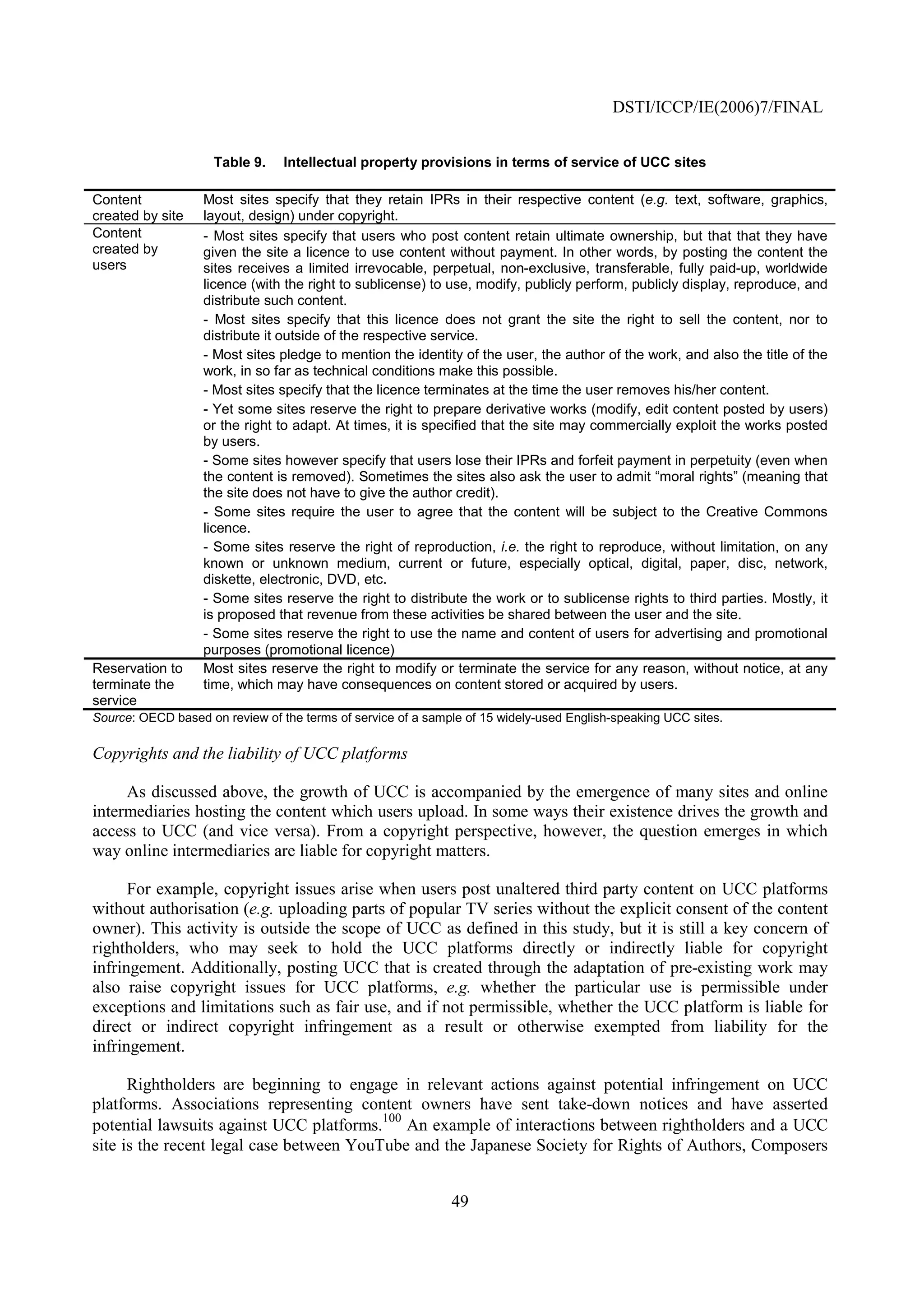


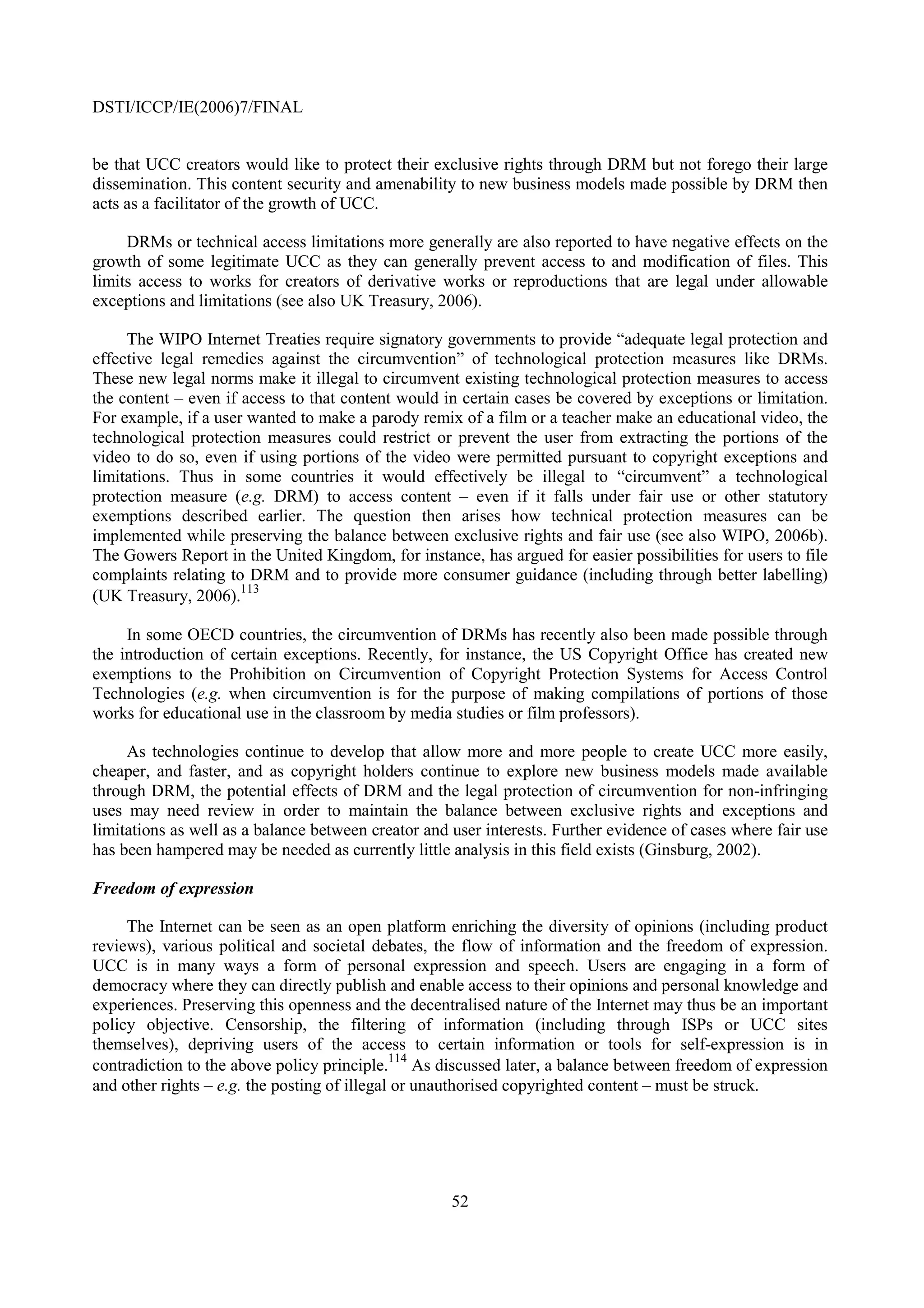
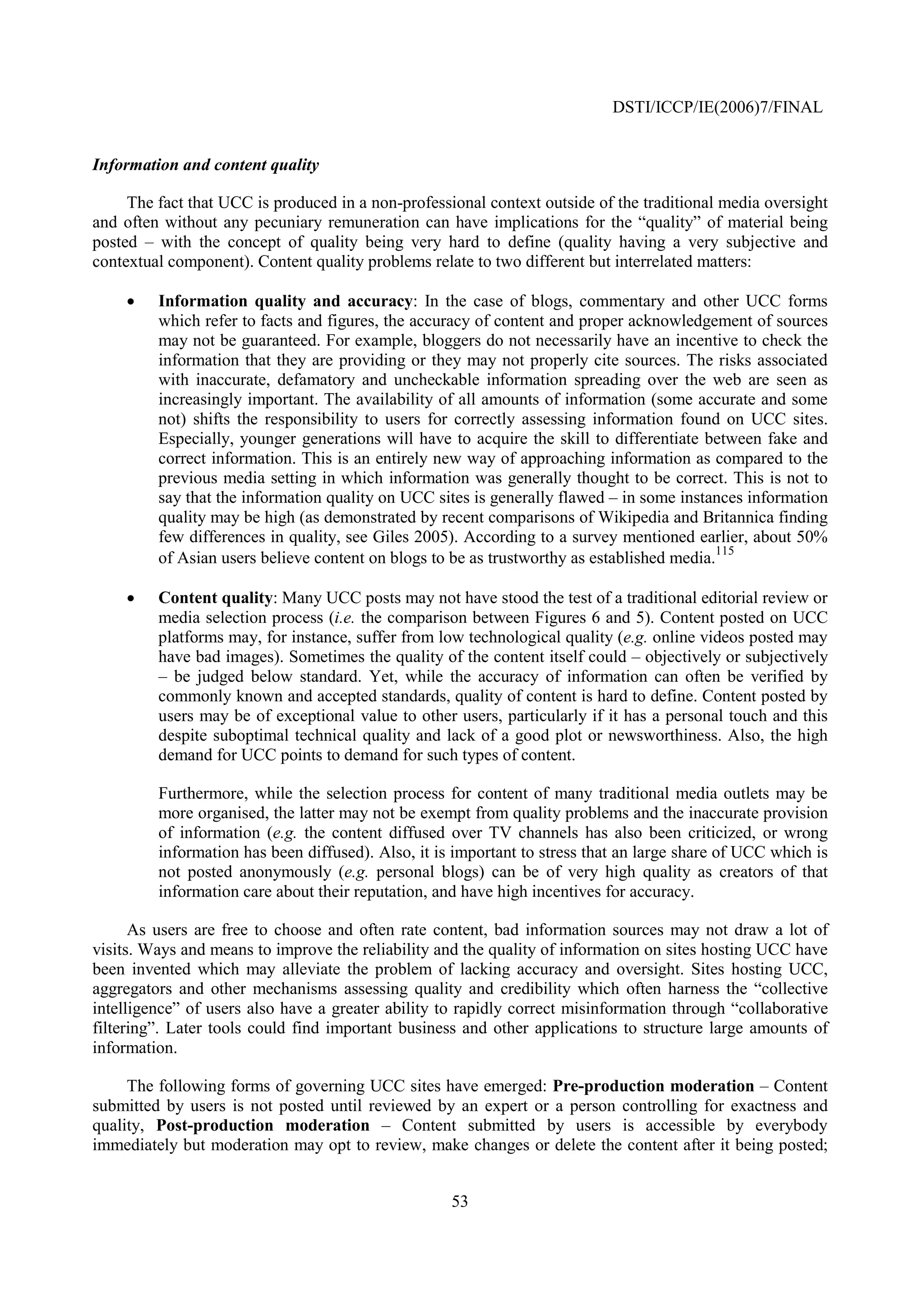
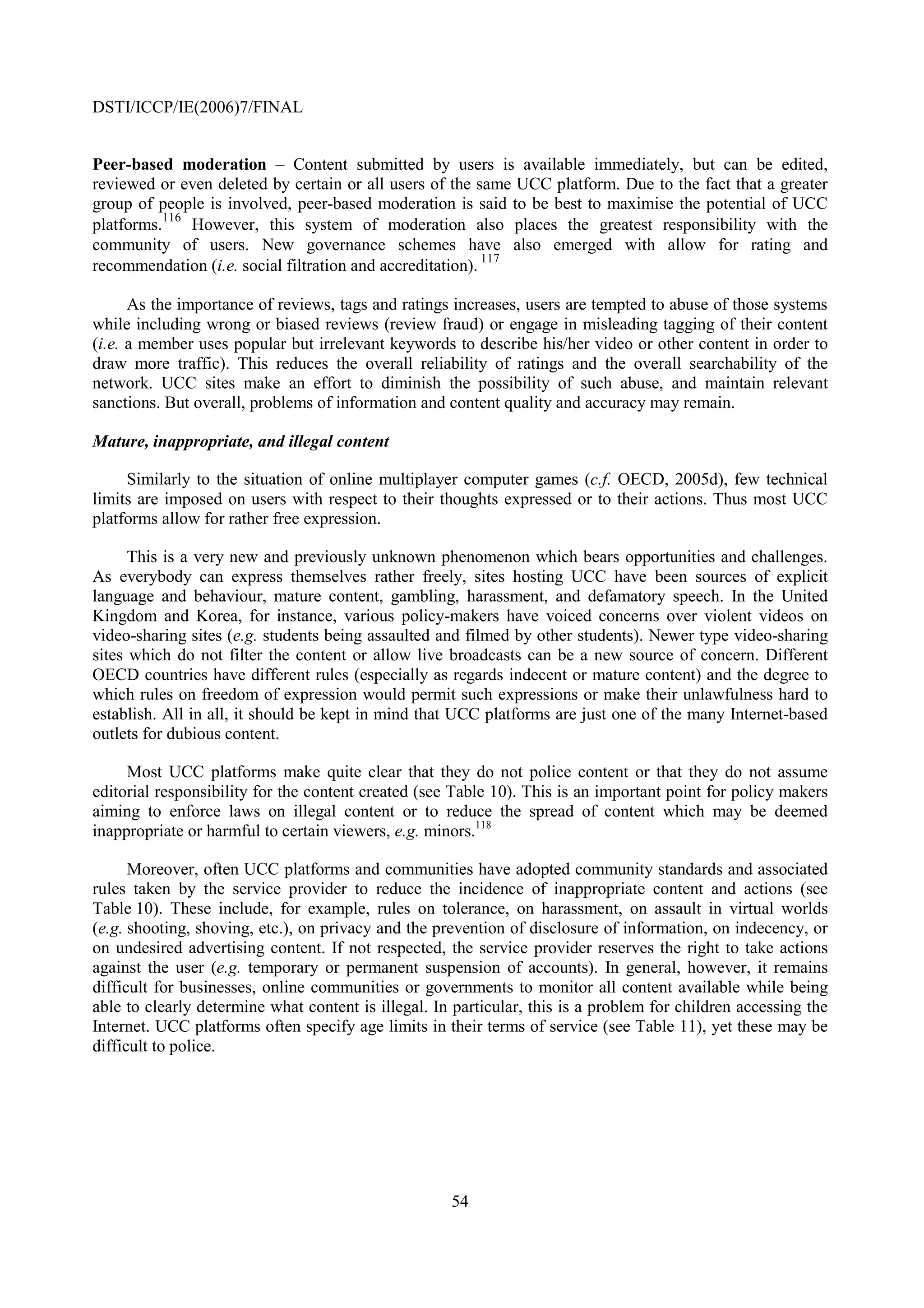
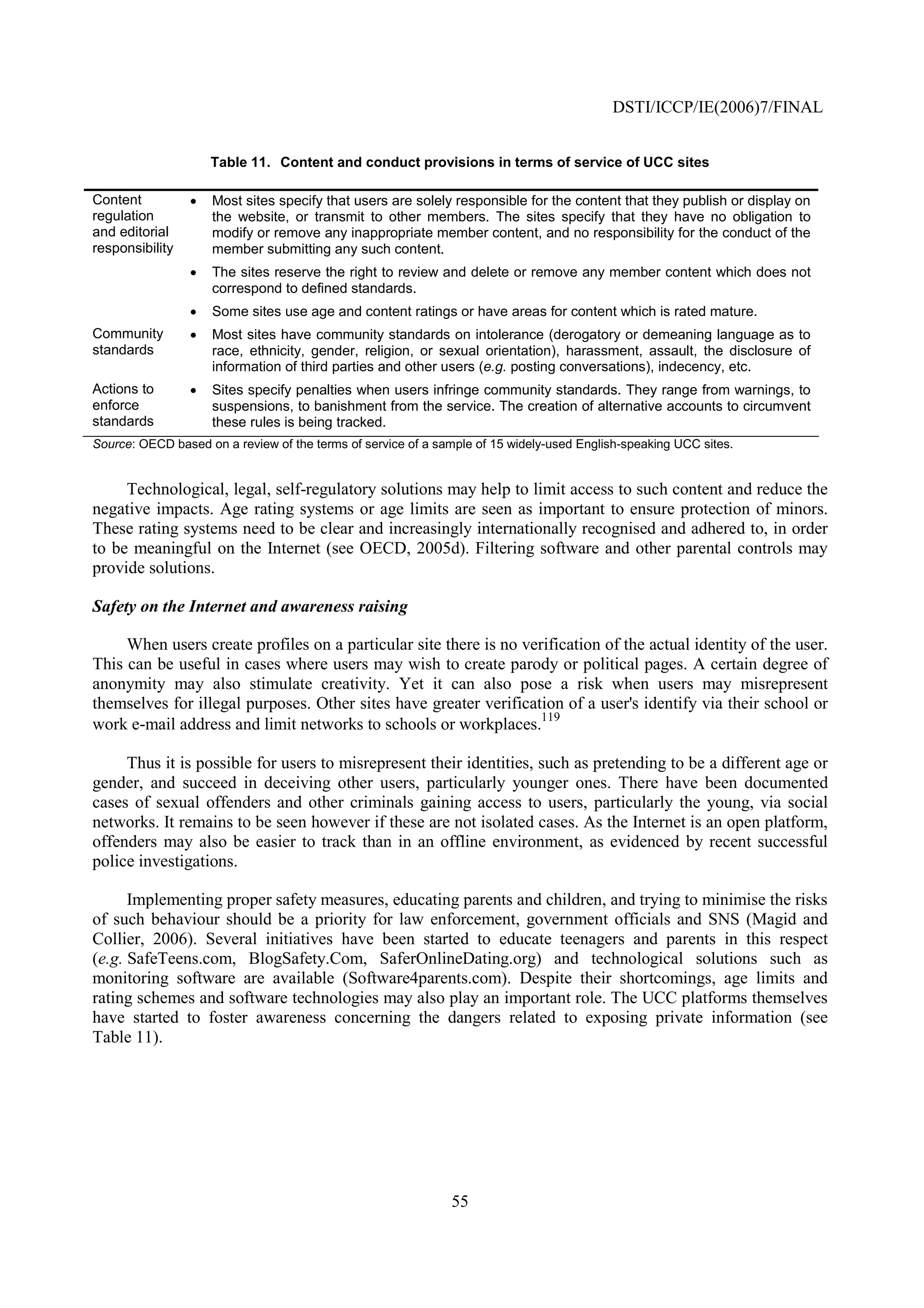
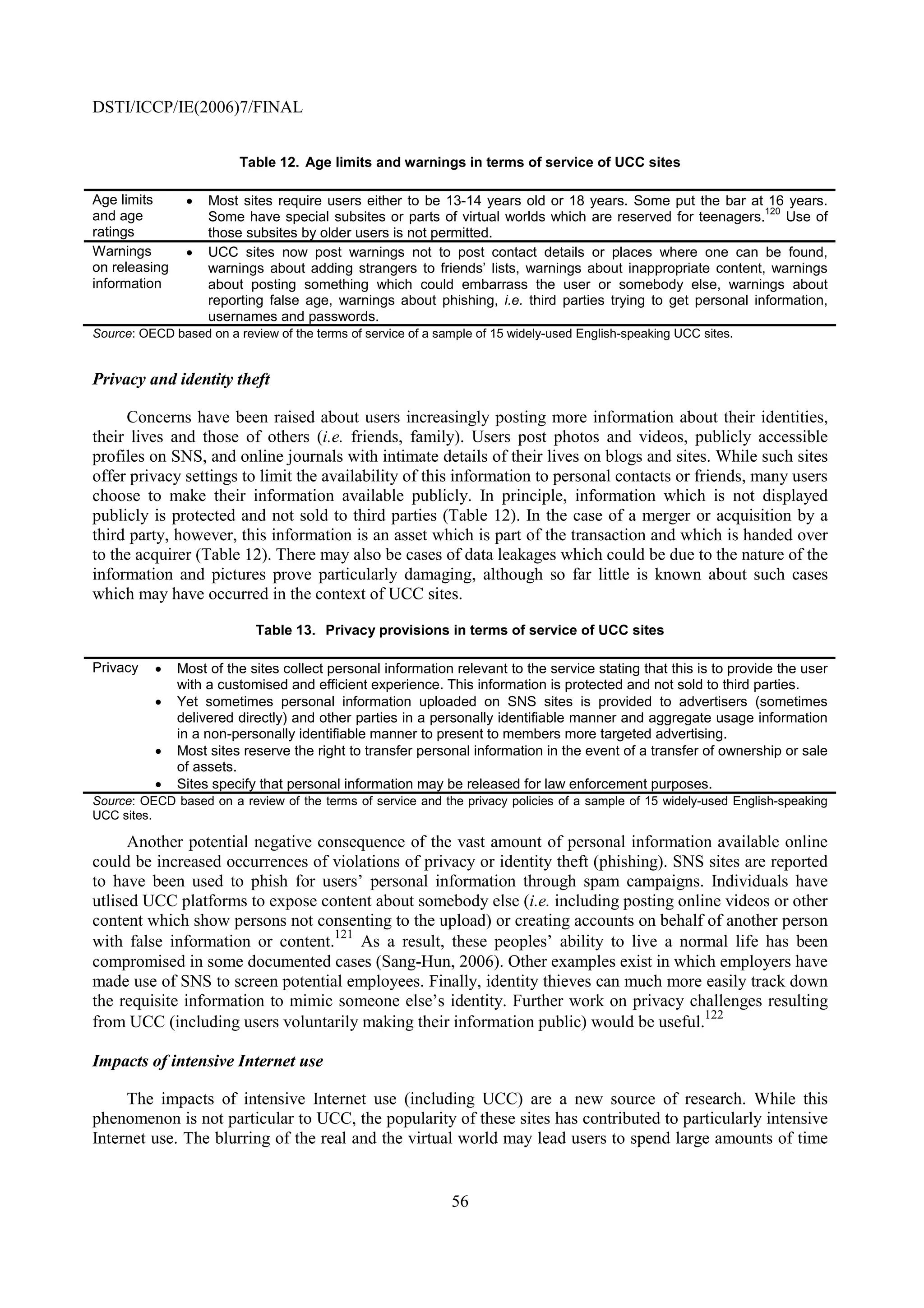
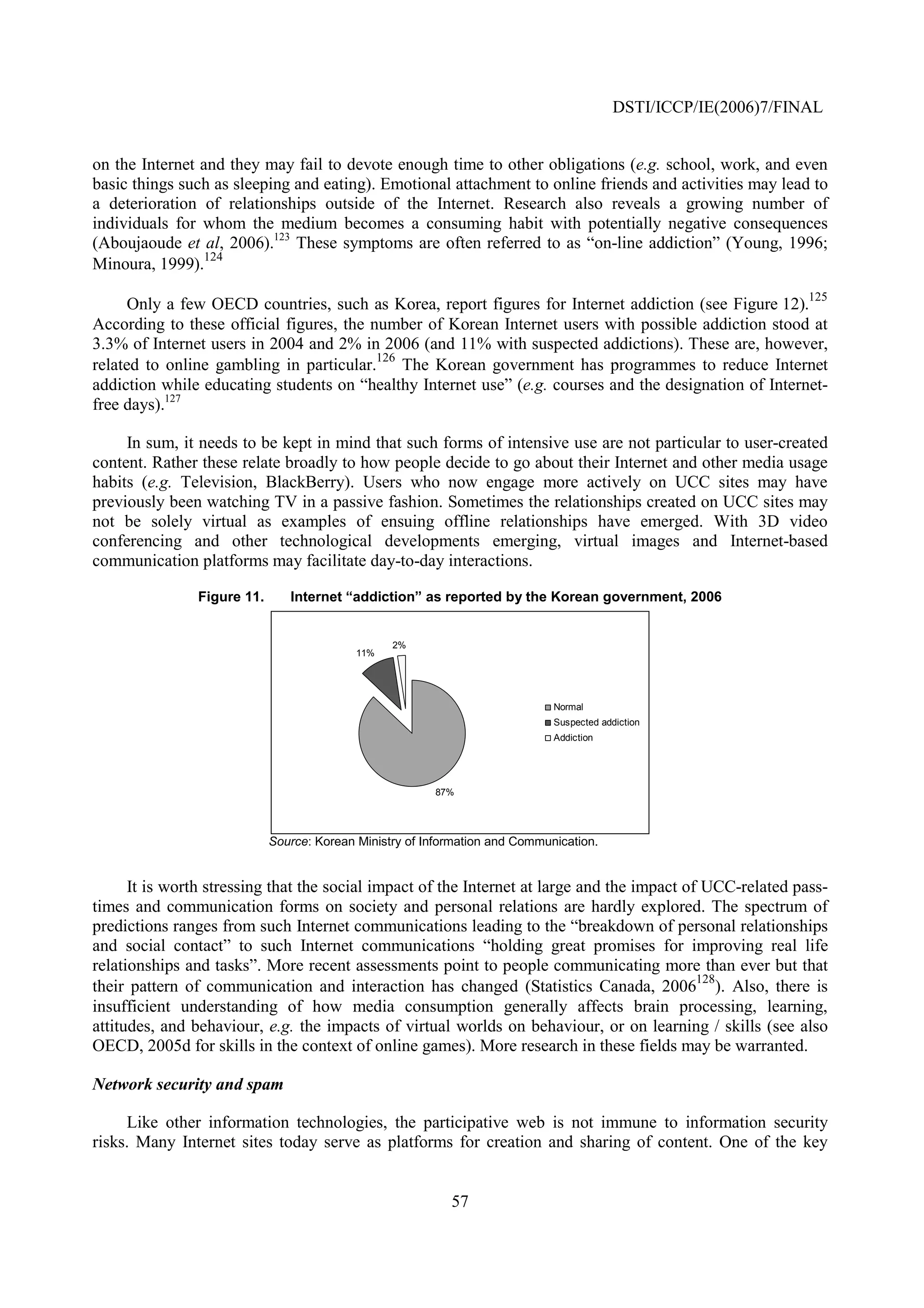
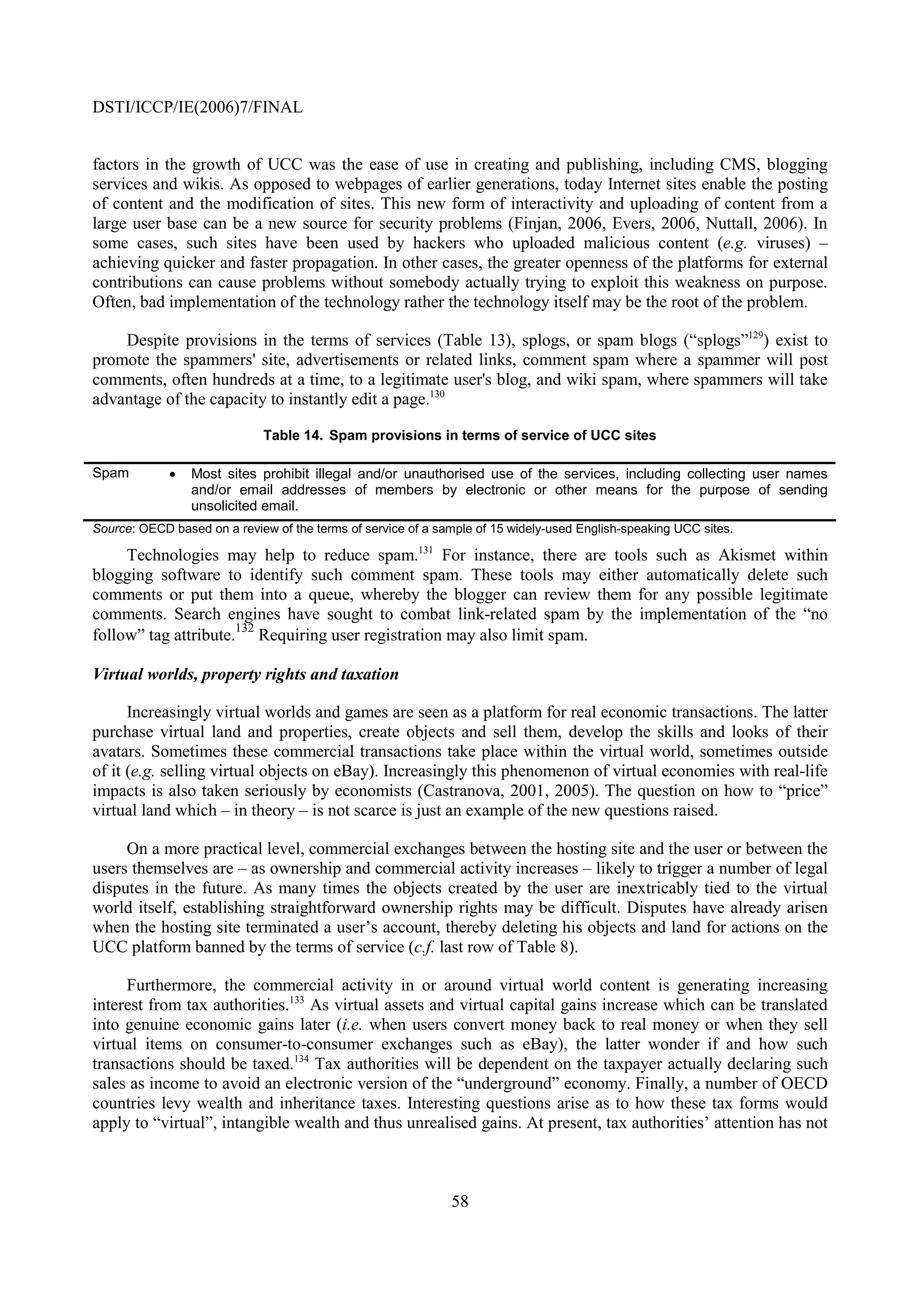

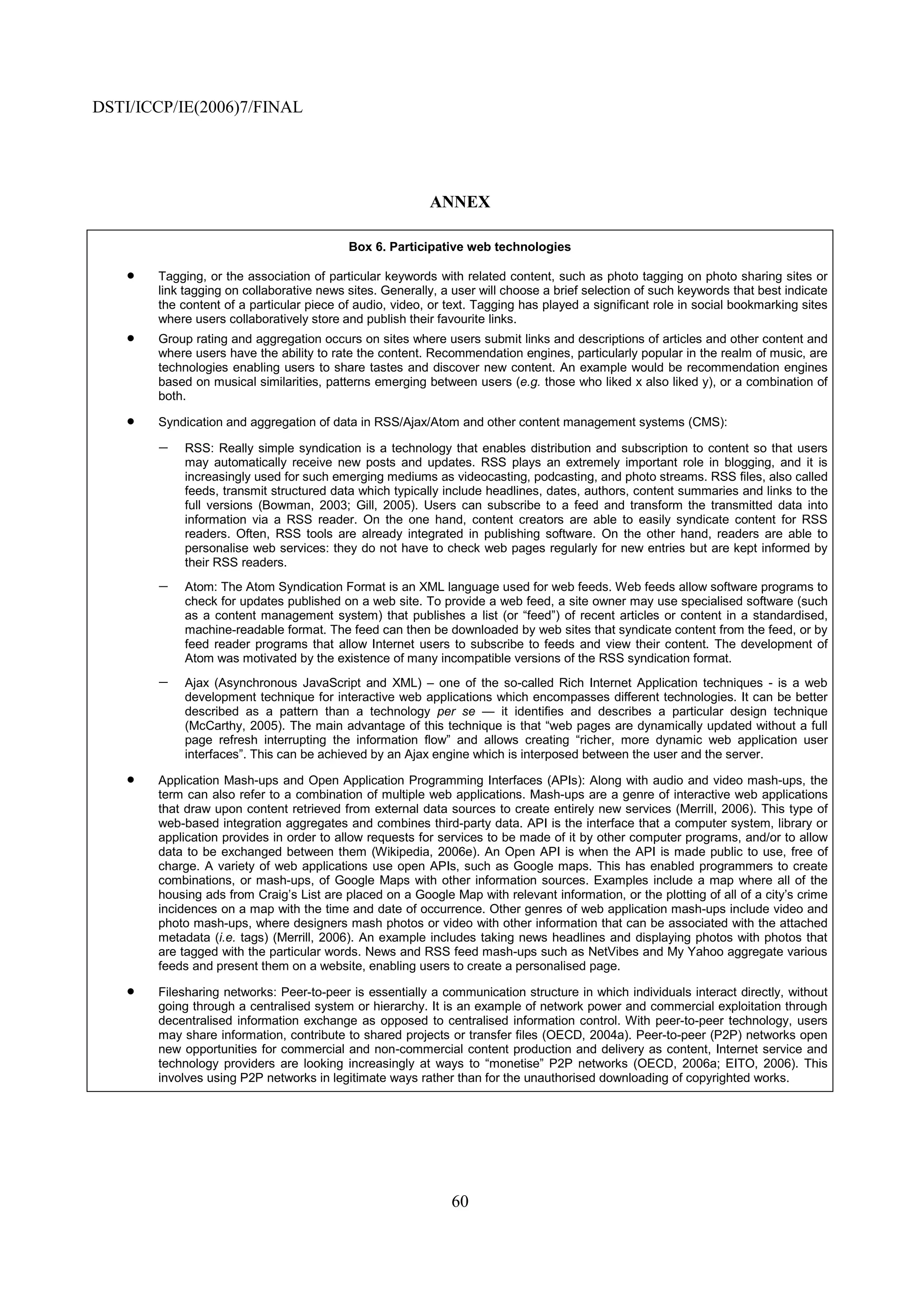
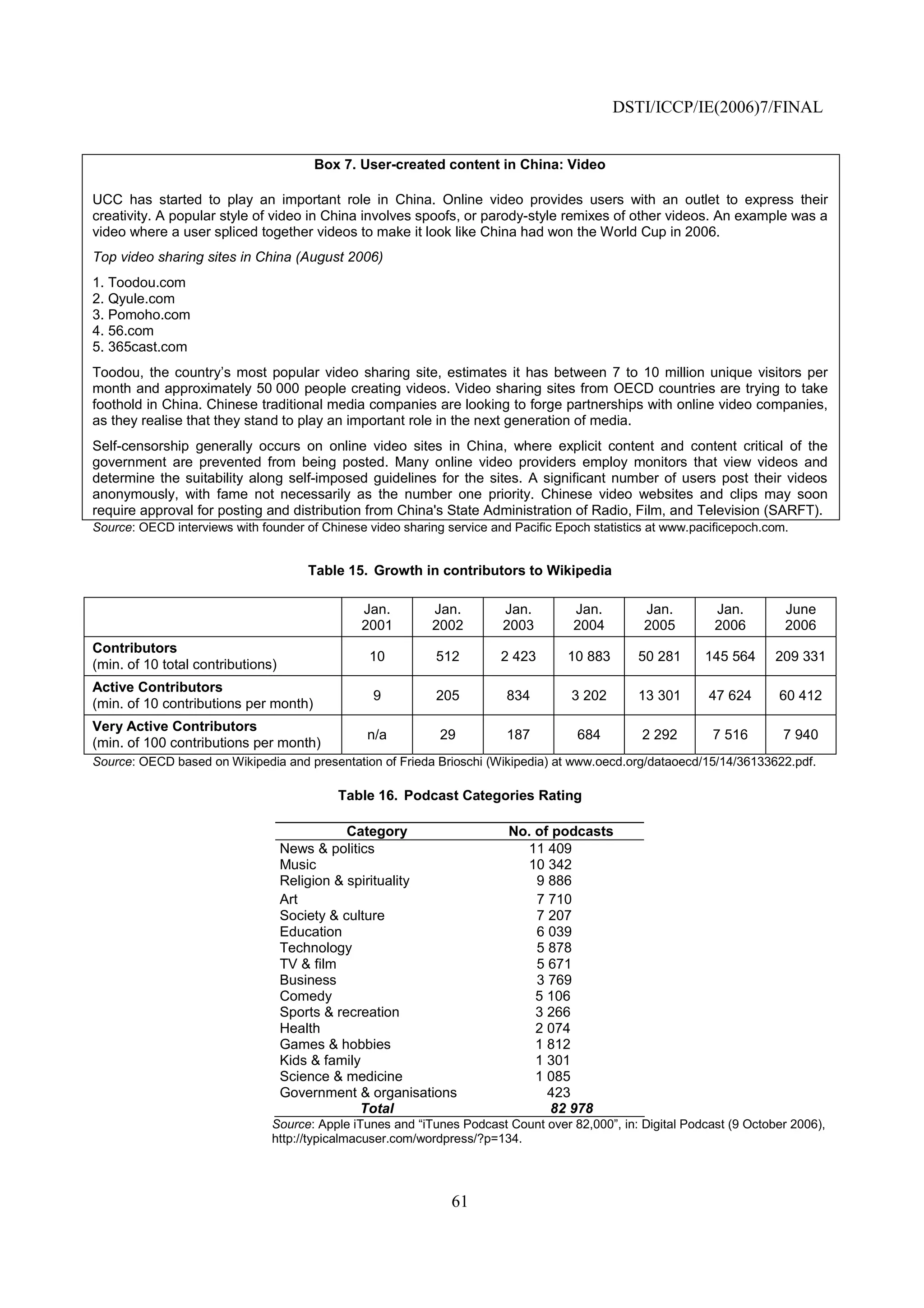
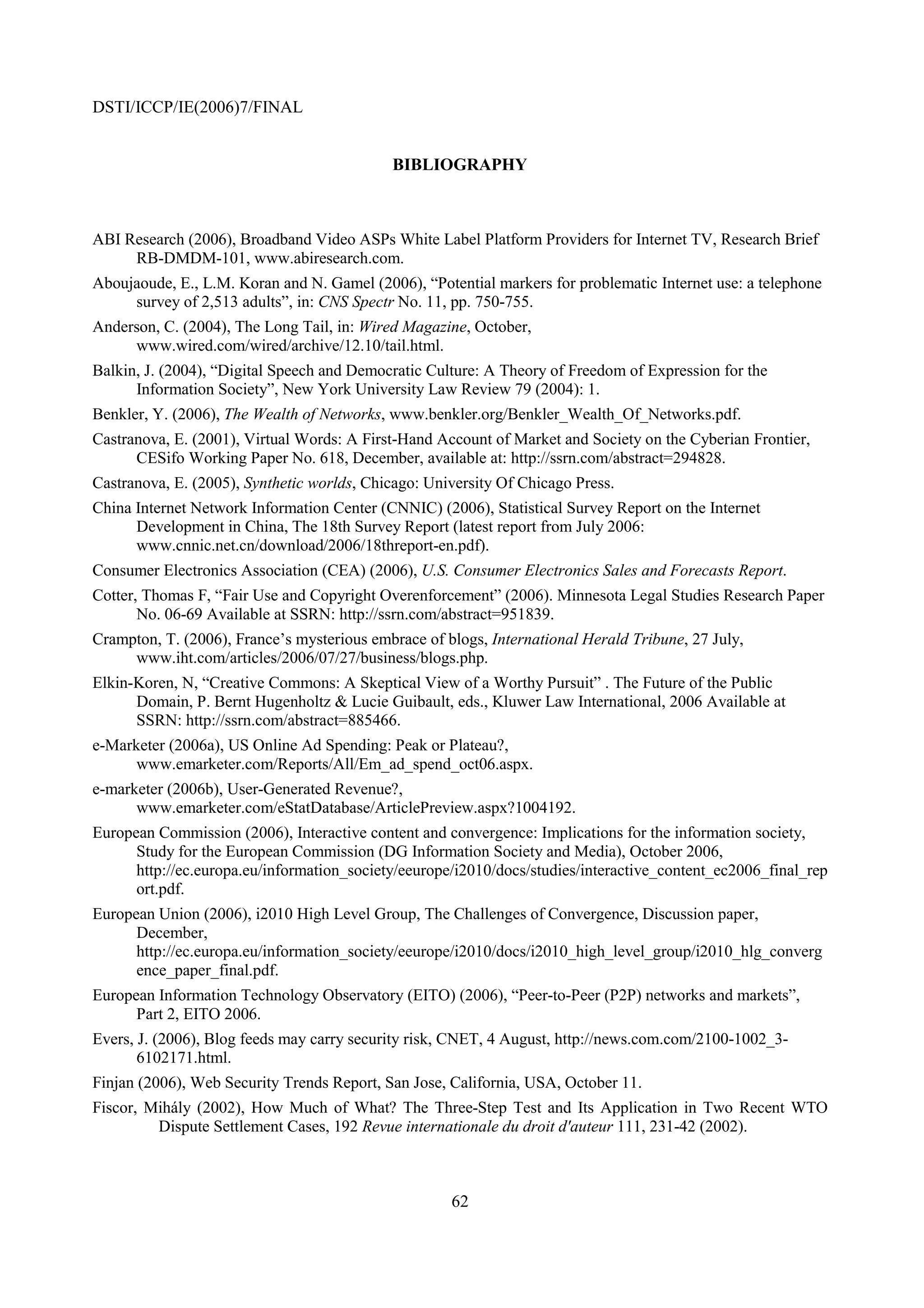
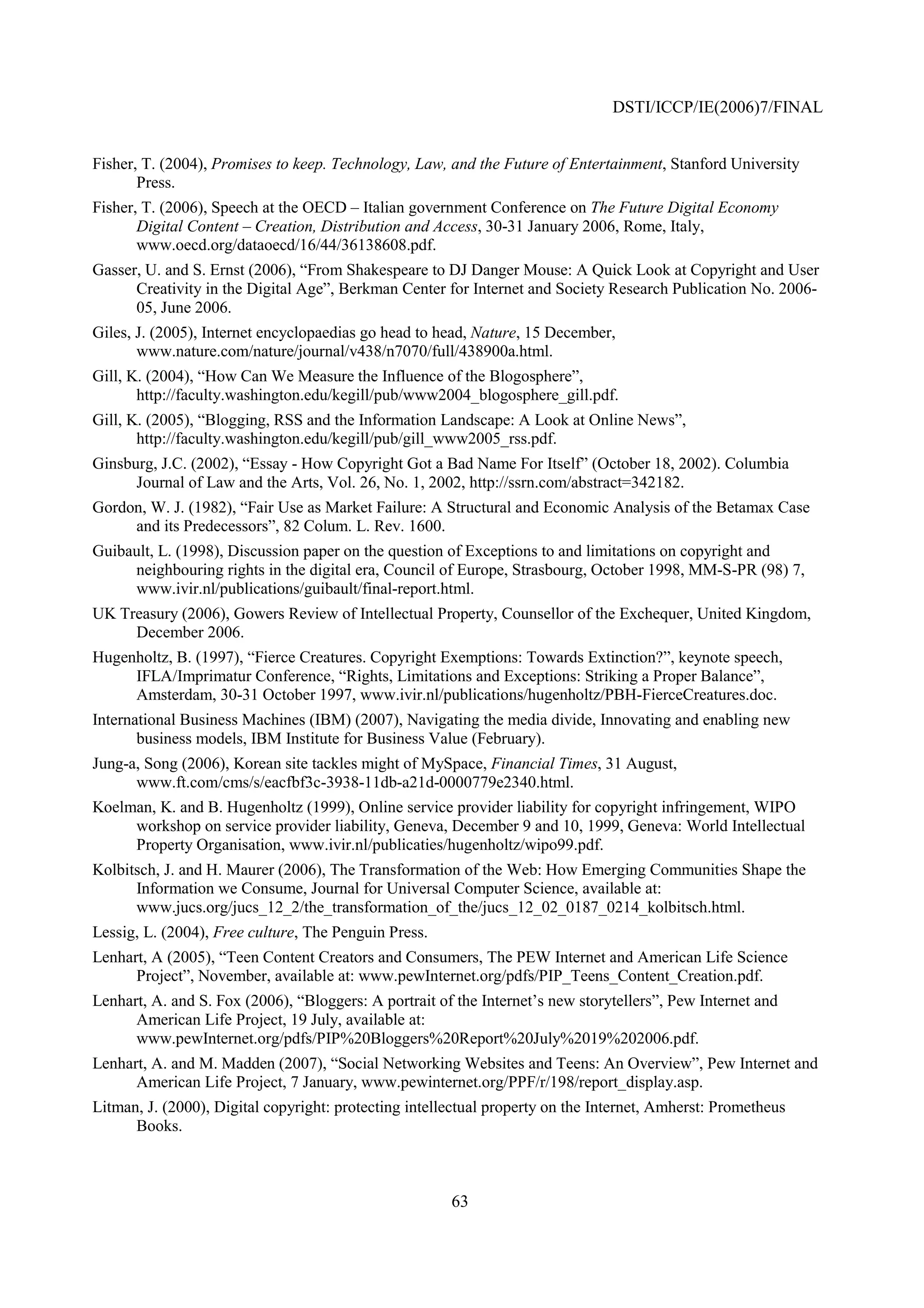
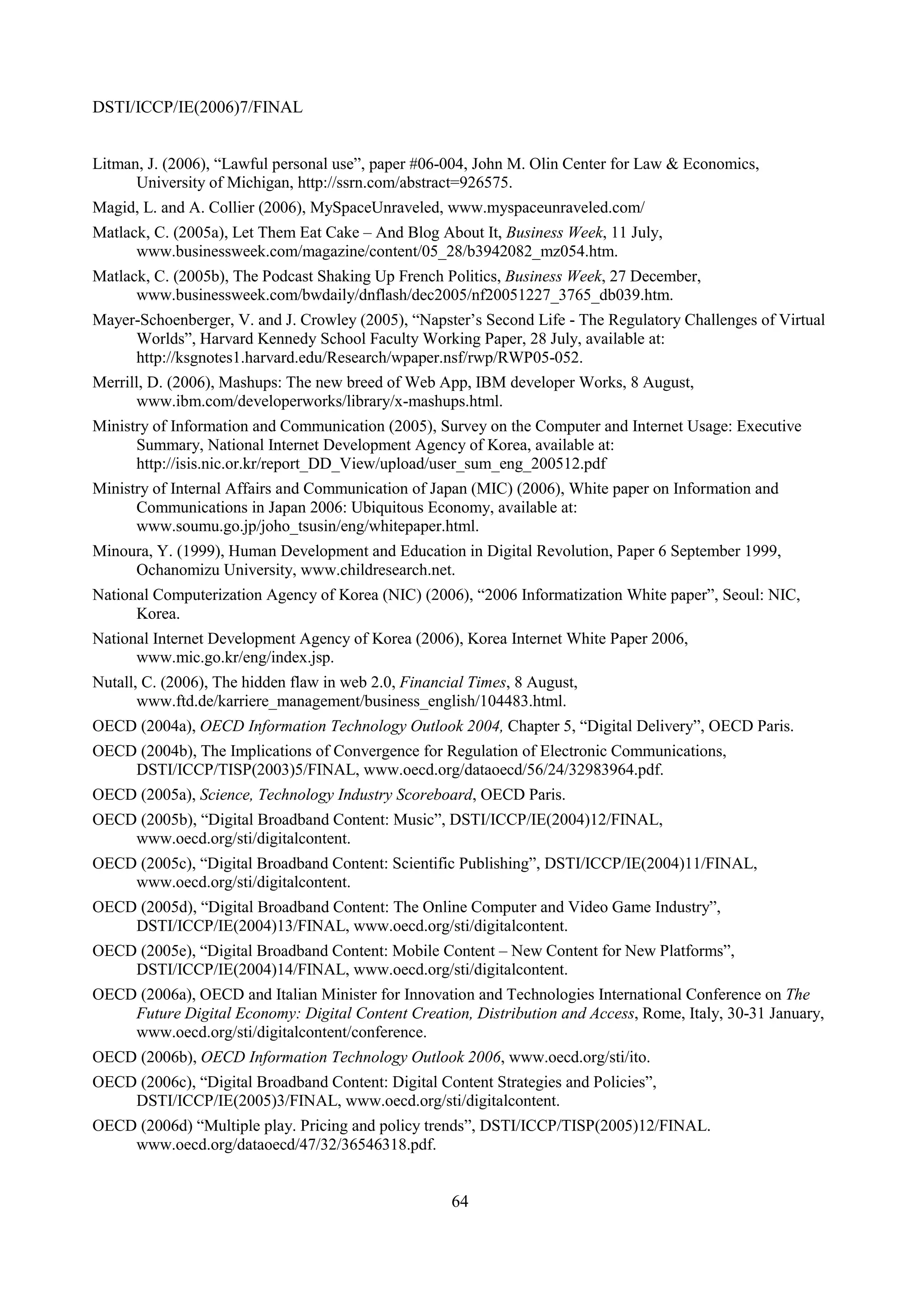
![DSTI/ICCP/IE(2006)7/FINAL
OECD (2006e), “Policy considerations for audio-visual content in a multiplatform environment”,
DSTI/ICCP/TISP(2006)3/FINAL.
OECD (2006f), “Report on Disclosure Issues Related to the Use of Copy Control and Digital Rights
Management Technologies”, www.oecd.org/dataoecd/47/31/36546422.pdf.
Ofcom (2006), The Communication Market 2006, London: Office of Communications.
O'Reilly, T. (2005), What Is Web 2.0 Design Patterns and Business Models for the Next Generation of
Software, 30 September, under :www.oreillynet.com/lpt/a/6228 and
www.oreillynet.com/pub/a/oreilly/tim/news/2005/09/30/what-is-web-20.html.
Raine, L. and M. Madden (2005), Podcasting catches on, Pew Internet, 3 April, available at:
www.pewInternet.org/pdfs/PIP_podcasting.pdf.
Regner, T., Barria, J. A., Pitt, J. and Neville, B. (2006), “Is Copyright Suitable for User-Generated Content? An
Alternative Approach”, October 2006, http://ssrn.com/abstract=936873.
Rose, K. (2006), Calcanis, 27 July, http://krose.typepad.com/kevinrose/2006/07/calacanis.html.
Sandoval, G. (2006a), Microsoft lands Facebook ad deal, CNet News.com, 22 August,
http://news.com.com/2100-1024_3-6108514.html.
Sandoval, G. (2006b), CNN Snatching Page out of You Tube’s Book, CNET News.com, 30 July 2006,
http://news.com.com/CNN+snatching+page+out+of+YouTubes+book/2100-1025_3-6100139.html.
Sang-Hun, Choe (2006), In South Korea, online rumours can hit hard, International Herald Tribune, 14 August,
www.iht.com/articles/2006/08/14/news/korea.php.Senftleben, Martin (2004), Copyright, Limitations and
the Three-Step Test - An Analysis of the Three-Step Test in International and EC Copyright Law, The
Hague/London/New York: Kluwer Law International.
Shimo, A. (2006), Living it up in a parallel world, Globe and Mail, 29 July,
www.theglobeandmail.com/servlet/story/LAC.20060729.SECOND29/TPStory/Entertainment.
Sifry, D. (2006a), State of the Blogosphere April 2006, 17 April, www.sifry.com/alerts/archives/000432.html.
Sifry, D. (2006b), State of the Blogosphere August 2006, 7 August,
www.sifry.com/alerts/archives/000436.html.
Statistics Canada. (2006), Our Lives in Digital Times, by George Sciadas, Science, Innovation and Electronic
Information Division (SIEID) www.statcan.ca/english/research/56F0004MIE/56F0004MIE2006014.pdf.
Van Duyn, A. (2006), Web ads sector lacks experienced staff, Financial Times, 29 August,
www.ft.com/cms/s/e2a439cc-378b-11db-bc01-0000779e2340.html.
Van Duyn A. and R. Waters (2006), Google in $900m ad deal with MySpace, Financial Times, 7 August,
www.ft.com/cms/s/17e8e67e-2660-11db-afa1-0000779e2340.html.
Von Hippel, E. (2005), Democratizing Innovation, London: MIT Press.
VTT Technical Research Centre of Finland (2007), Googlen mainokset ja muita sosiaalisen median
liiketoimintamalleja ["Ads by Google" and other social media business models], Espoo 2007, Kangas,
Petteri, Toivonen, Santtu & Bäck, Asta (ed.), Research Notes 2369, www.vtt.fi/publications/index.jsp.
Wikipedia (2006), Wikipedia Statistics, http://stats.wikimedia.org/EN/Sitemap.htm, accessed 31 July 2006.
WIPO (2003), WIPO Study on limitations and exceptions of copyright and related rights in the digital
environment, Standing Committee on Copyright and Related Rights, Ninth Session, Geneva: World
Intellectual Property Organisation, June 23 to 27, 2003, prepared by Mr. Sam Ricketson.
WIPO (2004), WIPO Study on Current Developments in the Field of Digital Rights Management”, prepared by
Jeffrey P. Cunard, Keith Hill and Chris Barlas (SCCR/10/2.Rev., May 2004).
WIPO (2005), “Online Intermediaries and Liability for Copyright Infringement”, WIPO Paper prepared by
Charlotte Waelde and Lilian Edwards, for a WIPO Seminar on Copyright and Internet Intermediaries,
Geneva, April 18, 2005, www.wipo.int/meetings/2005/wipo_iis/en/.
65](https://image.slidesharecdn.com/participativewebusercreatedcontentoecdapril2007-100528121116-phpapp02/75/Participative-web-user-created-content-oecd-april-2007-65-2048.jpg)

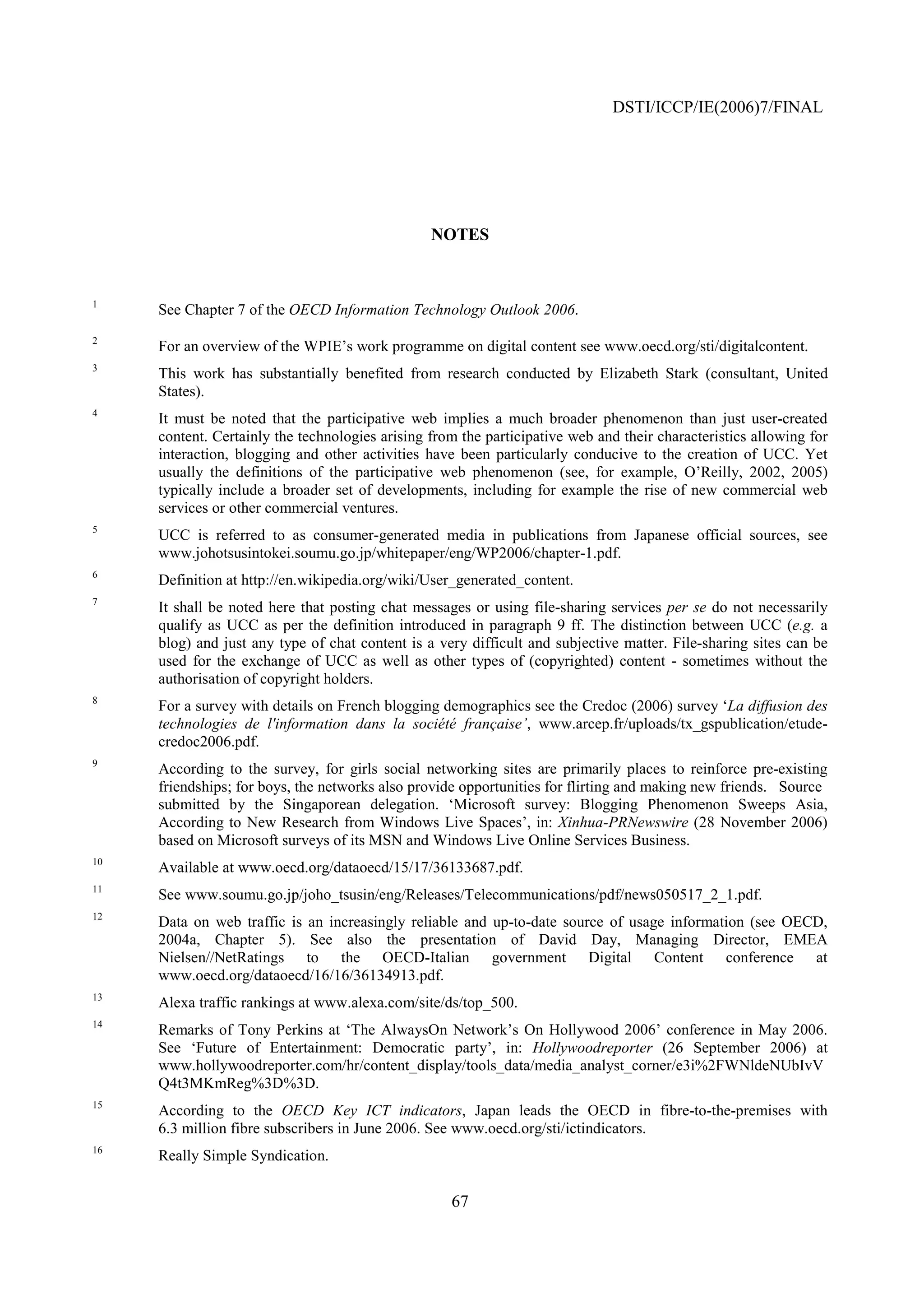
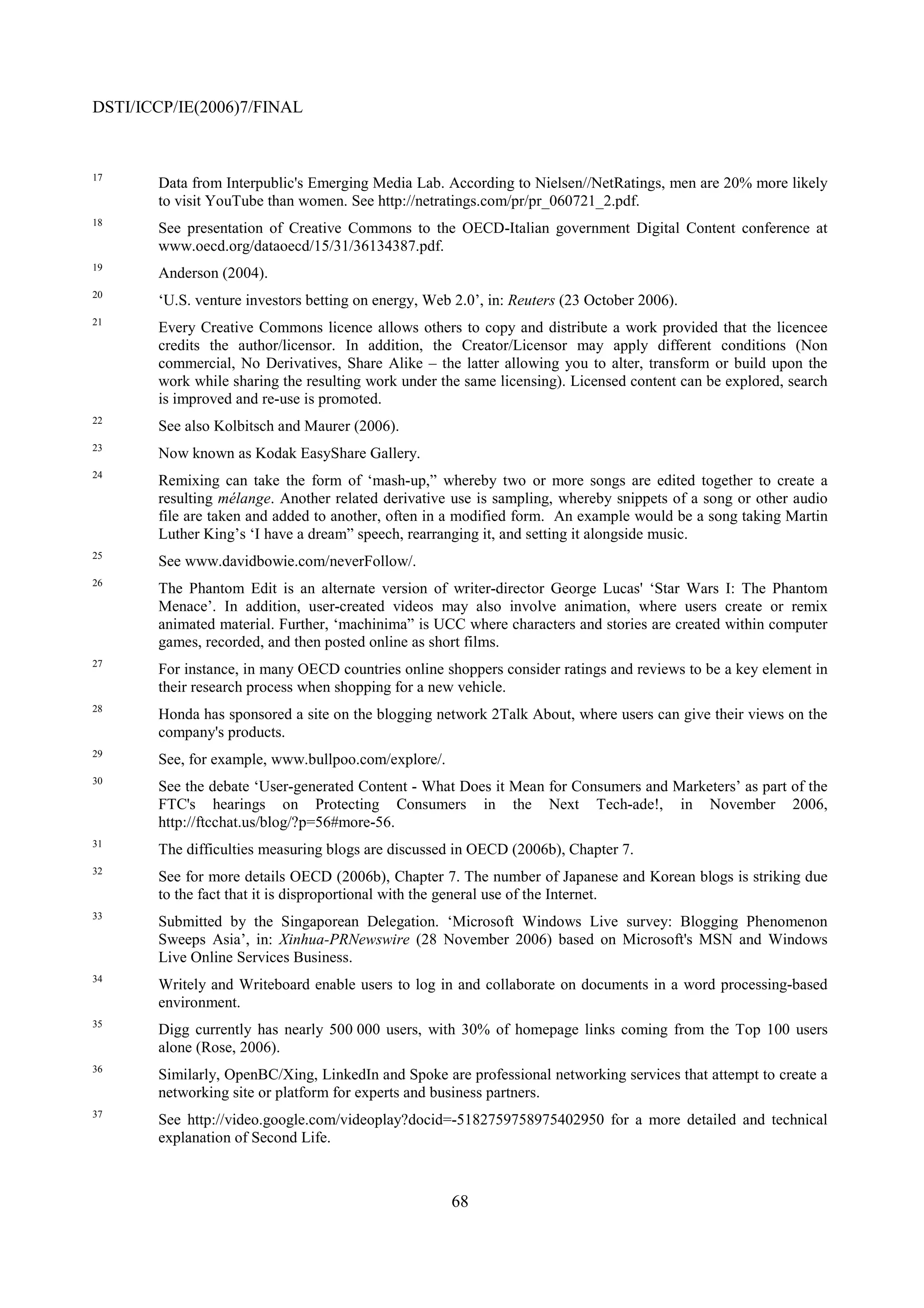
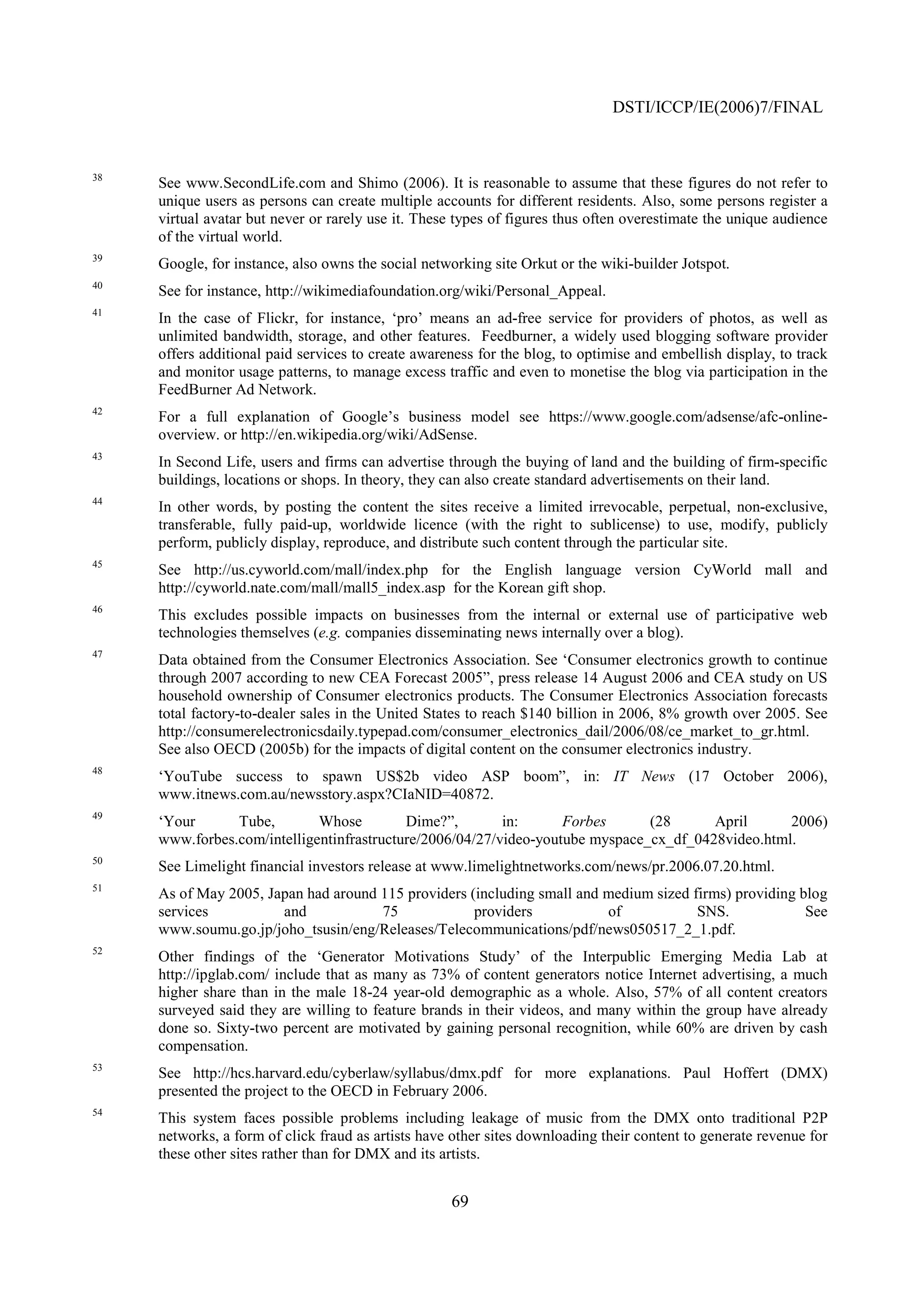
![DSTI/ICCP/IE(2006)7/FINAL
55
This model, however, requires that a user must be online while viewing the content to generate
advertisement revenue. It does not work well for videos that are downloaded and then viewed later offline
or on a portable audio/video player.
56
The International Herald Tribune, for instance, signed a deal in May 2006 to syndicate content from the
Korean citizen journalism site OhmyNews.
57
‘Korea: SK Com. to launch new search engine”, in: Korea Times (23 October 2006).
58
See http://dovecreamoil.com/.
59
Budweiser, for instance, allows users to put words in the mouth of celebrities or animals to send as
postcards. See http://veepers.budweiser.com/service/Start.
60
Examples are the folk singer Sandi Thom and Artic Monkeys.
61
Coca-Cola and iTunes have recently announced a webpage to foster young musical talent (upcoming artists
can send their music to a selection committee for airing).
62
See www.desiresdavenir.org/. Socialist candidate Ségolène Royal made her website a vital part of her
campaign, practicing what she calls ‘participative democracy.’
63
See http://blog-ump.typepad.fr/.
64
See www.loiclemeur.com/english/2005/12/nicolas_sarkozy.html.
65
Collaborative educational initiatives such as MIT OpenCourseWare are providing opportunities for
educators and students alike to make use of these resources and improve the overall level of education. The
University Channel podcast – a project of Princeton University - makes videos of academic lectures
available.
66
See on the changing role played by broadcasters in shaping politics and the democratic process, the
ongoing conferences and seminars. ‘Beyond Broadcast 2006: Reinventing Public Media in a Participatory
Culture’ held at Harvard Law School on February 24, see http://cms.mit.edu/.
67
The analysis is based on analysis of the terms of service and the Privacy Policy of the following sample of
15 widely- and internationally-used UCC sites: Flickr, Ofoto, BoingBoing, Digg, del.icio.us, Bebo's,
Cyworld, Face Book, Friendster, MySpace, orkut, Daily Motion, Google Video, You tube and Second Life.
The tables are a generalisation of the terms of services of these sites. Other UCC sites (especially non-
English-speaking ones) may have different terms of service. Terms of services vary according to local legal
frameworks and local cultures.
68
The final provision of the OECD Council Recommendation on Broadband Development is the
‘[e]ncouragement of research and development in the field of ICT for the development of broadband and
enhancement of its economic, social and cultural effectiveness”.
69
See also the OECD-BIAC Workshop on Future of Online Audiovisual Services, Film and Video: Issues for
Achieving Growth and Policy Objectives, September 29, 2006, Summary, DSTI/ICCP/CISP/IE(2006)2,
www.oecd.org/dataoecd/33/42/37866987.pdf.
70
See also related comments and suggestions by the UK regulator OFCOM supporting that audiences be able
to re-use content, at http://www.ofcom.org.uk/media/news/2007/01/nr_20070124a.
71
See also the OECD Council Recommendation on Broadband Development at
www.oecd.org/dataoecd/31/38/29892925.pdf.
72
Finally, regulators will have to monitor whether their current approaches for guaranteeing competition in
the telecommunication market will be adequate for new NGN environments. See the OECD NGN
Forumwww.oecd.org/document/12/0,2340,en_2649_34223_37392780_1_1_1_1,00.html.
73
This technological choice is based on the historical Internet use patterns which did not show a great need
for upload capacity at the user-level.
70](https://image.slidesharecdn.com/participativewebusercreatedcontentoecdapril2007-100528121116-phpapp02/75/Participative-web-user-created-content-oecd-april-2007-70-2048.jpg)
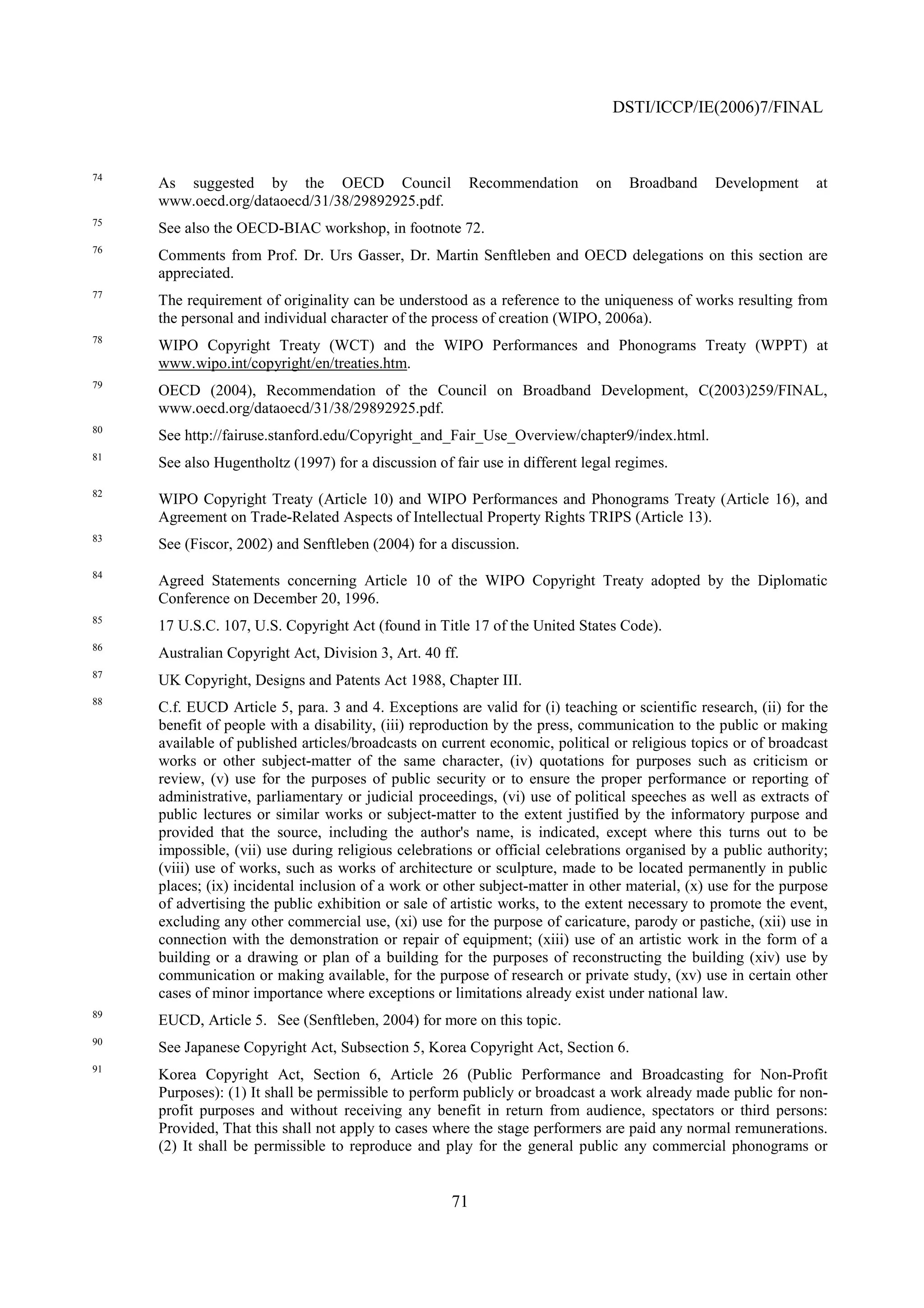
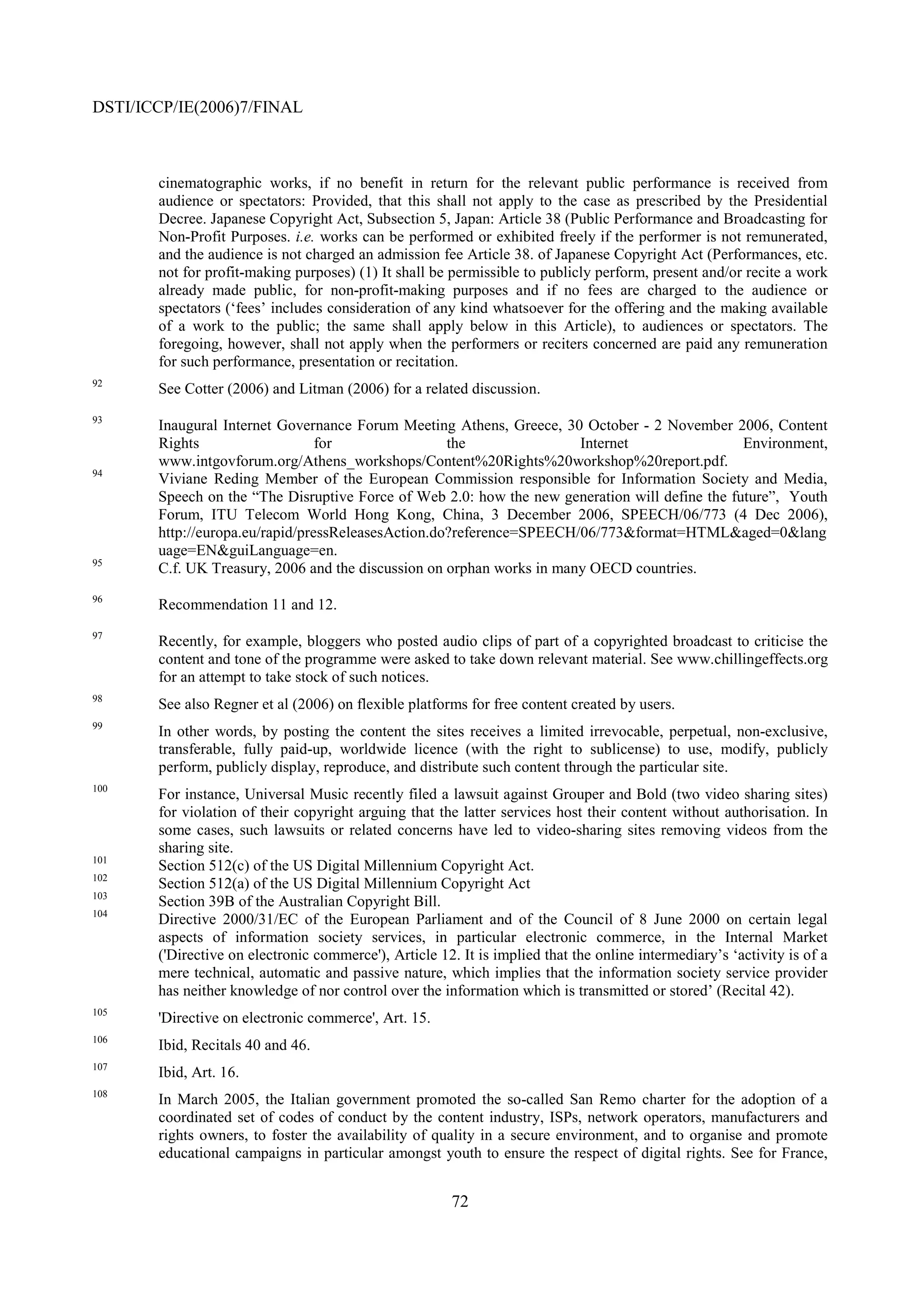
![DSTI/ICCP/IE(2006)7/FINAL
the Charte d’engagements pour le développement de l’offre légale de musique en ligne, le respect de la
propriété intellectuelle et la lutte contre la piraterie numérique,
www.culture.gouv.fr/culture/actualites/conferen/donnedieu/charte280704.htm. For the EU level see the
European Charter for Film Online at:
http://ec.europa.eu/comm/avpolicy/docs/other_actions/film_online_en.pdf.
109
See for an example of such take down notice procedures for a user-created content site:
http://secondlife.com/corporate/dmca.php.
110
United States Supreme Court Decision in MGM Studios, Inc. v. Grokster, Ltd. 545 U.S. 913 (2005) at
http://caselaw.lp.findlaw.com/cgi-bin/getcase.pl?court=US&navby=case&vol=000&invol=04-480.
111
C.f. WIPO (2005).
112
See http://blogs.law.harvard.edu/palfrey/2007/02/02/viacoms-cease-and-desist-letters-for-a-home-video/.
113
Recommendation 15 and 16.
114
The Geneva Declaration of Principles and the Tunis Commitments of the World Summit on the
Information Society refer to and underline the importance of freedom of expression and the free flow of
information, ideas and knowledge. The identification of the appropriate enabling legal, policy and
regulatory frameworks that preserve openness as one of the key founding principles of the Internet may be
strived for.
115
Submitted by the Singaporean delegation. ‘Microsoft survey: Blogging Phenomenon Sweeps Asia,
According to New Research from Windows Live Spaces’, in: Xinhua-PRNewswire (28 November 2006)
based on Microsoft surveys of its MSN and Windows Live Online Services Business.
116
For instance, this is also the form chosen by Wikipedia.
117
See Kolbitsch and Maurer (2006).
118
Debated in the context of the revision of the UK Violent Crime Reduction Bill. See Move to ban happy-
slapping on the web, The Guardian (21 October 2006).
119
Even this is not perfect, though, as one could obtain access to such an address and start a profile.
120
Certain user-created content services have also implemented special zones for underage users (e.g. Teen
grid for 13-17 year olds in Second Life).
121
In Korea, the posting of pictures and videos concerning the behaviour of some persons has led to a form of
‘public shaming’.
122
See www.oecd.org/sti/security-privacy for OECD work on privacy and ICT security.
123
Since the early 1990s, several clinics have been established in the United States to treat heavy Internet
users. They include the Center for Internet Addiction Recovery, in Bradford, Pa., and the Connecticut-
based Center for Internet Behavior.
124
These have also been discussed in the context of online games in OECD (2005d).
125
‘Developing teaching curriculum to disseminate a sound Internet culture”, Korea Herald (15 September
2006), www.asiamedia.ucla.edu/article-eastasia.asp?parentid=5298.
126
Survey of 3 000 Internet users. See:
www.itu.int/wsis/stocktaking/scripts/documents.asp?project=1120746255&lang=en.
127
See Republic of Korea - Ministry of Information and Communication (MIC) Activity: The Center for
Internet Addiction Prevention and Counselling:
www.itu.int/wsis/stocktaking/scripts/documents.asp?project=1120746255&lang=en and
www.asiamedia.ucla.edu/article-eastasia.asp?parentid=52984.
128
Statistics Canada (2006) notes that, ‘[t]hus, it is not that people are becoming anti-social; it is that people
are becoming differently social.’
73](https://image.slidesharecdn.com/participativewebusercreatedcontentoecdapril2007-100528121116-phpapp02/75/Participative-web-user-created-content-oecd-april-2007-73-2048.jpg)
